Childcare Program Planning and Report Writing
VerifiedAdded on 2020/03/07
|64
|10336
|97
AI Summary
This assignment requires students to develop individualized childcare programs for three children based on interviews, observations, and their needs. The program should outline planned activities, necessary materials and equipment, and interactions between children and staff. Students also need to write a comprehensive report summarizing their findings for each child, including interview summaries, observational notes, key findings, and recommendations.
Contribute Materials
Your contribution can guide someone’s learning journey. Share your
documents today.
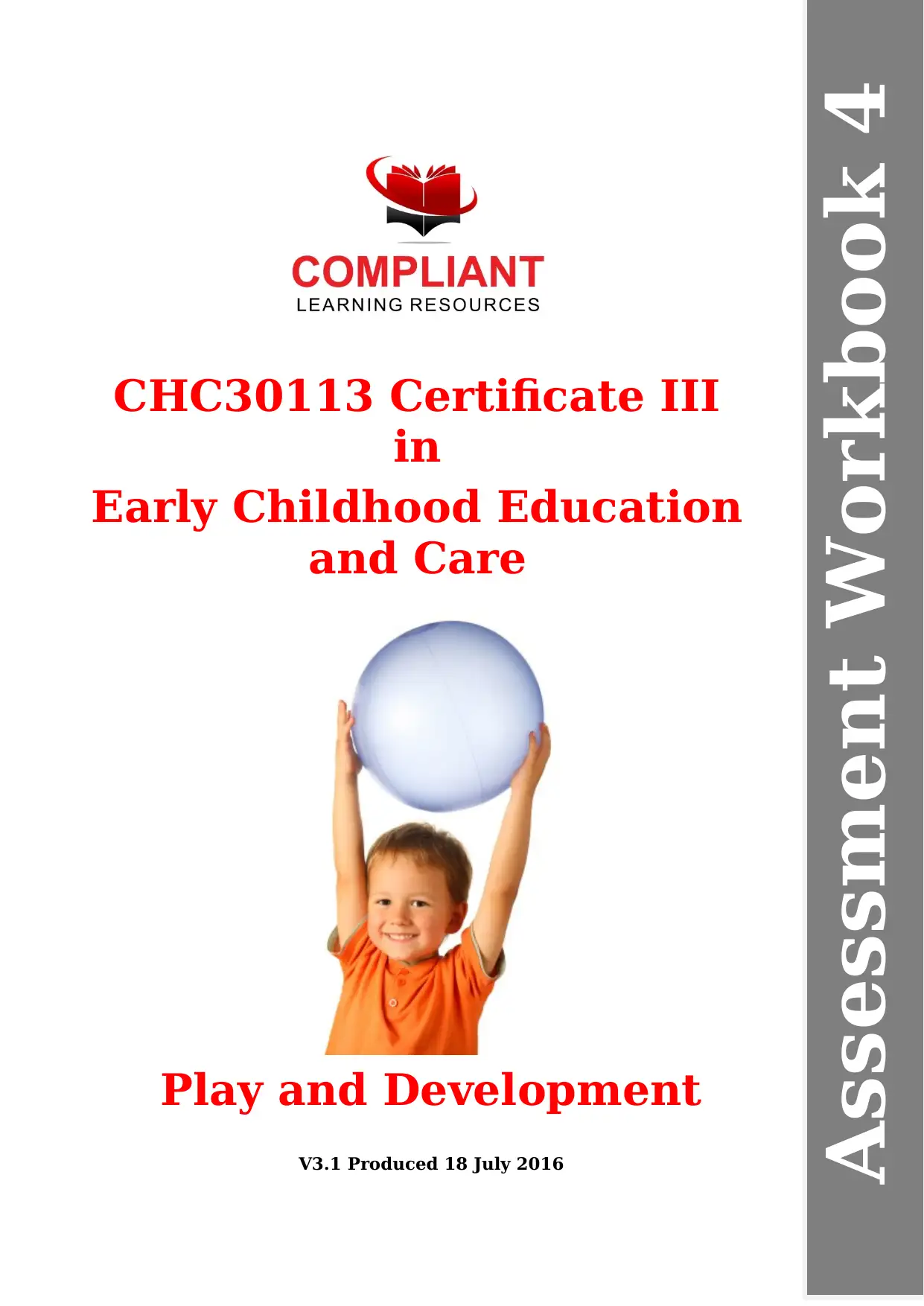
CHC30113 Certificate III
in
Early Childhood Education
and Care
Play and Development
V3.1 Produced 18 July 2016
Assessment Workbook 4
in
Early Childhood Education
and Care
Play and Development
V3.1 Produced 18 July 2016
Assessment Workbook 4
Secure Best Marks with AI Grader
Need help grading? Try our AI Grader for instant feedback on your assignments.
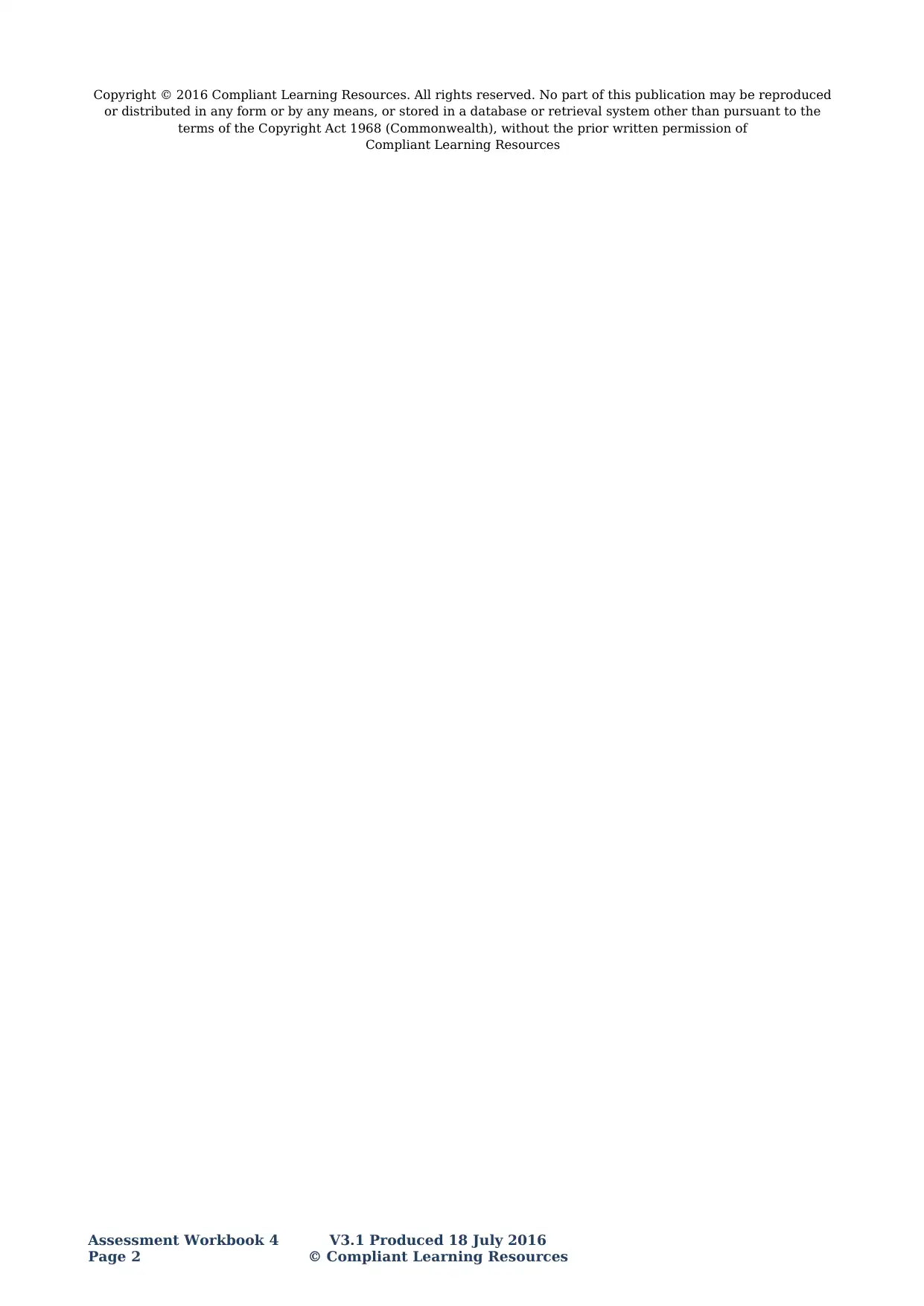
Copyright © 2016 Compliant Learning Resources. All rights reserved. No part of this publication may be reproduced
or distributed in any form or by any means, or stored in a database or retrieval system other than pursuant to the
terms of the Copyright Act 1968 (Commonwealth), without the prior written permission of
Compliant Learning Resources
Assessment Workbook 4 V3.1 Produced 18 July 2016
Page 2 © Compliant Learning Resources
or distributed in any form or by any means, or stored in a database or retrieval system other than pursuant to the
terms of the Copyright Act 1968 (Commonwealth), without the prior written permission of
Compliant Learning Resources
Assessment Workbook 4 V3.1 Produced 18 July 2016
Page 2 © Compliant Learning Resources
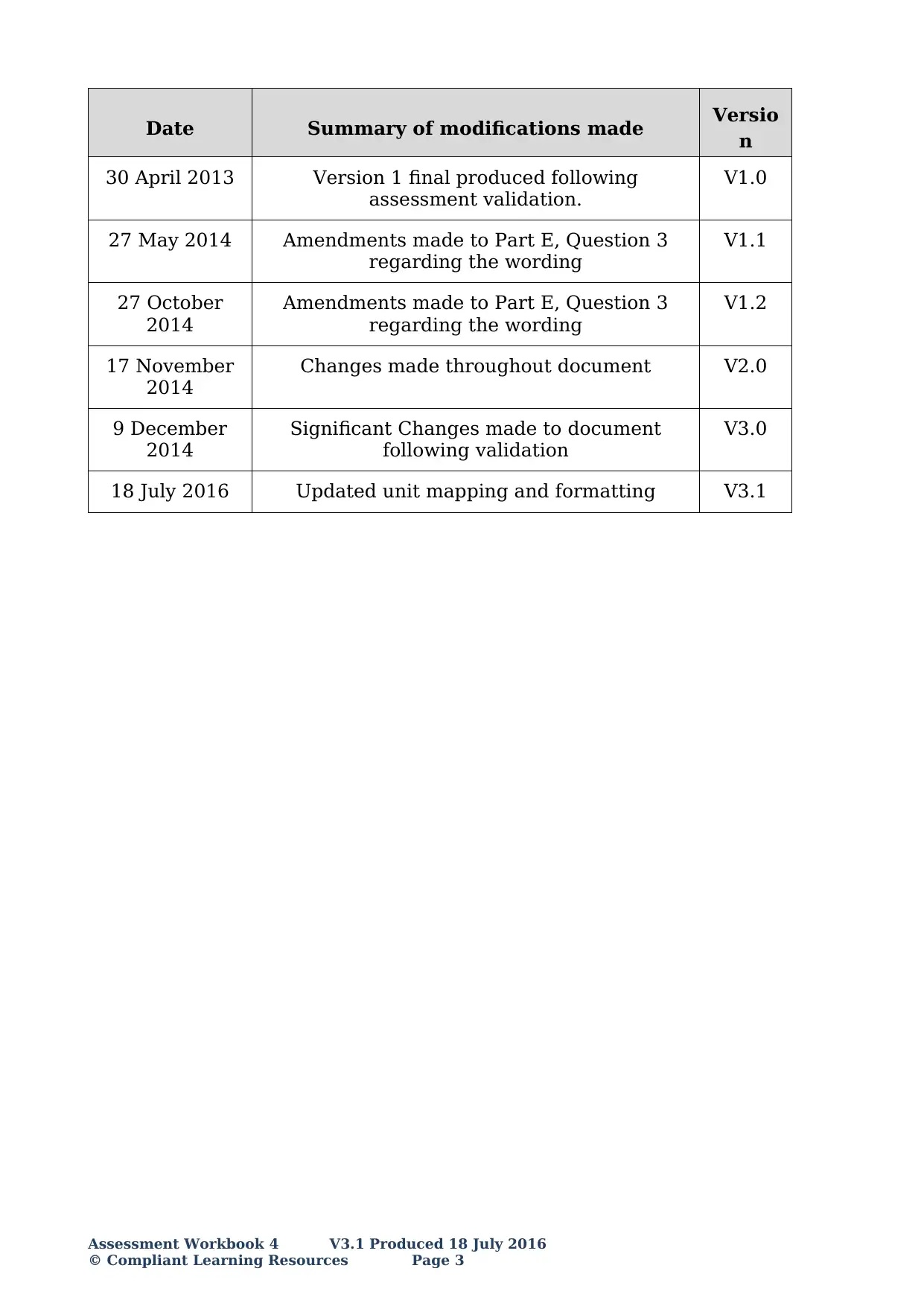
Date Summary of modifications made Versio
n
30 April 2013 Version 1 final produced following
assessment validation.
V1.0
27 May 2014 Amendments made to Part E, Question 3
regarding the wording
V1.1
27 October
2014
Amendments made to Part E, Question 3
regarding the wording
V1.2
17 November
2014
Changes made throughout document V2.0
9 December
2014
Significant Changes made to document
following validation
V3.0
18 July 2016 Updated unit mapping and formatting V3.1
Assessment Workbook 4 V3.1 Produced 18 July 2016
© Compliant Learning Resources Page 3
n
30 April 2013 Version 1 final produced following
assessment validation.
V1.0
27 May 2014 Amendments made to Part E, Question 3
regarding the wording
V1.1
27 October
2014
Amendments made to Part E, Question 3
regarding the wording
V1.2
17 November
2014
Changes made throughout document V2.0
9 December
2014
Significant Changes made to document
following validation
V3.0
18 July 2016 Updated unit mapping and formatting V3.1
Assessment Workbook 4 V3.1 Produced 18 July 2016
© Compliant Learning Resources Page 3
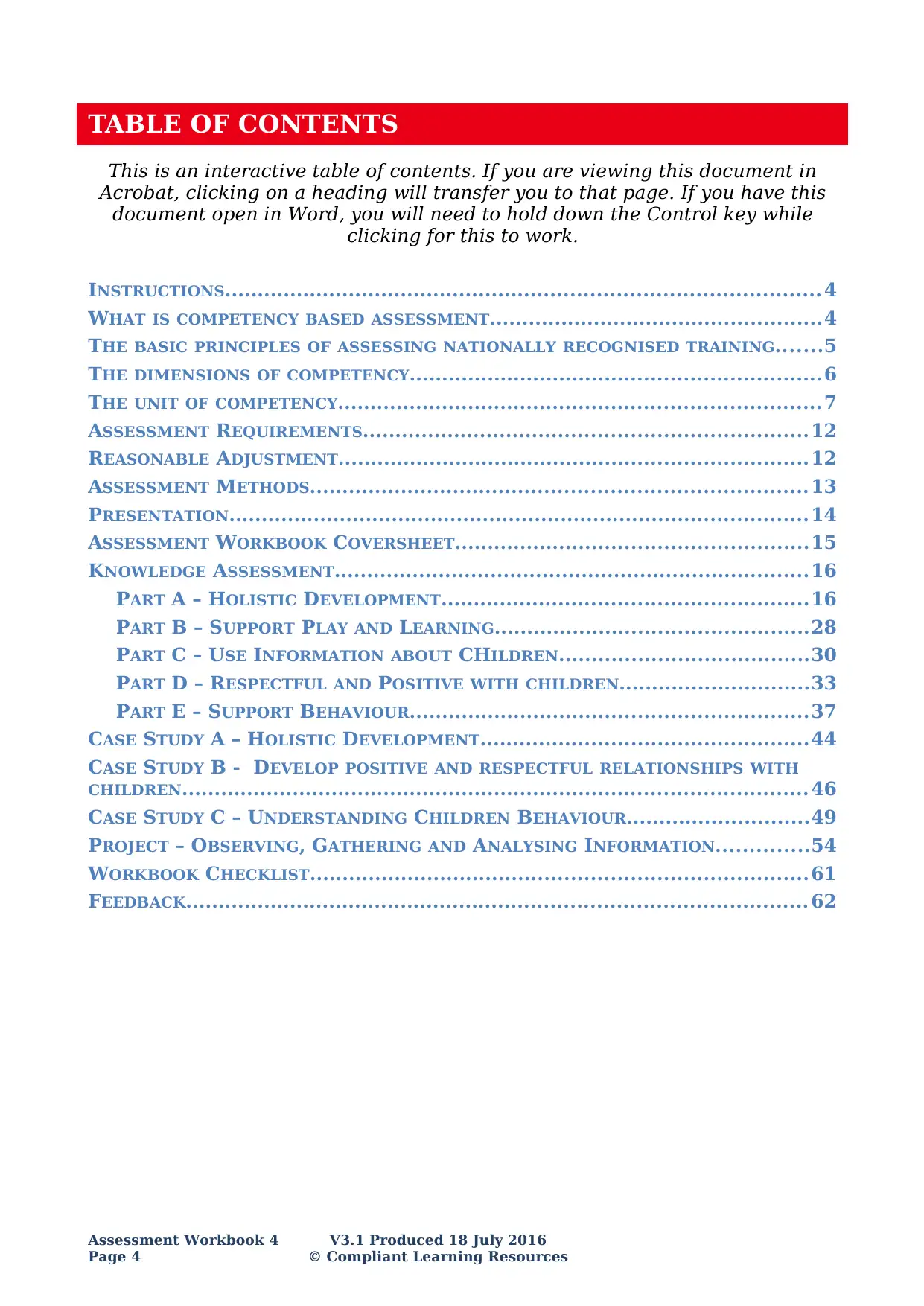
TABLE OF CONTENTS
This is an interactive table of contents. If you are viewing this document in
Acrobat, clicking on a heading will transfer you to that page. If you have this
document open in Word, you will need to hold down the Control key while
clicking for this to work.
INSTRUCTIONS........................................................................................... 4
WHAT IS COMPETENCY BASED ASSESSMENT...................................................4
THE BASIC PRINCIPLES OF ASSESSING NATIONALLY RECOGNISED TRAINING.......5
THE DIMENSIONS OF COMPETENCY...............................................................6
THE UNIT OF COMPETENCY..........................................................................7
ASSESSMENT REQUIREMENTS....................................................................12
REASONABLE ADJUSTMENT........................................................................12
ASSESSMENT METHODS............................................................................13
PRESENTATION.........................................................................................14
ASSESSMENT WORKBOOK COVERSHEET......................................................15
KNOWLEDGE ASSESSMENT.........................................................................16
PART A – HOLISTIC DEVELOPMENT........................................................16
PART B – SUPPORT PLAY AND LEARNING................................................28
PART C – USE INFORMATION ABOUT CHILDREN......................................30
PART D – RESPECTFUL AND POSITIVE WITH CHILDREN.............................33
PART E – SUPPORT BEHAVIOUR.............................................................37
CASE STUDY A – HOLISTIC DEVELOPMENT..................................................44
CASE STUDY B - DEVELOP POSITIVE AND RESPECTFUL RELATIONSHIPS WITH
CHILDREN................................................................................................ 46
CASE STUDY C – UNDERSTANDING CHILDREN BEHAVIOUR............................49
PROJECT – OBSERVING, GATHERING AND ANALYSING INFORMATION..............54
WORKBOOK CHECKLIST............................................................................61
FEEDBACK............................................................................................... 62
Assessment Workbook 4 V3.1 Produced 18 July 2016
Page 4 © Compliant Learning Resources
This is an interactive table of contents. If you are viewing this document in
Acrobat, clicking on a heading will transfer you to that page. If you have this
document open in Word, you will need to hold down the Control key while
clicking for this to work.
INSTRUCTIONS........................................................................................... 4
WHAT IS COMPETENCY BASED ASSESSMENT...................................................4
THE BASIC PRINCIPLES OF ASSESSING NATIONALLY RECOGNISED TRAINING.......5
THE DIMENSIONS OF COMPETENCY...............................................................6
THE UNIT OF COMPETENCY..........................................................................7
ASSESSMENT REQUIREMENTS....................................................................12
REASONABLE ADJUSTMENT........................................................................12
ASSESSMENT METHODS............................................................................13
PRESENTATION.........................................................................................14
ASSESSMENT WORKBOOK COVERSHEET......................................................15
KNOWLEDGE ASSESSMENT.........................................................................16
PART A – HOLISTIC DEVELOPMENT........................................................16
PART B – SUPPORT PLAY AND LEARNING................................................28
PART C – USE INFORMATION ABOUT CHILDREN......................................30
PART D – RESPECTFUL AND POSITIVE WITH CHILDREN.............................33
PART E – SUPPORT BEHAVIOUR.............................................................37
CASE STUDY A – HOLISTIC DEVELOPMENT..................................................44
CASE STUDY B - DEVELOP POSITIVE AND RESPECTFUL RELATIONSHIPS WITH
CHILDREN................................................................................................ 46
CASE STUDY C – UNDERSTANDING CHILDREN BEHAVIOUR............................49
PROJECT – OBSERVING, GATHERING AND ANALYSING INFORMATION..............54
WORKBOOK CHECKLIST............................................................................61
FEEDBACK............................................................................................... 62
Assessment Workbook 4 V3.1 Produced 18 July 2016
Page 4 © Compliant Learning Resources
Secure Best Marks with AI Grader
Need help grading? Try our AI Grader for instant feedback on your assignments.
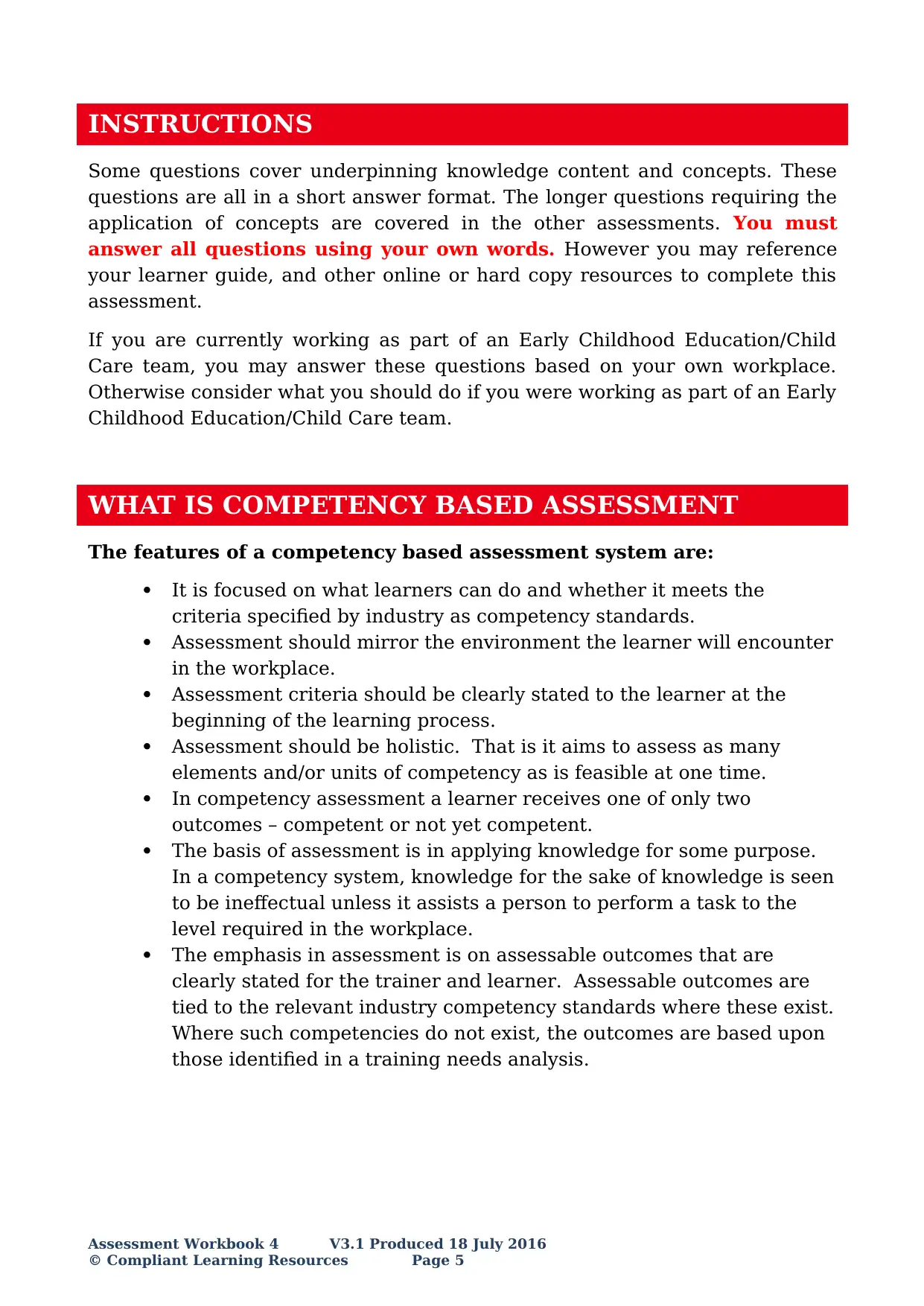
INSTRUCTIONS
Some questions cover underpinning knowledge content and concepts. These
questions are all in a short answer format. The longer questions requiring the
application of concepts are covered in the other assessments. You must
answer all questions using your own words. However you may reference
your learner guide, and other online or hard copy resources to complete this
assessment.
If you are currently working as part of an Early Childhood Education/Child
Care team, you may answer these questions based on your own workplace.
Otherwise consider what you should do if you were working as part of an Early
Childhood Education/Child Care team.
WHAT IS COMPETENCY BASED ASSESSMENT
The features of a competency based assessment system are:
It is focused on what learners can do and whether it meets the
criteria specified by industry as competency standards.
Assessment should mirror the environment the learner will encounter
in the workplace.
Assessment criteria should be clearly stated to the learner at the
beginning of the learning process.
Assessment should be holistic. That is it aims to assess as many
elements and/or units of competency as is feasible at one time.
In competency assessment a learner receives one of only two
outcomes – competent or not yet competent.
The basis of assessment is in applying knowledge for some purpose.
In a competency system, knowledge for the sake of knowledge is seen
to be ineffectual unless it assists a person to perform a task to the
level required in the workplace.
The emphasis in assessment is on assessable outcomes that are
clearly stated for the trainer and learner. Assessable outcomes are
tied to the relevant industry competency standards where these exist.
Where such competencies do not exist, the outcomes are based upon
those identified in a training needs analysis.
Assessment Workbook 4 V3.1 Produced 18 July 2016
© Compliant Learning Resources Page 5
Some questions cover underpinning knowledge content and concepts. These
questions are all in a short answer format. The longer questions requiring the
application of concepts are covered in the other assessments. You must
answer all questions using your own words. However you may reference
your learner guide, and other online or hard copy resources to complete this
assessment.
If you are currently working as part of an Early Childhood Education/Child
Care team, you may answer these questions based on your own workplace.
Otherwise consider what you should do if you were working as part of an Early
Childhood Education/Child Care team.
WHAT IS COMPETENCY BASED ASSESSMENT
The features of a competency based assessment system are:
It is focused on what learners can do and whether it meets the
criteria specified by industry as competency standards.
Assessment should mirror the environment the learner will encounter
in the workplace.
Assessment criteria should be clearly stated to the learner at the
beginning of the learning process.
Assessment should be holistic. That is it aims to assess as many
elements and/or units of competency as is feasible at one time.
In competency assessment a learner receives one of only two
outcomes – competent or not yet competent.
The basis of assessment is in applying knowledge for some purpose.
In a competency system, knowledge for the sake of knowledge is seen
to be ineffectual unless it assists a person to perform a task to the
level required in the workplace.
The emphasis in assessment is on assessable outcomes that are
clearly stated for the trainer and learner. Assessable outcomes are
tied to the relevant industry competency standards where these exist.
Where such competencies do not exist, the outcomes are based upon
those identified in a training needs analysis.
Assessment Workbook 4 V3.1 Produced 18 July 2016
© Compliant Learning Resources Page 5
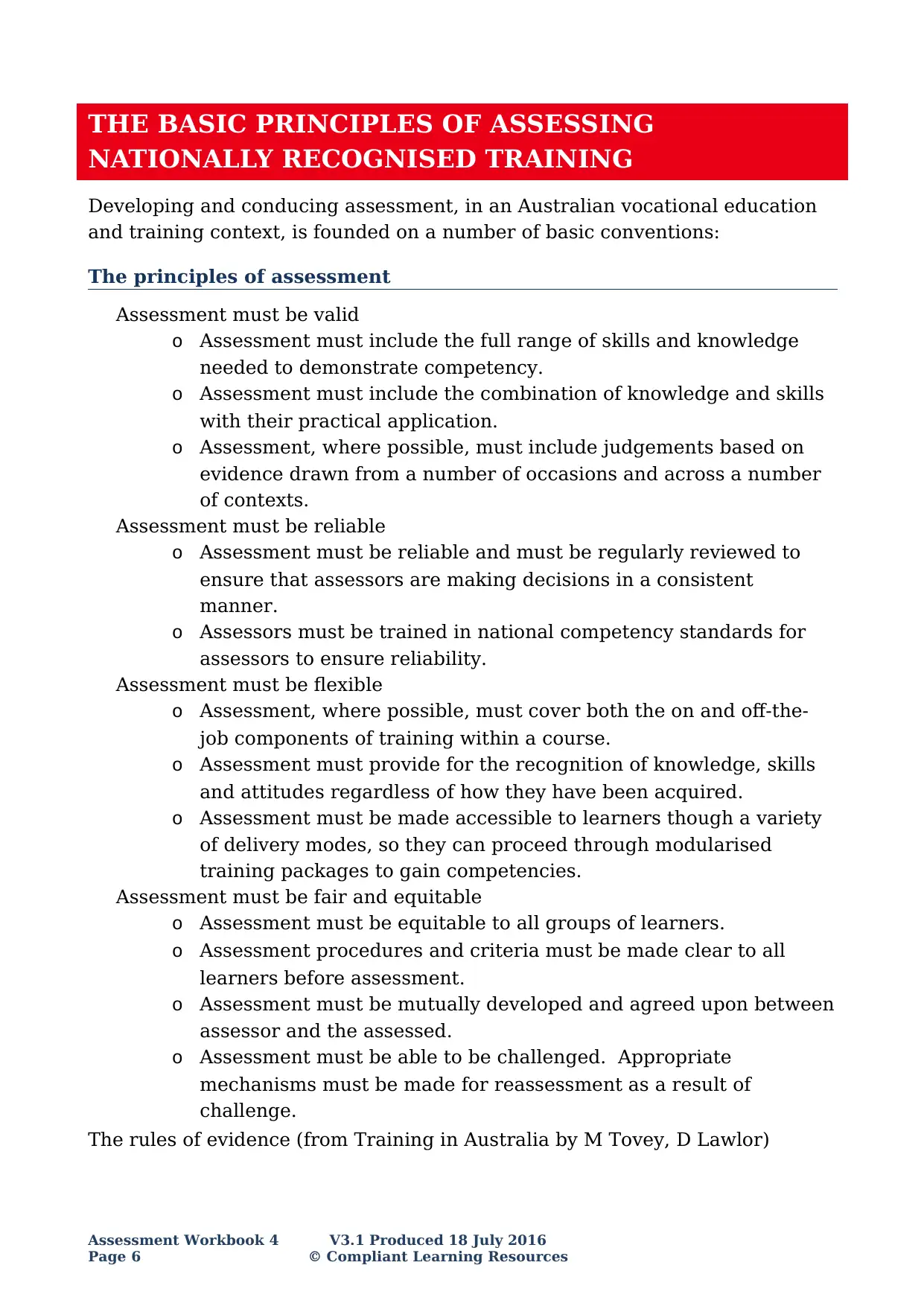
THE BASIC PRINCIPLES OF ASSESSING
NATIONALLY RECOGNISED TRAINING
Developing and conducing assessment, in an Australian vocational education
and training context, is founded on a number of basic conventions:
The principles of assessment
Assessment must be valid
o Assessment must include the full range of skills and knowledge
needed to demonstrate competency.
o Assessment must include the combination of knowledge and skills
with their practical application.
o Assessment, where possible, must include judgements based on
evidence drawn from a number of occasions and across a number
of contexts.
Assessment must be reliable
o Assessment must be reliable and must be regularly reviewed to
ensure that assessors are making decisions in a consistent
manner.
o Assessors must be trained in national competency standards for
assessors to ensure reliability.
Assessment must be flexible
o Assessment, where possible, must cover both the on and off-the-
job components of training within a course.
o Assessment must provide for the recognition of knowledge, skills
and attitudes regardless of how they have been acquired.
o Assessment must be made accessible to learners though a variety
of delivery modes, so they can proceed through modularised
training packages to gain competencies.
Assessment must be fair and equitable
o Assessment must be equitable to all groups of learners.
o Assessment procedures and criteria must be made clear to all
learners before assessment.
o Assessment must be mutually developed and agreed upon between
assessor and the assessed.
o Assessment must be able to be challenged. Appropriate
mechanisms must be made for reassessment as a result of
challenge.
The rules of evidence (from Training in Australia by M Tovey, D Lawlor)
Assessment Workbook 4 V3.1 Produced 18 July 2016
Page 6 © Compliant Learning Resources
NATIONALLY RECOGNISED TRAINING
Developing and conducing assessment, in an Australian vocational education
and training context, is founded on a number of basic conventions:
The principles of assessment
Assessment must be valid
o Assessment must include the full range of skills and knowledge
needed to demonstrate competency.
o Assessment must include the combination of knowledge and skills
with their practical application.
o Assessment, where possible, must include judgements based on
evidence drawn from a number of occasions and across a number
of contexts.
Assessment must be reliable
o Assessment must be reliable and must be regularly reviewed to
ensure that assessors are making decisions in a consistent
manner.
o Assessors must be trained in national competency standards for
assessors to ensure reliability.
Assessment must be flexible
o Assessment, where possible, must cover both the on and off-the-
job components of training within a course.
o Assessment must provide for the recognition of knowledge, skills
and attitudes regardless of how they have been acquired.
o Assessment must be made accessible to learners though a variety
of delivery modes, so they can proceed through modularised
training packages to gain competencies.
Assessment must be fair and equitable
o Assessment must be equitable to all groups of learners.
o Assessment procedures and criteria must be made clear to all
learners before assessment.
o Assessment must be mutually developed and agreed upon between
assessor and the assessed.
o Assessment must be able to be challenged. Appropriate
mechanisms must be made for reassessment as a result of
challenge.
The rules of evidence (from Training in Australia by M Tovey, D Lawlor)
Assessment Workbook 4 V3.1 Produced 18 July 2016
Page 6 © Compliant Learning Resources
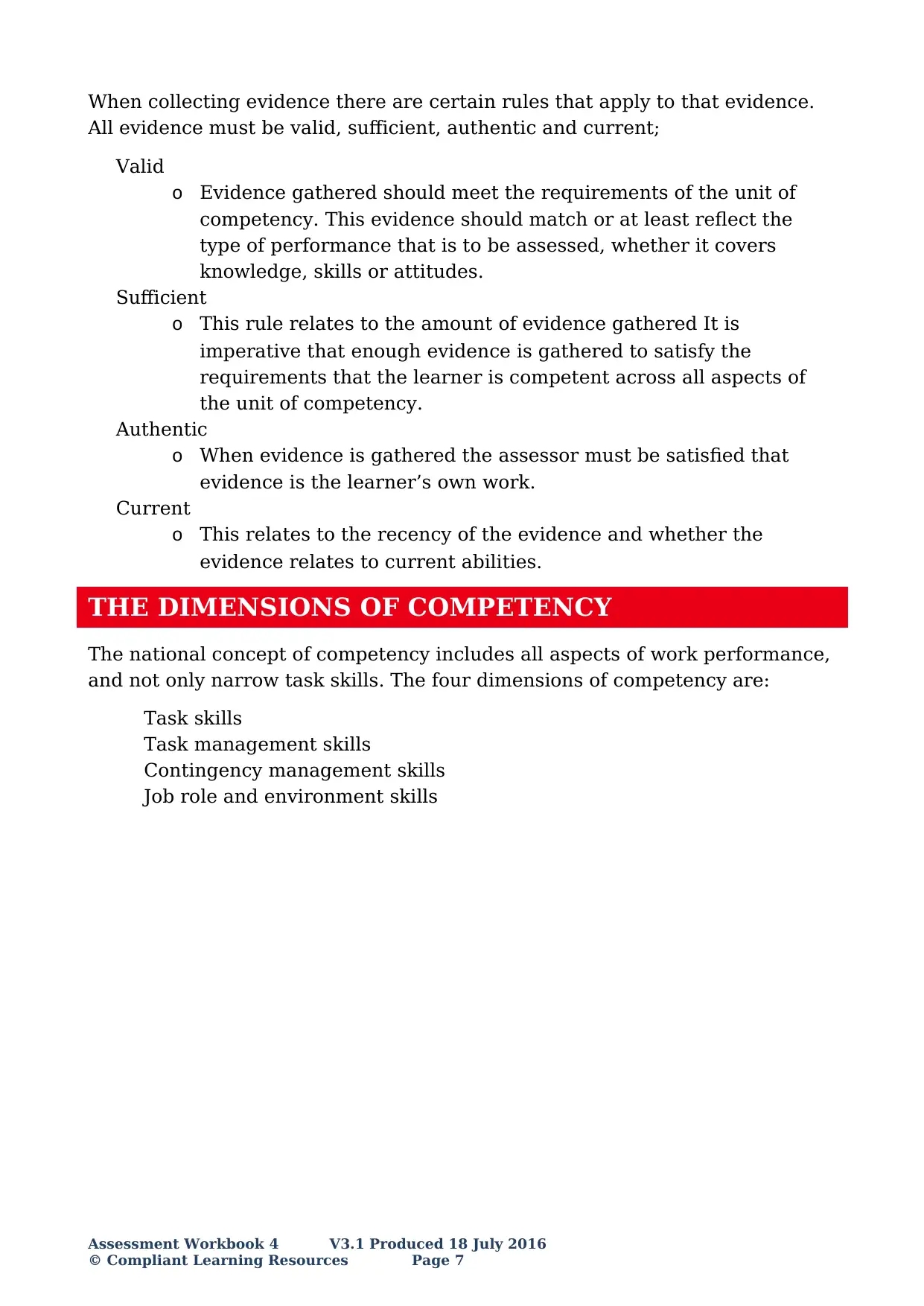
When collecting evidence there are certain rules that apply to that evidence.
All evidence must be valid, sufficient, authentic and current;
Valid
o Evidence gathered should meet the requirements of the unit of
competency. This evidence should match or at least reflect the
type of performance that is to be assessed, whether it covers
knowledge, skills or attitudes.
Sufficient
o This rule relates to the amount of evidence gathered It is
imperative that enough evidence is gathered to satisfy the
requirements that the learner is competent across all aspects of
the unit of competency.
Authentic
o When evidence is gathered the assessor must be satisfied that
evidence is the learner’s own work.
Current
o This relates to the recency of the evidence and whether the
evidence relates to current abilities.
THE DIMENSIONS OF COMPETENCY
The national concept of competency includes all aspects of work performance,
and not only narrow task skills. The four dimensions of competency are:
Task skills
Task management skills
Contingency management skills
Job role and environment skills
Assessment Workbook 4 V3.1 Produced 18 July 2016
© Compliant Learning Resources Page 7
All evidence must be valid, sufficient, authentic and current;
Valid
o Evidence gathered should meet the requirements of the unit of
competency. This evidence should match or at least reflect the
type of performance that is to be assessed, whether it covers
knowledge, skills or attitudes.
Sufficient
o This rule relates to the amount of evidence gathered It is
imperative that enough evidence is gathered to satisfy the
requirements that the learner is competent across all aspects of
the unit of competency.
Authentic
o When evidence is gathered the assessor must be satisfied that
evidence is the learner’s own work.
Current
o This relates to the recency of the evidence and whether the
evidence relates to current abilities.
THE DIMENSIONS OF COMPETENCY
The national concept of competency includes all aspects of work performance,
and not only narrow task skills. The four dimensions of competency are:
Task skills
Task management skills
Contingency management skills
Job role and environment skills
Assessment Workbook 4 V3.1 Produced 18 July 2016
© Compliant Learning Resources Page 7
Paraphrase This Document
Need a fresh take? Get an instant paraphrase of this document with our AI Paraphraser
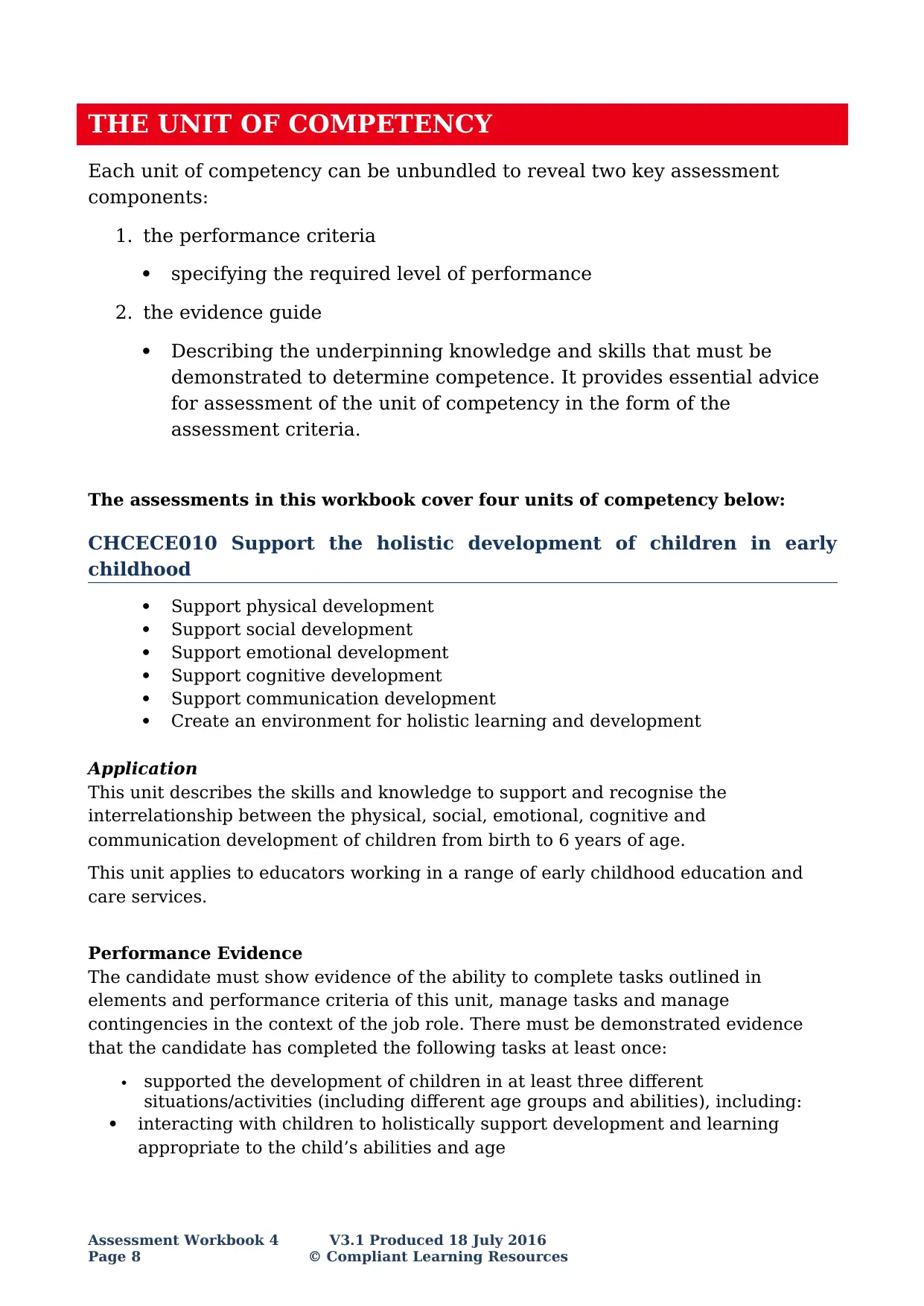
THE UNIT OF COMPETENCY
Each unit of competency can be unbundled to reveal two key assessment
components:
1. the performance criteria
specifying the required level of performance
2. the evidence guide
Describing the underpinning knowledge and skills that must be
demonstrated to determine competence. It provides essential advice
for assessment of the unit of competency in the form of the
assessment criteria.
The assessments in this workbook cover four units of competency below:
CHCECE010 Support the holistic development of children in early
childhood
Support physical development
Support social development
Support emotional development
Support cognitive development
Support communication development
Create an environment for holistic learning and development
Application
This unit describes the skills and knowledge to support and recognise the
interrelationship between the physical, social, emotional, cognitive and
communication development of children from birth to 6 years of age.
This unit applies to educators working in a range of early childhood education and
care services.
Performance Evidence
The candidate must show evidence of the ability to complete tasks outlined in
elements and performance criteria of this unit, manage tasks and manage
contingencies in the context of the job role. There must be demonstrated evidence
that the candidate has completed the following tasks at least once:
supported the development of children in at least three different
situations/activities (including different age groups and abilities), including:
interacting with children to holistically support development and learning
appropriate to the child’s abilities and age
Assessment Workbook 4 V3.1 Produced 18 July 2016
Page 8 © Compliant Learning Resources
Each unit of competency can be unbundled to reveal two key assessment
components:
1. the performance criteria
specifying the required level of performance
2. the evidence guide
Describing the underpinning knowledge and skills that must be
demonstrated to determine competence. It provides essential advice
for assessment of the unit of competency in the form of the
assessment criteria.
The assessments in this workbook cover four units of competency below:
CHCECE010 Support the holistic development of children in early
childhood
Support physical development
Support social development
Support emotional development
Support cognitive development
Support communication development
Create an environment for holistic learning and development
Application
This unit describes the skills and knowledge to support and recognise the
interrelationship between the physical, social, emotional, cognitive and
communication development of children from birth to 6 years of age.
This unit applies to educators working in a range of early childhood education and
care services.
Performance Evidence
The candidate must show evidence of the ability to complete tasks outlined in
elements and performance criteria of this unit, manage tasks and manage
contingencies in the context of the job role. There must be demonstrated evidence
that the candidate has completed the following tasks at least once:
supported the development of children in at least three different
situations/activities (including different age groups and abilities), including:
interacting with children to holistically support development and learning
appropriate to the child’s abilities and age
Assessment Workbook 4 V3.1 Produced 18 July 2016
Page 8 © Compliant Learning Resources
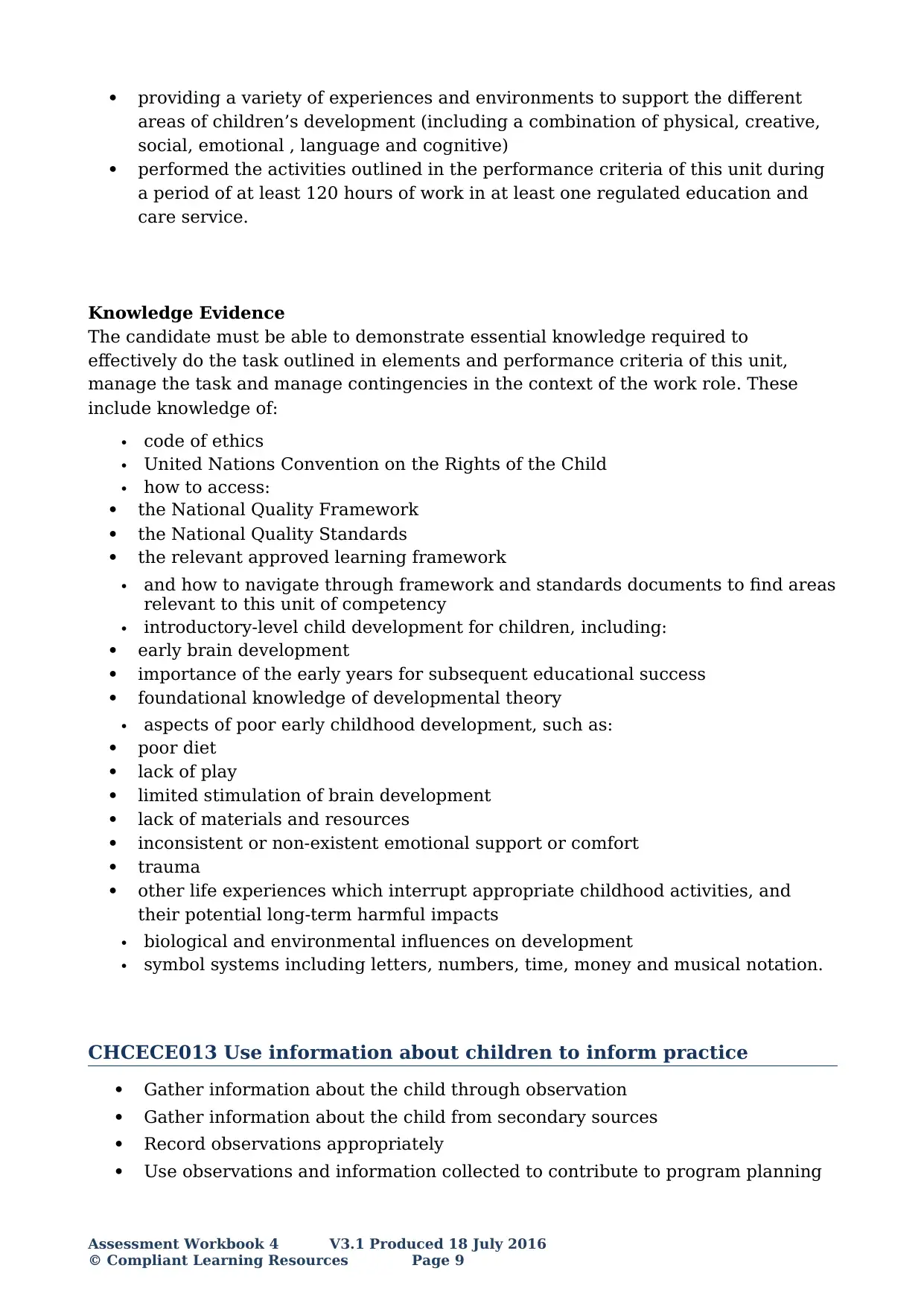
providing a variety of experiences and environments to support the different
areas of children’s development (including a combination of physical, creative,
social, emotional , language and cognitive)
performed the activities outlined in the performance criteria of this unit during
a period of at least 120 hours of work in at least one regulated education and
care service.
Knowledge Evidence
The candidate must be able to demonstrate essential knowledge required to
effectively do the task outlined in elements and performance criteria of this unit,
manage the task and manage contingencies in the context of the work role. These
include knowledge of:
code of ethics
United Nations Convention on the Rights of the Child
how to access:
the National Quality Framework
the National Quality Standards
the relevant approved learning framework
and how to navigate through framework and standards documents to find areas
relevant to this unit of competency
introductory-level child development for children, including:
early brain development
importance of the early years for subsequent educational success
foundational knowledge of developmental theory
aspects of poor early childhood development, such as:
poor diet
lack of play
limited stimulation of brain development
lack of materials and resources
inconsistent or non-existent emotional support or comfort
trauma
other life experiences which interrupt appropriate childhood activities, and
their potential long-term harmful impacts
biological and environmental influences on development
symbol systems including letters, numbers, time, money and musical notation.
CHCECE013 Use information about children to inform practice
Gather information about the child through observation
Gather information about the child from secondary sources
Record observations appropriately
Use observations and information collected to contribute to program planning
Assessment Workbook 4 V3.1 Produced 18 July 2016
© Compliant Learning Resources Page 9
areas of children’s development (including a combination of physical, creative,
social, emotional , language and cognitive)
performed the activities outlined in the performance criteria of this unit during
a period of at least 120 hours of work in at least one regulated education and
care service.
Knowledge Evidence
The candidate must be able to demonstrate essential knowledge required to
effectively do the task outlined in elements and performance criteria of this unit,
manage the task and manage contingencies in the context of the work role. These
include knowledge of:
code of ethics
United Nations Convention on the Rights of the Child
how to access:
the National Quality Framework
the National Quality Standards
the relevant approved learning framework
and how to navigate through framework and standards documents to find areas
relevant to this unit of competency
introductory-level child development for children, including:
early brain development
importance of the early years for subsequent educational success
foundational knowledge of developmental theory
aspects of poor early childhood development, such as:
poor diet
lack of play
limited stimulation of brain development
lack of materials and resources
inconsistent or non-existent emotional support or comfort
trauma
other life experiences which interrupt appropriate childhood activities, and
their potential long-term harmful impacts
biological and environmental influences on development
symbol systems including letters, numbers, time, money and musical notation.
CHCECE013 Use information about children to inform practice
Gather information about the child through observation
Gather information about the child from secondary sources
Record observations appropriately
Use observations and information collected to contribute to program planning
Assessment Workbook 4 V3.1 Produced 18 July 2016
© Compliant Learning Resources Page 9
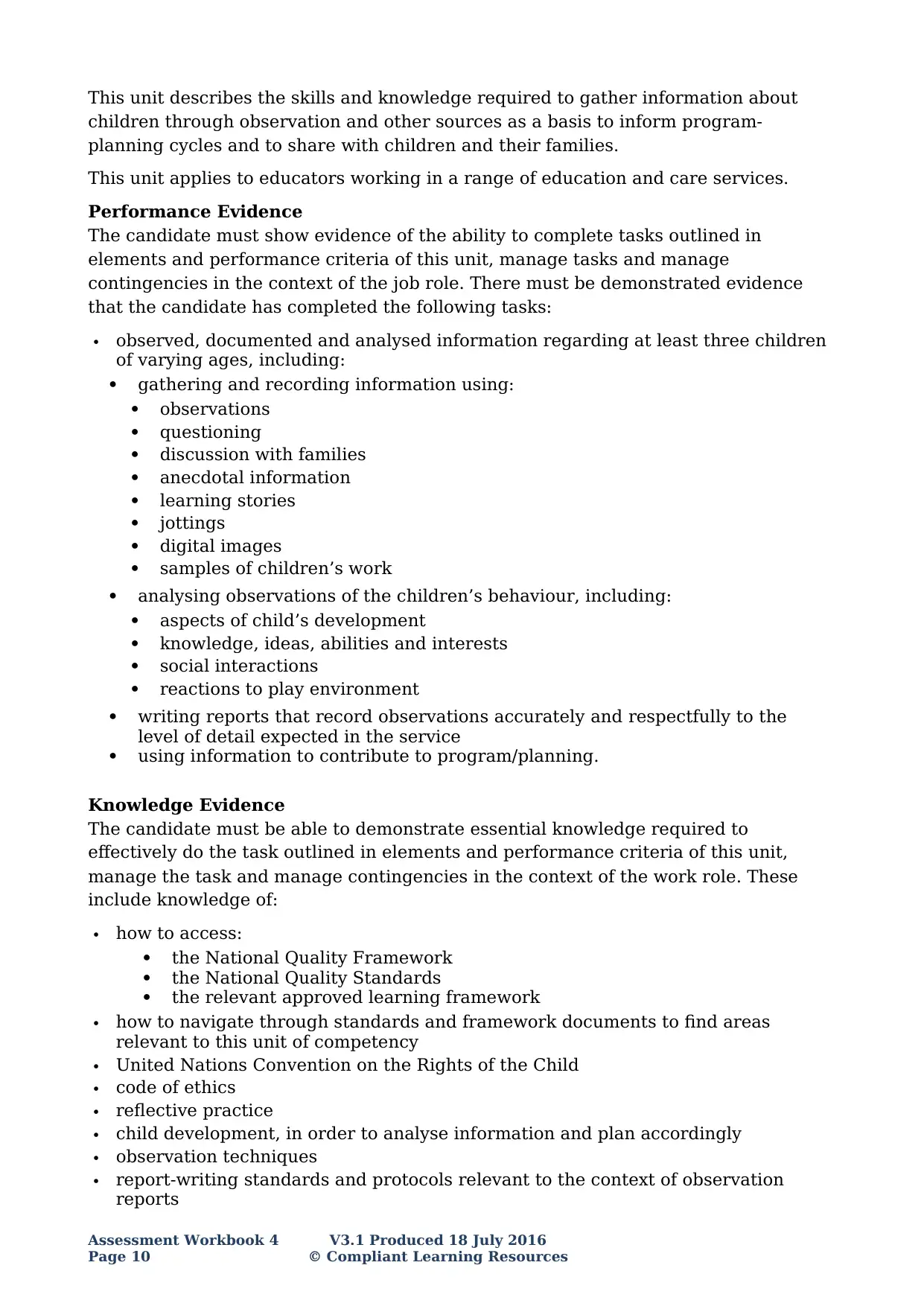
This unit describes the skills and knowledge required to gather information about
children through observation and other sources as a basis to inform program-
planning cycles and to share with children and their families.
This unit applies to educators working in a range of education and care services.
Performance Evidence
The candidate must show evidence of the ability to complete tasks outlined in
elements and performance criteria of this unit, manage tasks and manage
contingencies in the context of the job role. There must be demonstrated evidence
that the candidate has completed the following tasks:
observed, documented and analysed information regarding at least three children
of varying ages, including:
gathering and recording information using:
observations
questioning
discussion with families
anecdotal information
learning stories
jottings
digital images
samples of children’s work
analysing observations of the children’s behaviour, including:
aspects of child’s development
knowledge, ideas, abilities and interests
social interactions
reactions to play environment
writing reports that record observations accurately and respectfully to the
level of detail expected in the service
using information to contribute to program/planning.
Knowledge Evidence
The candidate must be able to demonstrate essential knowledge required to
effectively do the task outlined in elements and performance criteria of this unit,
manage the task and manage contingencies in the context of the work role. These
include knowledge of:
how to access:
the National Quality Framework
the National Quality Standards
the relevant approved learning framework
how to navigate through standards and framework documents to find areas
relevant to this unit of competency
United Nations Convention on the Rights of the Child
code of ethics
reflective practice
child development, in order to analyse information and plan accordingly
observation techniques
report-writing standards and protocols relevant to the context of observation
reports
Assessment Workbook 4 V3.1 Produced 18 July 2016
Page 10 © Compliant Learning Resources
children through observation and other sources as a basis to inform program-
planning cycles and to share with children and their families.
This unit applies to educators working in a range of education and care services.
Performance Evidence
The candidate must show evidence of the ability to complete tasks outlined in
elements and performance criteria of this unit, manage tasks and manage
contingencies in the context of the job role. There must be demonstrated evidence
that the candidate has completed the following tasks:
observed, documented and analysed information regarding at least three children
of varying ages, including:
gathering and recording information using:
observations
questioning
discussion with families
anecdotal information
learning stories
jottings
digital images
samples of children’s work
analysing observations of the children’s behaviour, including:
aspects of child’s development
knowledge, ideas, abilities and interests
social interactions
reactions to play environment
writing reports that record observations accurately and respectfully to the
level of detail expected in the service
using information to contribute to program/planning.
Knowledge Evidence
The candidate must be able to demonstrate essential knowledge required to
effectively do the task outlined in elements and performance criteria of this unit,
manage the task and manage contingencies in the context of the work role. These
include knowledge of:
how to access:
the National Quality Framework
the National Quality Standards
the relevant approved learning framework
how to navigate through standards and framework documents to find areas
relevant to this unit of competency
United Nations Convention on the Rights of the Child
code of ethics
reflective practice
child development, in order to analyse information and plan accordingly
observation techniques
report-writing standards and protocols relevant to the context of observation
reports
Assessment Workbook 4 V3.1 Produced 18 July 2016
Page 10 © Compliant Learning Resources
Secure Best Marks with AI Grader
Need help grading? Try our AI Grader for instant feedback on your assignments.
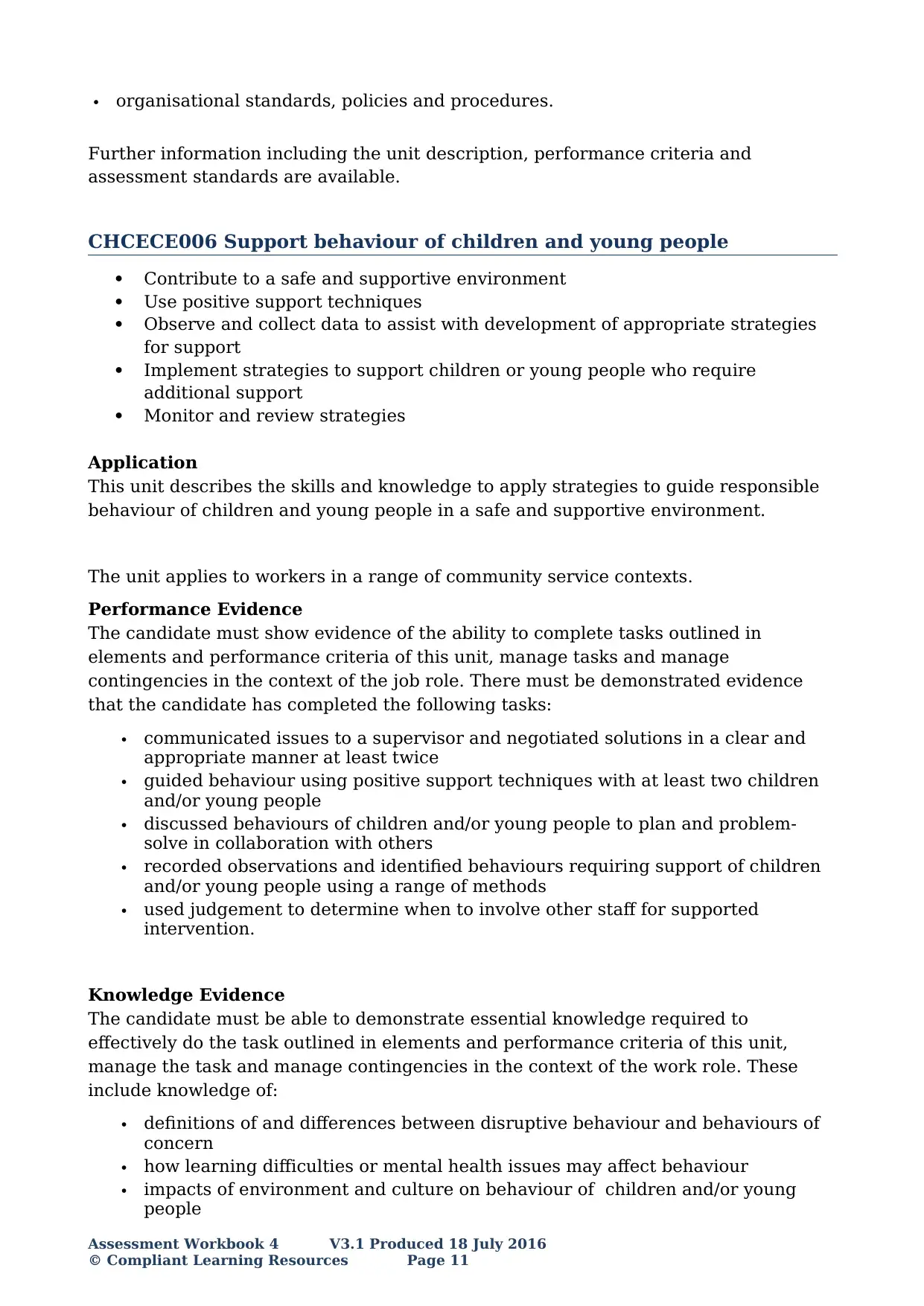
organisational standards, policies and procedures.
Further information including the unit description, performance criteria and
assessment standards are available.
CHCECE006 Support behaviour of children and young people
Contribute to a safe and supportive environment
Use positive support techniques
Observe and collect data to assist with development of appropriate strategies
for support
Implement strategies to support children or young people who require
additional support
Monitor and review strategies
Application
This unit describes the skills and knowledge to apply strategies to guide responsible
behaviour of children and young people in a safe and supportive environment.
The unit applies to workers in a range of community service contexts.
Performance Evidence
The candidate must show evidence of the ability to complete tasks outlined in
elements and performance criteria of this unit, manage tasks and manage
contingencies in the context of the job role. There must be demonstrated evidence
that the candidate has completed the following tasks:
communicated issues to a supervisor and negotiated solutions in a clear and
appropriate manner at least twice
guided behaviour using positive support techniques with at least two children
and/or young people
discussed behaviours of children and/or young people to plan and problem-
solve in collaboration with others
recorded observations and identified behaviours requiring support of children
and/or young people using a range of methods
used judgement to determine when to involve other staff for supported
intervention.
Knowledge Evidence
The candidate must be able to demonstrate essential knowledge required to
effectively do the task outlined in elements and performance criteria of this unit,
manage the task and manage contingencies in the context of the work role. These
include knowledge of:
definitions of and differences between disruptive behaviour and behaviours of
concern
how learning difficulties or mental health issues may affect behaviour
impacts of environment and culture on behaviour of children and/or young
people
Assessment Workbook 4 V3.1 Produced 18 July 2016
© Compliant Learning Resources Page 11
Further information including the unit description, performance criteria and
assessment standards are available.
CHCECE006 Support behaviour of children and young people
Contribute to a safe and supportive environment
Use positive support techniques
Observe and collect data to assist with development of appropriate strategies
for support
Implement strategies to support children or young people who require
additional support
Monitor and review strategies
Application
This unit describes the skills and knowledge to apply strategies to guide responsible
behaviour of children and young people in a safe and supportive environment.
The unit applies to workers in a range of community service contexts.
Performance Evidence
The candidate must show evidence of the ability to complete tasks outlined in
elements and performance criteria of this unit, manage tasks and manage
contingencies in the context of the job role. There must be demonstrated evidence
that the candidate has completed the following tasks:
communicated issues to a supervisor and negotiated solutions in a clear and
appropriate manner at least twice
guided behaviour using positive support techniques with at least two children
and/or young people
discussed behaviours of children and/or young people to plan and problem-
solve in collaboration with others
recorded observations and identified behaviours requiring support of children
and/or young people using a range of methods
used judgement to determine when to involve other staff for supported
intervention.
Knowledge Evidence
The candidate must be able to demonstrate essential knowledge required to
effectively do the task outlined in elements and performance criteria of this unit,
manage the task and manage contingencies in the context of the work role. These
include knowledge of:
definitions of and differences between disruptive behaviour and behaviours of
concern
how learning difficulties or mental health issues may affect behaviour
impacts of environment and culture on behaviour of children and/or young
people
Assessment Workbook 4 V3.1 Produced 18 July 2016
© Compliant Learning Resources Page 11

communicative function of behaviour and positive support strategies to
redirect behaviour and defuse situations
organisational standards, policies and procedures.
CHCECE007 Develop positive and respectful relationships with
children
Communicate positively with children
Interact positively with children
Support and respect children
Maintain the dignity and rights of children
Application
This unit describes the skills and knowledge required by educators working with
children to ensure they can develop and maintain effective relationships and promote
positive behaviour.
This unit applies to educators who work with children in a range of education and
care service settings.
Foundation Skills
The foundation skills described those required skills (language, literacy and
numeracy) that are essential to performance.
Oral communication – in order to engage in sustained conversations with
children.
The remaining foundation skills essential to performance are explicit in the
performance criteria of this unit.
Performance Evidence
The candidate must show evidence of the ability to complete tasks outlined in
elements and performance criteria of this unit, manage tasks and manage
contingencies in the context of the job role. There must be demonstrated evidence
that the candidate has completed the following tasks at least once:
communicated positively and respectfully and interacted effectively with at
least three children, including:
active listening
consideration of a child’s age, activities, interests, culture and needs
interpreting non-verbal cues of children
responding to distress in ways that meets the child’s need
communication of care and respect through all interactions
assessed and responded appropriately to behaviours of concern
encouraged children to respect similarities and differences between each other
involved and encouraged children in decision-making and planning
performed the activities outlined in the performance criteria of this unit during
a period of at least 120 hours of work in at least one regulated education and
care service
Assessment Workbook 4 V3.1 Produced 18 July 2016
Page 12 © Compliant Learning Resources
redirect behaviour and defuse situations
organisational standards, policies and procedures.
CHCECE007 Develop positive and respectful relationships with
children
Communicate positively with children
Interact positively with children
Support and respect children
Maintain the dignity and rights of children
Application
This unit describes the skills and knowledge required by educators working with
children to ensure they can develop and maintain effective relationships and promote
positive behaviour.
This unit applies to educators who work with children in a range of education and
care service settings.
Foundation Skills
The foundation skills described those required skills (language, literacy and
numeracy) that are essential to performance.
Oral communication – in order to engage in sustained conversations with
children.
The remaining foundation skills essential to performance are explicit in the
performance criteria of this unit.
Performance Evidence
The candidate must show evidence of the ability to complete tasks outlined in
elements and performance criteria of this unit, manage tasks and manage
contingencies in the context of the job role. There must be demonstrated evidence
that the candidate has completed the following tasks at least once:
communicated positively and respectfully and interacted effectively with at
least three children, including:
active listening
consideration of a child’s age, activities, interests, culture and needs
interpreting non-verbal cues of children
responding to distress in ways that meets the child’s need
communication of care and respect through all interactions
assessed and responded appropriately to behaviours of concern
encouraged children to respect similarities and differences between each other
involved and encouraged children in decision-making and planning
performed the activities outlined in the performance criteria of this unit during
a period of at least 120 hours of work in at least one regulated education and
care service
Assessment Workbook 4 V3.1 Produced 18 July 2016
Page 12 © Compliant Learning Resources
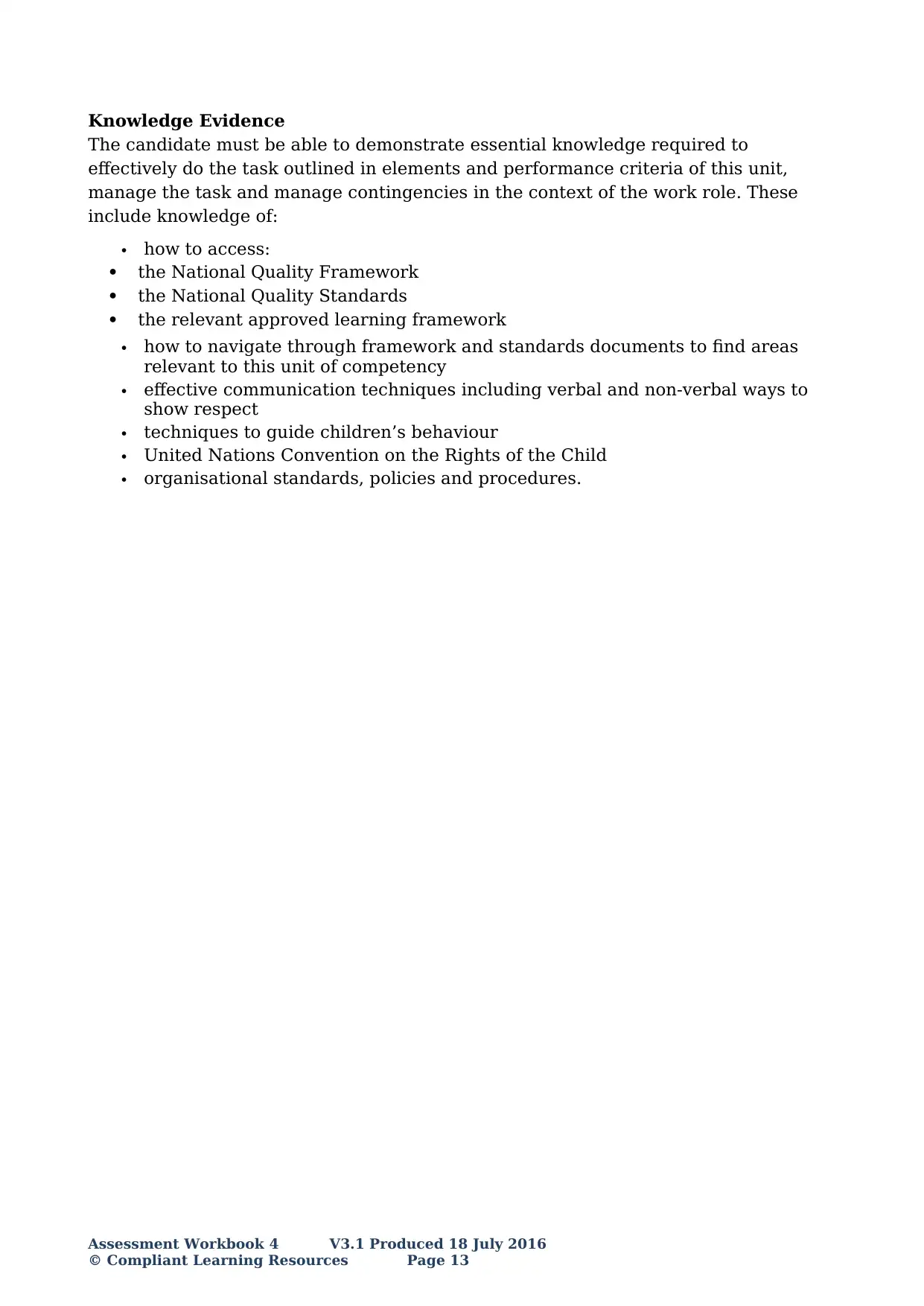
Knowledge Evidence
The candidate must be able to demonstrate essential knowledge required to
effectively do the task outlined in elements and performance criteria of this unit,
manage the task and manage contingencies in the context of the work role. These
include knowledge of:
how to access:
the National Quality Framework
the National Quality Standards
the relevant approved learning framework
how to navigate through framework and standards documents to find areas
relevant to this unit of competency
effective communication techniques including verbal and non-verbal ways to
show respect
techniques to guide children’s behaviour
United Nations Convention on the Rights of the Child
organisational standards, policies and procedures.
Assessment Workbook 4 V3.1 Produced 18 July 2016
© Compliant Learning Resources Page 13
The candidate must be able to demonstrate essential knowledge required to
effectively do the task outlined in elements and performance criteria of this unit,
manage the task and manage contingencies in the context of the work role. These
include knowledge of:
how to access:
the National Quality Framework
the National Quality Standards
the relevant approved learning framework
how to navigate through framework and standards documents to find areas
relevant to this unit of competency
effective communication techniques including verbal and non-verbal ways to
show respect
techniques to guide children’s behaviour
United Nations Convention on the Rights of the Child
organisational standards, policies and procedures.
Assessment Workbook 4 V3.1 Produced 18 July 2016
© Compliant Learning Resources Page 13
Paraphrase This Document
Need a fresh take? Get an instant paraphrase of this document with our AI Paraphraser
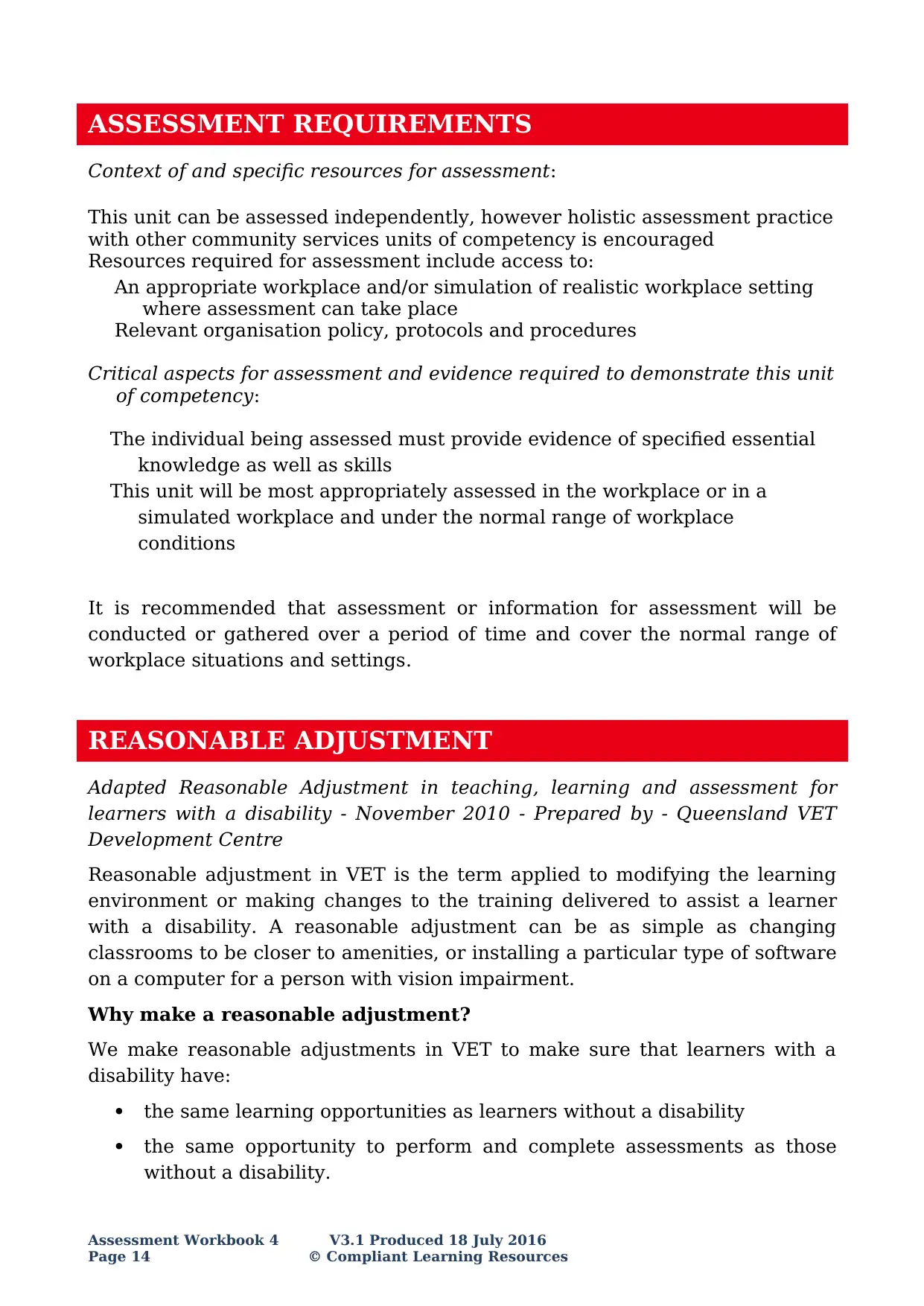
ASSESSMENT REQUIREMENTS
Context of and specific resources for assessment:
This unit can be assessed independently, however holistic assessment practice
with other community services units of competency is encouraged
Resources required for assessment include access to:
An appropriate workplace and/or simulation of realistic workplace setting
where assessment can take place
Relevant organisation policy, protocols and procedures
Critical aspects for assessment and evidence required to demonstrate this unit
of competency:
The individual being assessed must provide evidence of specified essential
knowledge as well as skills
This unit will be most appropriately assessed in the workplace or in a
simulated workplace and under the normal range of workplace
conditions
It is recommended that assessment or information for assessment will be
conducted or gathered over a period of time and cover the normal range of
workplace situations and settings.
REASONABLE ADJUSTMENT
Adapted Reasonable Adjustment in teaching, learning and assessment for
learners with a disability - November 2010 - Prepared by - Queensland VET
Development Centre
Reasonable adjustment in VET is the term applied to modifying the learning
environment or making changes to the training delivered to assist a learner
with a disability. A reasonable adjustment can be as simple as changing
classrooms to be closer to amenities, or installing a particular type of software
on a computer for a person with vision impairment.
Why make a reasonable adjustment?
We make reasonable adjustments in VET to make sure that learners with a
disability have:
the same learning opportunities as learners without a disability
the same opportunity to perform and complete assessments as those
without a disability.
Assessment Workbook 4 V3.1 Produced 18 July 2016
Page 14 © Compliant Learning Resources
Context of and specific resources for assessment:
This unit can be assessed independently, however holistic assessment practice
with other community services units of competency is encouraged
Resources required for assessment include access to:
An appropriate workplace and/or simulation of realistic workplace setting
where assessment can take place
Relevant organisation policy, protocols and procedures
Critical aspects for assessment and evidence required to demonstrate this unit
of competency:
The individual being assessed must provide evidence of specified essential
knowledge as well as skills
This unit will be most appropriately assessed in the workplace or in a
simulated workplace and under the normal range of workplace
conditions
It is recommended that assessment or information for assessment will be
conducted or gathered over a period of time and cover the normal range of
workplace situations and settings.
REASONABLE ADJUSTMENT
Adapted Reasonable Adjustment in teaching, learning and assessment for
learners with a disability - November 2010 - Prepared by - Queensland VET
Development Centre
Reasonable adjustment in VET is the term applied to modifying the learning
environment or making changes to the training delivered to assist a learner
with a disability. A reasonable adjustment can be as simple as changing
classrooms to be closer to amenities, or installing a particular type of software
on a computer for a person with vision impairment.
Why make a reasonable adjustment?
We make reasonable adjustments in VET to make sure that learners with a
disability have:
the same learning opportunities as learners without a disability
the same opportunity to perform and complete assessments as those
without a disability.
Assessment Workbook 4 V3.1 Produced 18 July 2016
Page 14 © Compliant Learning Resources

Assessment Workbook 4 V3.1 Produced 18 July 2016
© Compliant Learning Resources Page 15
© Compliant Learning Resources Page 15
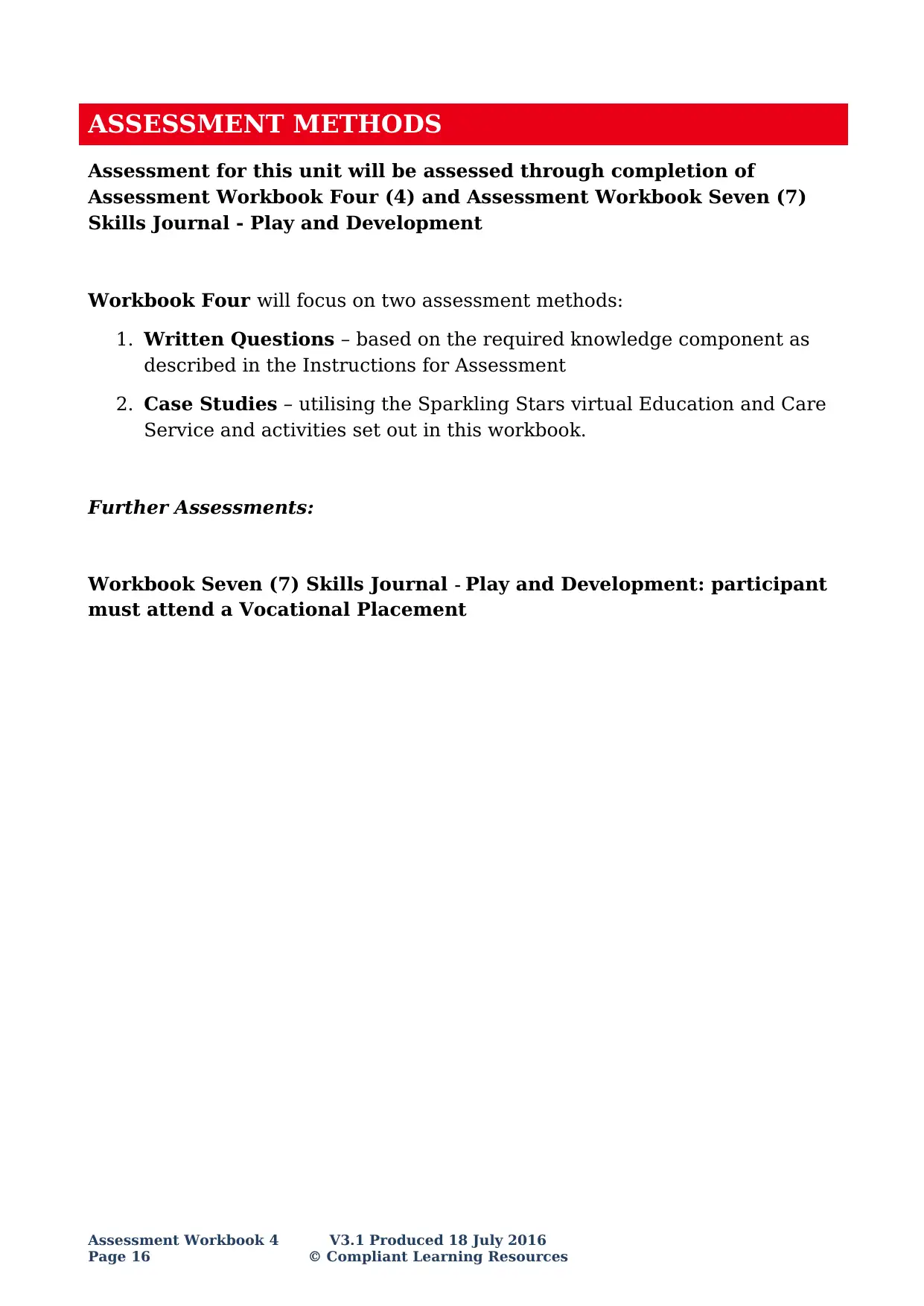
ASSESSMENT METHODS
Assessment for this unit will be assessed through completion of
Assessment Workbook Four (4) and Assessment Workbook Seven (7)
Skills Journal - Play and Development
Workbook Four will focus on two assessment methods:
1. Written Questions – based on the required knowledge component as
described in the Instructions for Assessment
2. Case Studies – utilising the Sparkling Stars virtual Education and Care
Service and activities set out in this workbook.
Further Assessments:
Workbook Seven (7) Skills Journal - Play and Development: participant
must attend a Vocational Placement
Assessment Workbook 4 V3.1 Produced 18 July 2016
Page 16 © Compliant Learning Resources
Assessment for this unit will be assessed through completion of
Assessment Workbook Four (4) and Assessment Workbook Seven (7)
Skills Journal - Play and Development
Workbook Four will focus on two assessment methods:
1. Written Questions – based on the required knowledge component as
described in the Instructions for Assessment
2. Case Studies – utilising the Sparkling Stars virtual Education and Care
Service and activities set out in this workbook.
Further Assessments:
Workbook Seven (7) Skills Journal - Play and Development: participant
must attend a Vocational Placement
Assessment Workbook 4 V3.1 Produced 18 July 2016
Page 16 © Compliant Learning Resources
Secure Best Marks with AI Grader
Need help grading? Try our AI Grader for instant feedback on your assignments.
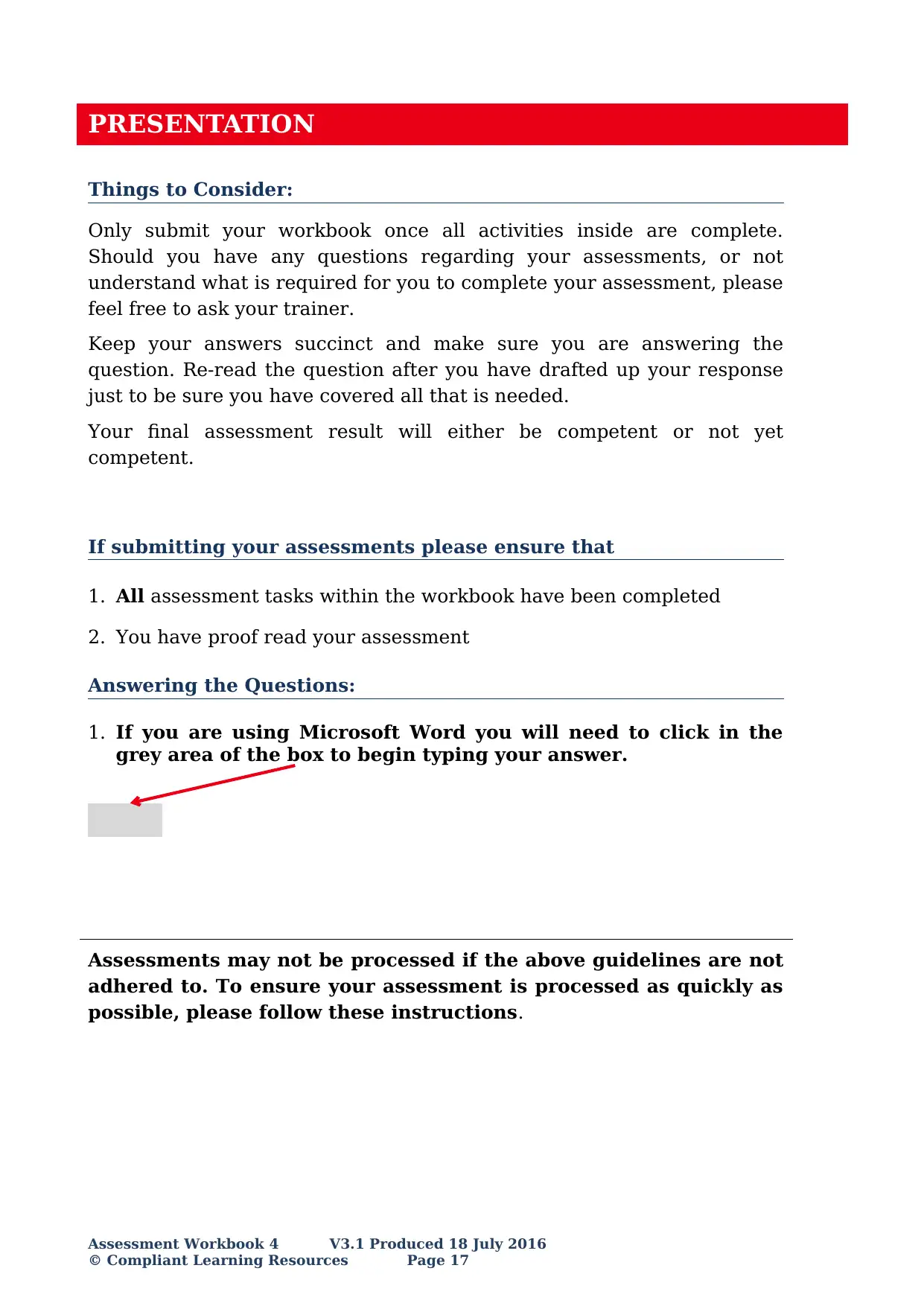
PRESENTATION
Things to Consider:
Only submit your workbook once all activities inside are complete.
Should you have any questions regarding your assessments, or not
understand what is required for you to complete your assessment, please
feel free to ask your trainer.
Keep your answers succinct and make sure you are answering the
question. Re-read the question after you have drafted up your response
just to be sure you have covered all that is needed.
Your final assessment result will either be competent or not yet
competent.
If submitting your assessments please ensure that
1. All assessment tasks within the workbook have been completed
2. You have proof read your assessment
Answering the Questions:
1. If you are using Microsoft Word you will need to click in the
grey area of the box to begin typing your answer.
Assessments may not be processed if the above guidelines are not
adhered to. To ensure your assessment is processed as quickly as
possible, please follow these instructions.
Assessment Workbook 4 V3.1 Produced 18 July 2016
© Compliant Learning Resources Page 17
Things to Consider:
Only submit your workbook once all activities inside are complete.
Should you have any questions regarding your assessments, or not
understand what is required for you to complete your assessment, please
feel free to ask your trainer.
Keep your answers succinct and make sure you are answering the
question. Re-read the question after you have drafted up your response
just to be sure you have covered all that is needed.
Your final assessment result will either be competent or not yet
competent.
If submitting your assessments please ensure that
1. All assessment tasks within the workbook have been completed
2. You have proof read your assessment
Answering the Questions:
1. If you are using Microsoft Word you will need to click in the
grey area of the box to begin typing your answer.
Assessments may not be processed if the above guidelines are not
adhered to. To ensure your assessment is processed as quickly as
possible, please follow these instructions.
Assessment Workbook 4 V3.1 Produced 18 July 2016
© Compliant Learning Resources Page 17

ASSESSMENT WORKBOOK COVERSHEET
WORKBOOK: WORKBOOK 4
TITLE: Play and Development
FIRST AND SURNAME:
PHONE:
EMAIL:
Read the Candidate Declaration below and if you agree to the
terms of the declaration sign and date in the space provided.
By submitting this work, I declare that:
I have been advised of the assessment requirements, have been made aware of my
rights and responsibilities as an assessment candidate, and choose to be assessed
at this time.
I am aware that there is a limit to the number of submissions that I can make for
each assessment and I am submitting all documents required to complete this
Assessment Workbook.
I have organised and named the files I am submitting according to the
instructions provided and I am aware that my assessor will not assess work that
cannot be clearly identified and may request the work be resubmitted according to
the correct process.
This work is my own and contains no material written by another person except
where due reference is made. I am aware that a false declaration may lead to the
withdrawal of a qualification or statement of attainment.
I am aware that there is a policy of checking the validity of qualifications that I
submit as evidence as well as the qualifications/evidence of parties who verify my
performance or observable skills. I give my consent to contact these parties for
verification purposes.
Name : Signature: Date:
Assessment Workbook 4 V3.1 Produced 18 July 2016
Page 18 © Compliant Learning Resources
WORKBOOK: WORKBOOK 4
TITLE: Play and Development
FIRST AND SURNAME:
PHONE:
EMAIL:
Read the Candidate Declaration below and if you agree to the
terms of the declaration sign and date in the space provided.
By submitting this work, I declare that:
I have been advised of the assessment requirements, have been made aware of my
rights and responsibilities as an assessment candidate, and choose to be assessed
at this time.
I am aware that there is a limit to the number of submissions that I can make for
each assessment and I am submitting all documents required to complete this
Assessment Workbook.
I have organised and named the files I am submitting according to the
instructions provided and I am aware that my assessor will not assess work that
cannot be clearly identified and may request the work be resubmitted according to
the correct process.
This work is my own and contains no material written by another person except
where due reference is made. I am aware that a false declaration may lead to the
withdrawal of a qualification or statement of attainment.
I am aware that there is a policy of checking the validity of qualifications that I
submit as evidence as well as the qualifications/evidence of parties who verify my
performance or observable skills. I give my consent to contact these parties for
verification purposes.
Name : Signature: Date:
Assessment Workbook 4 V3.1 Produced 18 July 2016
Page 18 © Compliant Learning Resources
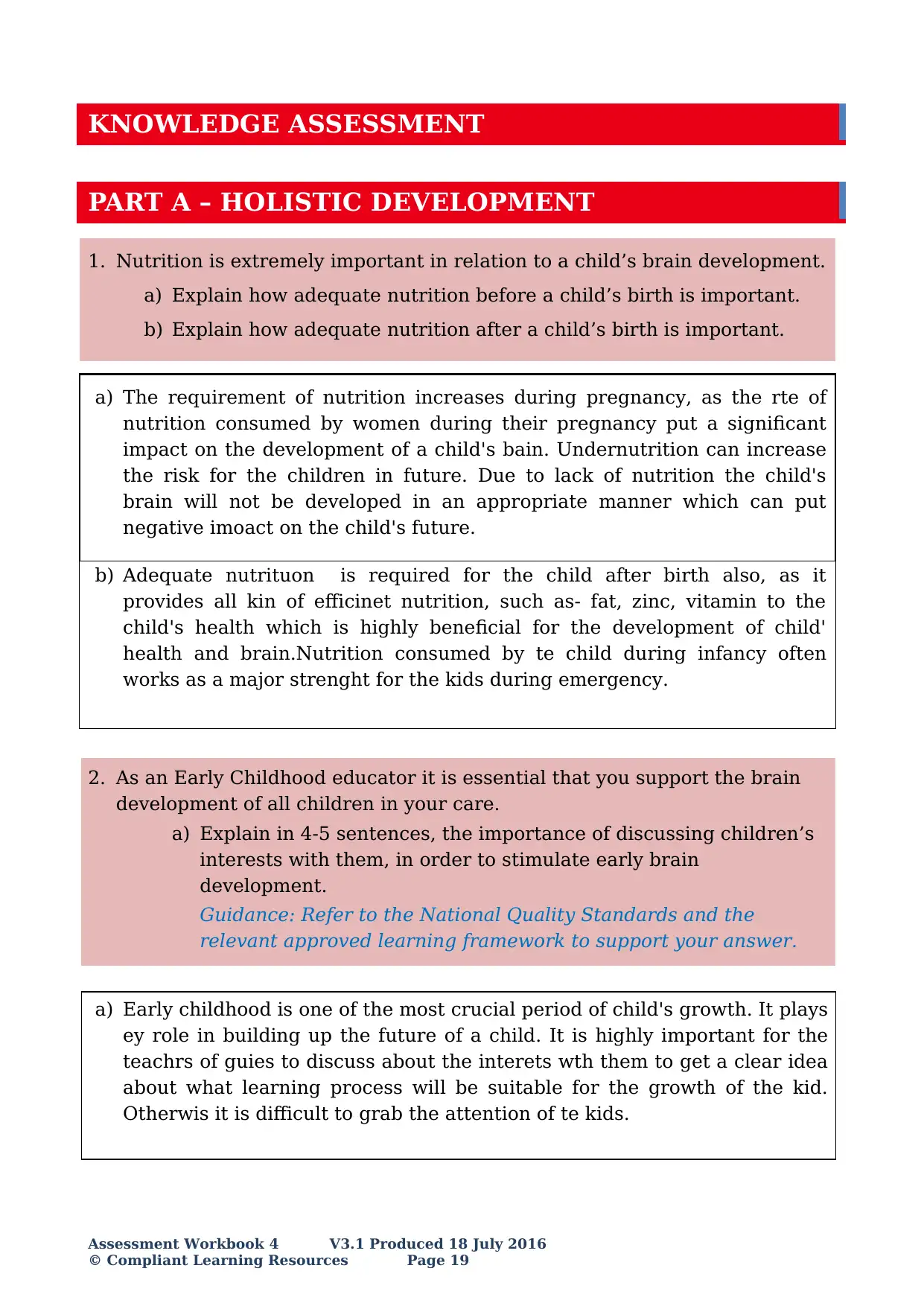
KNOWLEDGE ASSESSMENT
PART A – HOLISTIC DEVELOPMENT
1. Nutrition is extremely important in relation to a child’s brain development.
a) Explain how adequate nutrition before a child’s birth is important.
b) Explain how adequate nutrition after a child’s birth is important.
a) The requirement of nutrition increases during pregnancy, as the rte of
nutrition consumed by women during their pregnancy put a significant
impact on the development of a child's bain. Undernutrition can increase
the risk for the children in future. Due to lack of nutrition the child's
brain will not be developed in an appropriate manner which can put
negative imoact on the child's future.
b) Adequate nutrituon is required for the child after birth also, as it
provides all kin of efficinet nutrition, such as- fat, zinc, vitamin to the
child's health which is highly beneficial for the development of child'
health and brain.Nutrition consumed by te child during infancy often
works as a major strenght for the kids during emergency.
2. As an Early Childhood educator it is essential that you support the brain
development of all children in your care.
a) Explain in 4-5 sentences, the importance of discussing children’s
interests with them, in order to stimulate early brain
development.
Guidance: Refer to the National Quality Standards and the
relevant approved learning framework to support your answer.
a) Early childhood is one of the most crucial period of child's growth. It plays
ey role in building up the future of a child. It is highly important for the
teachrs of guies to discuss about the interets wth them to get a clear idea
about what learning process will be suitable for the growth of the kid.
Otherwis it is difficult to grab the attention of te kids.
Assessment Workbook 4 V3.1 Produced 18 July 2016
© Compliant Learning Resources Page 19
PART A – HOLISTIC DEVELOPMENT
1. Nutrition is extremely important in relation to a child’s brain development.
a) Explain how adequate nutrition before a child’s birth is important.
b) Explain how adequate nutrition after a child’s birth is important.
a) The requirement of nutrition increases during pregnancy, as the rte of
nutrition consumed by women during their pregnancy put a significant
impact on the development of a child's bain. Undernutrition can increase
the risk for the children in future. Due to lack of nutrition the child's
brain will not be developed in an appropriate manner which can put
negative imoact on the child's future.
b) Adequate nutrituon is required for the child after birth also, as it
provides all kin of efficinet nutrition, such as- fat, zinc, vitamin to the
child's health which is highly beneficial for the development of child'
health and brain.Nutrition consumed by te child during infancy often
works as a major strenght for the kids during emergency.
2. As an Early Childhood educator it is essential that you support the brain
development of all children in your care.
a) Explain in 4-5 sentences, the importance of discussing children’s
interests with them, in order to stimulate early brain
development.
Guidance: Refer to the National Quality Standards and the
relevant approved learning framework to support your answer.
a) Early childhood is one of the most crucial period of child's growth. It plays
ey role in building up the future of a child. It is highly important for the
teachrs of guies to discuss about the interets wth them to get a clear idea
about what learning process will be suitable for the growth of the kid.
Otherwis it is difficult to grab the attention of te kids.
Assessment Workbook 4 V3.1 Produced 18 July 2016
© Compliant Learning Resources Page 19
Paraphrase This Document
Need a fresh take? Get an instant paraphrase of this document with our AI Paraphraser
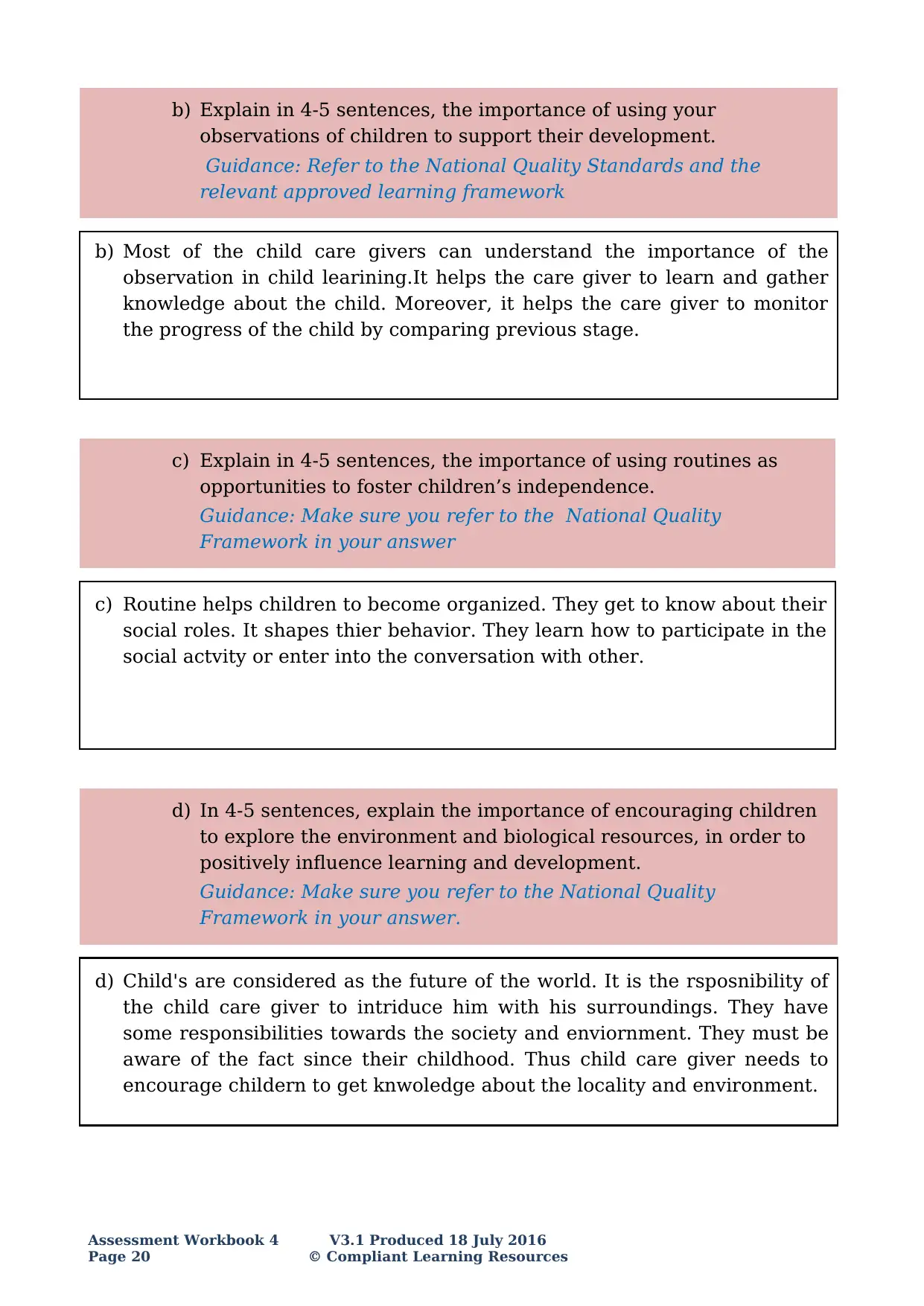
b) Explain in 4-5 sentences, the importance of using your
observations of children to support their development.
Guidance: Refer to the National Quality Standards and the
relevant approved learning framework
b) Most of the child care givers can understand the importance of the
observation in child learining.It helps the care giver to learn and gather
knowledge about the child. Moreover, it helps the care giver to monitor
the progress of the child by comparing previous stage.
c) Explain in 4-5 sentences, the importance of using routines as
opportunities to foster children’s independence.
Guidance: Make sure you refer to the National Quality
Framework in your answer
c) Routine helps children to become organized. They get to know about their
social roles. It shapes thier behavior. They learn how to participate in the
social actvity or enter into the conversation with other.
d) In 4-5 sentences, explain the importance of encouraging children
to explore the environment and biological resources, in order to
positively influence learning and development.
Guidance: Make sure you refer to the National Quality
Framework in your answer.
d) Child's are considered as the future of the world. It is the rsposnibility of
the child care giver to intriduce him with his surroundings. They have
some responsibilities towards the society and enviornment. They must be
aware of the fact since their childhood. Thus child care giver needs to
encourage childern to get knwoledge about the locality and environment.
Assessment Workbook 4 V3.1 Produced 18 July 2016
Page 20 © Compliant Learning Resources
observations of children to support their development.
Guidance: Refer to the National Quality Standards and the
relevant approved learning framework
b) Most of the child care givers can understand the importance of the
observation in child learining.It helps the care giver to learn and gather
knowledge about the child. Moreover, it helps the care giver to monitor
the progress of the child by comparing previous stage.
c) Explain in 4-5 sentences, the importance of using routines as
opportunities to foster children’s independence.
Guidance: Make sure you refer to the National Quality
Framework in your answer
c) Routine helps children to become organized. They get to know about their
social roles. It shapes thier behavior. They learn how to participate in the
social actvity or enter into the conversation with other.
d) In 4-5 sentences, explain the importance of encouraging children
to explore the environment and biological resources, in order to
positively influence learning and development.
Guidance: Make sure you refer to the National Quality
Framework in your answer.
d) Child's are considered as the future of the world. It is the rsposnibility of
the child care giver to intriduce him with his surroundings. They have
some responsibilities towards the society and enviornment. They must be
aware of the fact since their childhood. Thus child care giver needs to
encourage childern to get knwoledge about the locality and environment.
Assessment Workbook 4 V3.1 Produced 18 July 2016
Page 20 © Compliant Learning Resources
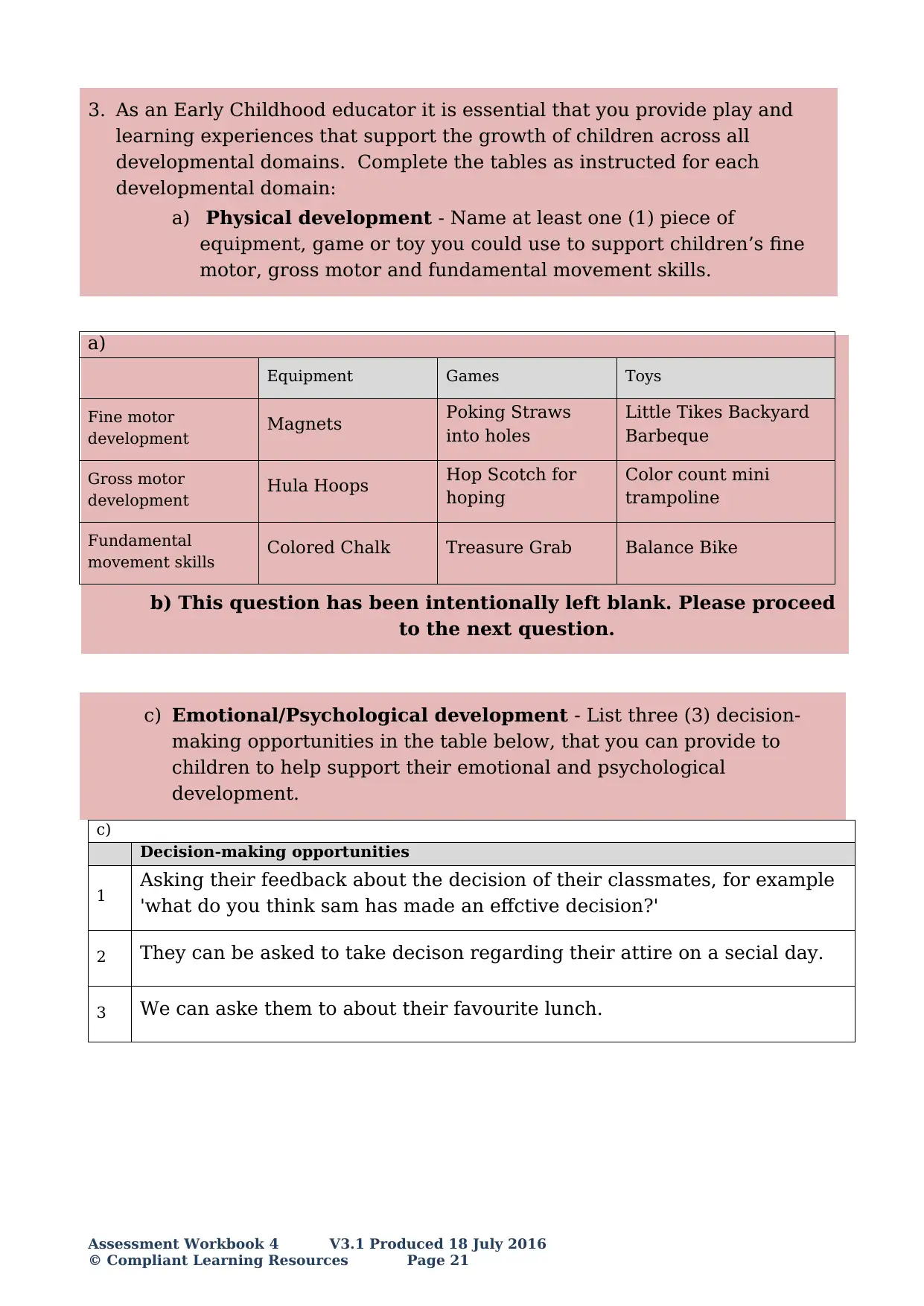
3. As an Early Childhood educator it is essential that you provide play and
learning experiences that support the growth of children across all
developmental domains. Complete the tables as instructed for each
developmental domain:
a) Physical development - Name at least one (1) piece of
equipment, game or toy you could use to support children’s fine
motor, gross motor and fundamental movement skills.
b) This question has been intentionally left blank. Please proceed
to the next question.
c) Emotional/Psychological development - List three (3) decision-
making opportunities in the table below, that you can provide to
children to help support their emotional and psychological
development.
c)
Decision-making opportunities
1 Asking their feedback about the decision of their classmates, for example
'what do you think sam has made an effctive decision?'
2 They can be asked to take decison regarding their attire on a secial day.
3 We can aske them to about their favourite lunch.
Assessment Workbook 4 V3.1 Produced 18 July 2016
© Compliant Learning Resources Page 21
a)
Equipment Games Toys
Fine motor
development Magnets Poking Straws
into holes
Little Tikes Backyard
Barbeque
Gross motor
development Hula Hoops Hop Scotch for
hoping
Color count mini
trampoline
Fundamental
movement skills Colored Chalk Treasure Grab Balance Bike
learning experiences that support the growth of children across all
developmental domains. Complete the tables as instructed for each
developmental domain:
a) Physical development - Name at least one (1) piece of
equipment, game or toy you could use to support children’s fine
motor, gross motor and fundamental movement skills.
b) This question has been intentionally left blank. Please proceed
to the next question.
c) Emotional/Psychological development - List three (3) decision-
making opportunities in the table below, that you can provide to
children to help support their emotional and psychological
development.
c)
Decision-making opportunities
1 Asking their feedback about the decision of their classmates, for example
'what do you think sam has made an effctive decision?'
2 They can be asked to take decison regarding their attire on a secial day.
3 We can aske them to about their favourite lunch.
Assessment Workbook 4 V3.1 Produced 18 July 2016
© Compliant Learning Resources Page 21
a)
Equipment Games Toys
Fine motor
development Magnets Poking Straws
into holes
Little Tikes Backyard
Barbeque
Gross motor
development Hula Hoops Hop Scotch for
hoping
Color count mini
trampoline
Fundamental
movement skills Colored Chalk Treasure Grab Balance Bike

d) Foundational Knowledge of Developmental Theory: Language
development - Complete the table below listing three (3) experiences
you can provide to children that will expose them to different forms of
language and literature and two (2) experiences that will give children
the opportunity to express themselves through language.
d)
Experiences that give exposure to a range of language forms
1 Conduct e-learning session in the class where differt type of languags
and literature will be taught in an interesting manner
2 Provide picture books and toys that can help them to learn different
languages
3 organize language learning games within the classroom
Expressive language experiences
1 Small competition among the students can be beneficial
2 Allow them to recite or deliver short speech in that particular language
e) Creative development – Fill out the table below, by indicating at
least one (1) experience you could provide for children to use each
of their senses and to express themselves in order to support their
creative development.
e)
Experience
Visual Allow them to pick suitable color to fill a particular
painting
Hearing Allow them to choose their favourite rhymes
Taste Ask them to choose best dish among several dishes
Touch by asking them which one is cold between tea and ice
Smell by asking them the difference between two flowers like
rose and orchid
Assessment Workbook 4 V3.1 Produced 18 July 2016
Page 22 © Compliant Learning Resources
development - Complete the table below listing three (3) experiences
you can provide to children that will expose them to different forms of
language and literature and two (2) experiences that will give children
the opportunity to express themselves through language.
d)
Experiences that give exposure to a range of language forms
1 Conduct e-learning session in the class where differt type of languags
and literature will be taught in an interesting manner
2 Provide picture books and toys that can help them to learn different
languages
3 organize language learning games within the classroom
Expressive language experiences
1 Small competition among the students can be beneficial
2 Allow them to recite or deliver short speech in that particular language
e) Creative development – Fill out the table below, by indicating at
least one (1) experience you could provide for children to use each
of their senses and to express themselves in order to support their
creative development.
e)
Experience
Visual Allow them to pick suitable color to fill a particular
painting
Hearing Allow them to choose their favourite rhymes
Taste Ask them to choose best dish among several dishes
Touch by asking them which one is cold between tea and ice
Smell by asking them the difference between two flowers like
rose and orchid
Assessment Workbook 4 V3.1 Produced 18 July 2016
Page 22 © Compliant Learning Resources
Secure Best Marks with AI Grader
Need help grading? Try our AI Grader for instant feedback on your assignments.
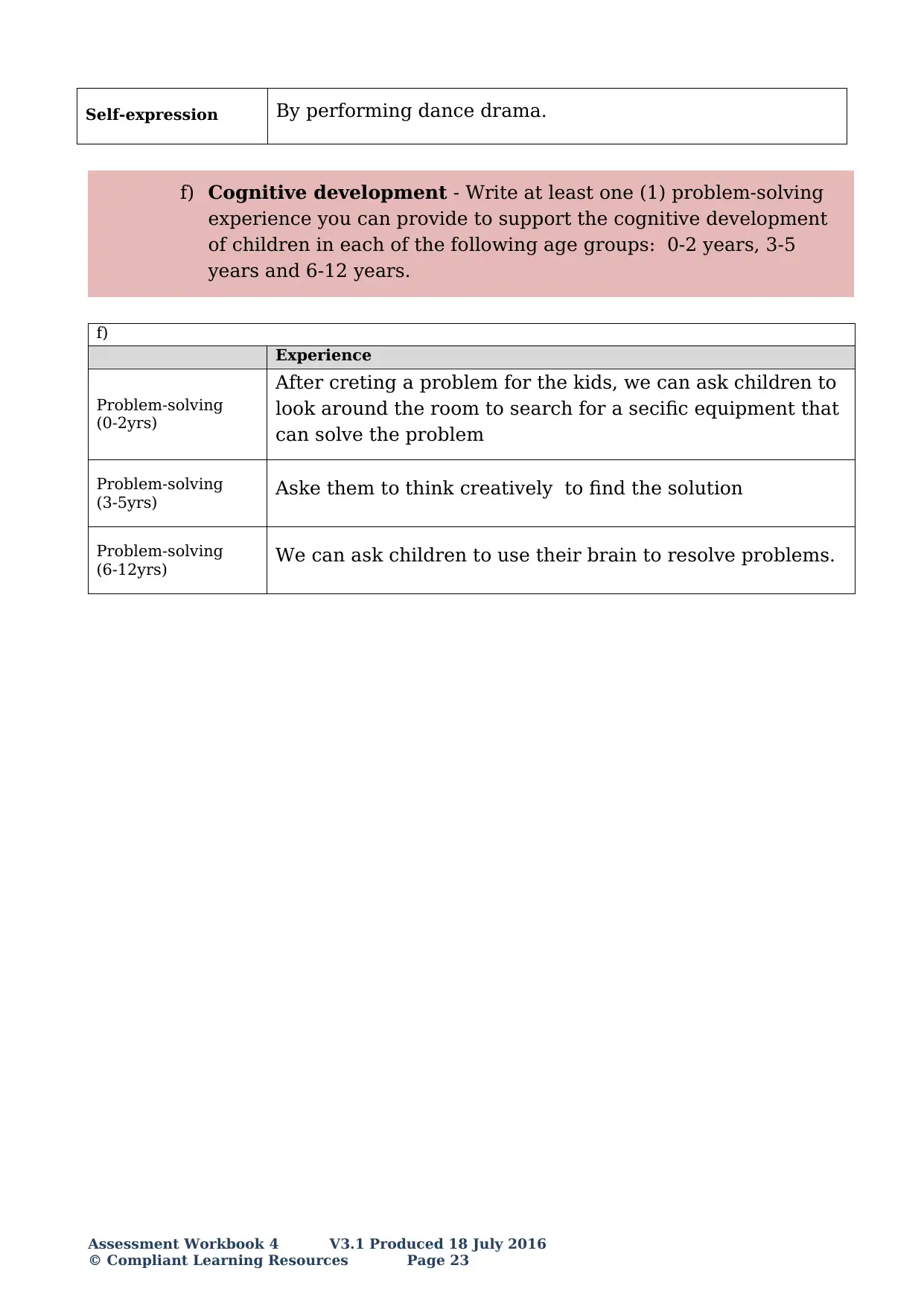
Self-expression By performing dance drama.
f) Cognitive development - Write at least one (1) problem-solving
experience you can provide to support the cognitive development
of children in each of the following age groups: 0-2 years, 3-5
years and 6-12 years.
f)
Experience
Problem-solving
(0-2yrs)
After creting a problem for the kids, we can ask children to
look around the room to search for a secific equipment that
can solve the problem
Problem-solving
(3-5yrs) Aske them to think creatively to find the solution
Problem-solving
(6-12yrs) We can ask children to use their brain to resolve problems.
Assessment Workbook 4 V3.1 Produced 18 July 2016
© Compliant Learning Resources Page 23
f) Cognitive development - Write at least one (1) problem-solving
experience you can provide to support the cognitive development
of children in each of the following age groups: 0-2 years, 3-5
years and 6-12 years.
f)
Experience
Problem-solving
(0-2yrs)
After creting a problem for the kids, we can ask children to
look around the room to search for a secific equipment that
can solve the problem
Problem-solving
(3-5yrs) Aske them to think creatively to find the solution
Problem-solving
(6-12yrs) We can ask children to use their brain to resolve problems.
Assessment Workbook 4 V3.1 Produced 18 July 2016
© Compliant Learning Resources Page 23
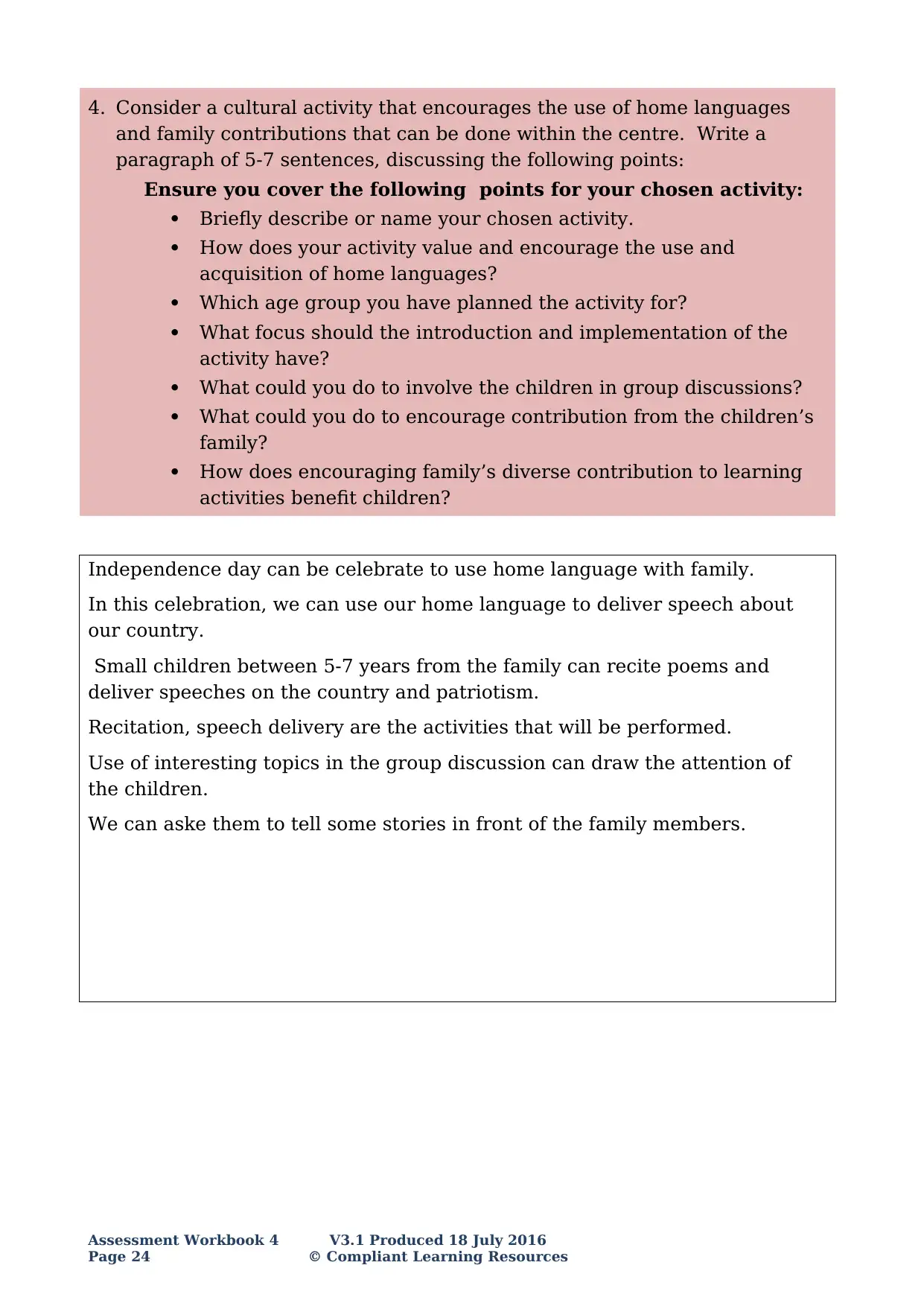
4. Consider a cultural activity that encourages the use of home languages
and family contributions that can be done within the centre. Write a
paragraph of 5-7 sentences, discussing the following points:
Ensure you cover the following points for your chosen activity:
Briefly describe or name your chosen activity.
How does your activity value and encourage the use and
acquisition of home languages?
Which age group you have planned the activity for?
What focus should the introduction and implementation of the
activity have?
What could you do to involve the children in group discussions?
What could you do to encourage contribution from the children’s
family?
How does encouraging family’s diverse contribution to learning
activities benefit children?
Independence day can be celebrate to use home language with family.
In this celebration, we can use our home language to deliver speech about
our country.
Small children between 5-7 years from the family can recite poems and
deliver speeches on the country and patriotism.
Recitation, speech delivery are the activities that will be performed.
Use of interesting topics in the group discussion can draw the attention of
the children.
We can aske them to tell some stories in front of the family members.
Assessment Workbook 4 V3.1 Produced 18 July 2016
Page 24 © Compliant Learning Resources
and family contributions that can be done within the centre. Write a
paragraph of 5-7 sentences, discussing the following points:
Ensure you cover the following points for your chosen activity:
Briefly describe or name your chosen activity.
How does your activity value and encourage the use and
acquisition of home languages?
Which age group you have planned the activity for?
What focus should the introduction and implementation of the
activity have?
What could you do to involve the children in group discussions?
What could you do to encourage contribution from the children’s
family?
How does encouraging family’s diverse contribution to learning
activities benefit children?
Independence day can be celebrate to use home language with family.
In this celebration, we can use our home language to deliver speech about
our country.
Small children between 5-7 years from the family can recite poems and
deliver speeches on the country and patriotism.
Recitation, speech delivery are the activities that will be performed.
Use of interesting topics in the group discussion can draw the attention of
the children.
We can aske them to tell some stories in front of the family members.
Assessment Workbook 4 V3.1 Produced 18 July 2016
Page 24 © Compliant Learning Resources
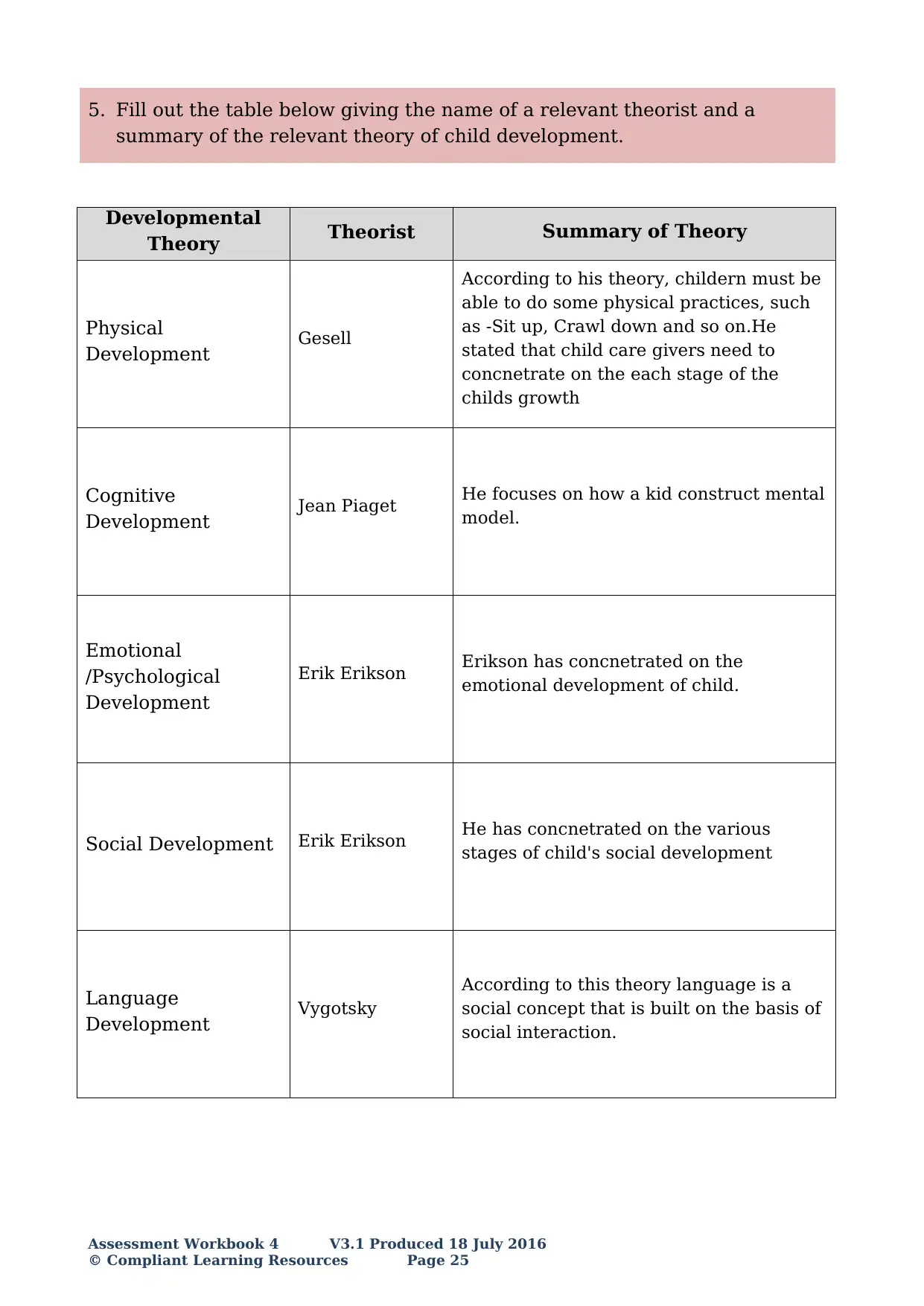
5. Fill out the table below giving the name of a relevant theorist and a
summary of the relevant theory of child development.
Developmental
Theory Theorist Summary of Theory
Physical
Development Gesell
According to his theory, childern must be
able to do some physical practices, such
as -Sit up, Crawl down and so on.He
stated that child care givers need to
concnetrate on the each stage of the
childs growth
Cognitive
Development Jean Piaget He focuses on how a kid construct mental
model.
Emotional
/Psychological
Development
Erik Erikson Erikson has concnetrated on the
emotional development of child.
Social Development Erik Erikson He has concnetrated on the various
stages of child's social development
Language
Development Vygotsky
According to this theory language is a
social concept that is built on the basis of
social interaction.
Assessment Workbook 4 V3.1 Produced 18 July 2016
© Compliant Learning Resources Page 25
summary of the relevant theory of child development.
Developmental
Theory Theorist Summary of Theory
Physical
Development Gesell
According to his theory, childern must be
able to do some physical practices, such
as -Sit up, Crawl down and so on.He
stated that child care givers need to
concnetrate on the each stage of the
childs growth
Cognitive
Development Jean Piaget He focuses on how a kid construct mental
model.
Emotional
/Psychological
Development
Erik Erikson Erikson has concnetrated on the
emotional development of child.
Social Development Erik Erikson He has concnetrated on the various
stages of child's social development
Language
Development Vygotsky
According to this theory language is a
social concept that is built on the basis of
social interaction.
Assessment Workbook 4 V3.1 Produced 18 July 2016
© Compliant Learning Resources Page 25
Paraphrase This Document
Need a fresh take? Get an instant paraphrase of this document with our AI Paraphraser
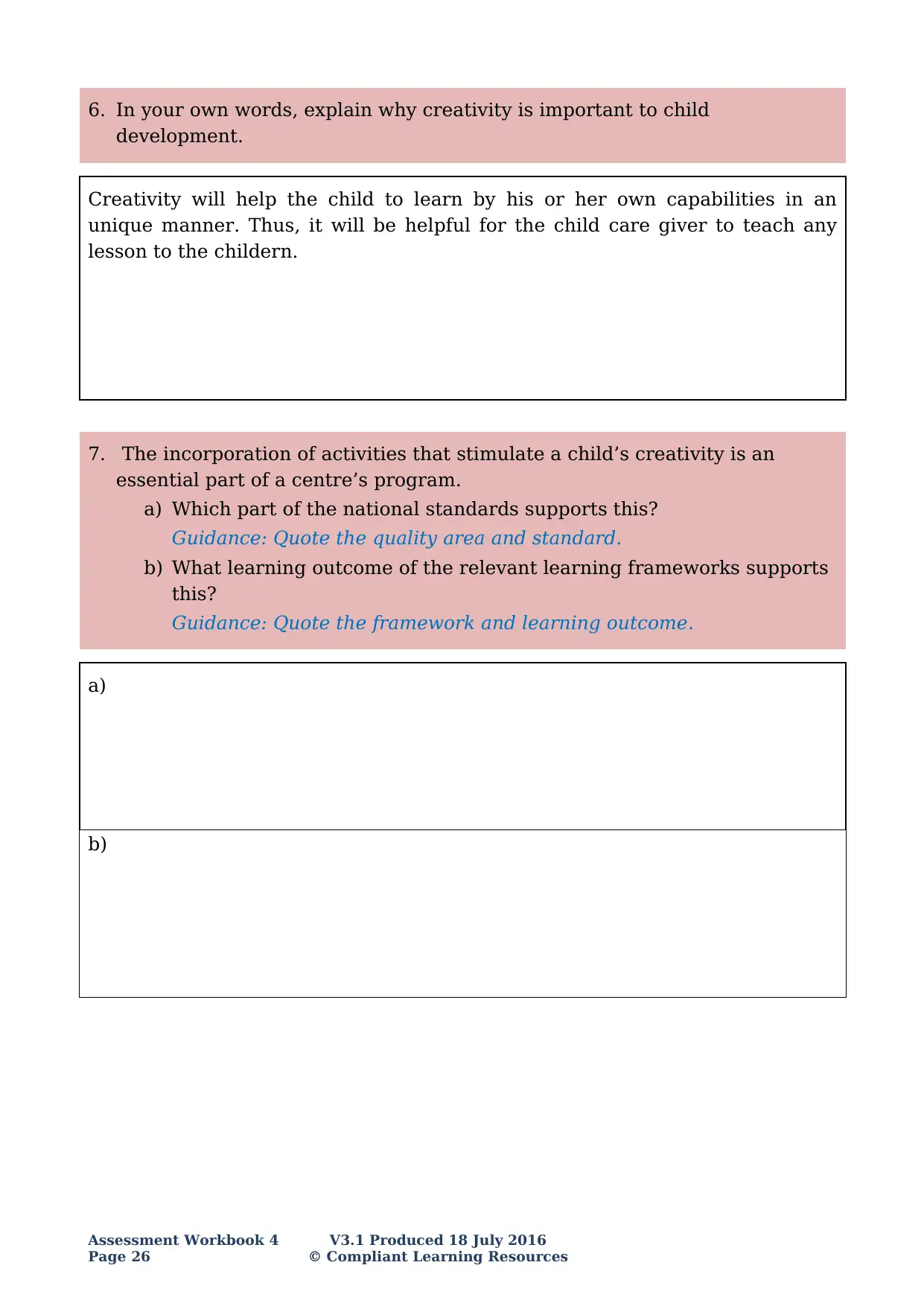
6. In your own words, explain why creativity is important to child
development.
Creativity will help the child to learn by his or her own capabilities in an
unique manner. Thus, it will be helpful for the child care giver to teach any
lesson to the childern.
7. The incorporation of activities that stimulate a child’s creativity is an
essential part of a centre’s program.
a) Which part of the national standards supports this?
Guidance: Quote the quality area and standard.
b) What learning outcome of the relevant learning frameworks supports
this?
Guidance: Quote the framework and learning outcome.
a)
b)
Assessment Workbook 4 V3.1 Produced 18 July 2016
Page 26 © Compliant Learning Resources
development.
Creativity will help the child to learn by his or her own capabilities in an
unique manner. Thus, it will be helpful for the child care giver to teach any
lesson to the childern.
7. The incorporation of activities that stimulate a child’s creativity is an
essential part of a centre’s program.
a) Which part of the national standards supports this?
Guidance: Quote the quality area and standard.
b) What learning outcome of the relevant learning frameworks supports
this?
Guidance: Quote the framework and learning outcome.
a)
b)
Assessment Workbook 4 V3.1 Produced 18 July 2016
Page 26 © Compliant Learning Resources

8. Describe in your own words:
a) What is Blooms Taxonomy?
b) What are the six cognitive skills revised by Krathwohl in 2000?
a) Bloom's Taxonomy is a framework that reflects the higher form of thinking.
b) Knowledge, comprehension, application, analysis, synthesis, evaluation
9. Describe in your own words:
a) Who proposed Multiple Intelligence Theory?
b) How could you include it in learning experiences?
c) What are the nine intelligences?
a) Dr. Haward Gardner.
b) This can be used to enhance te different skills and intelligence of the kinds
Assessment Workbook 4 V3.1 Produced 18 July 2016
© Compliant Learning Resources Page 27
a) What is Blooms Taxonomy?
b) What are the six cognitive skills revised by Krathwohl in 2000?
a) Bloom's Taxonomy is a framework that reflects the higher form of thinking.
b) Knowledge, comprehension, application, analysis, synthesis, evaluation
9. Describe in your own words:
a) Who proposed Multiple Intelligence Theory?
b) How could you include it in learning experiences?
c) What are the nine intelligences?
a) Dr. Haward Gardner.
b) This can be used to enhance te different skills and intelligence of the kinds
Assessment Workbook 4 V3.1 Produced 18 July 2016
© Compliant Learning Resources Page 27
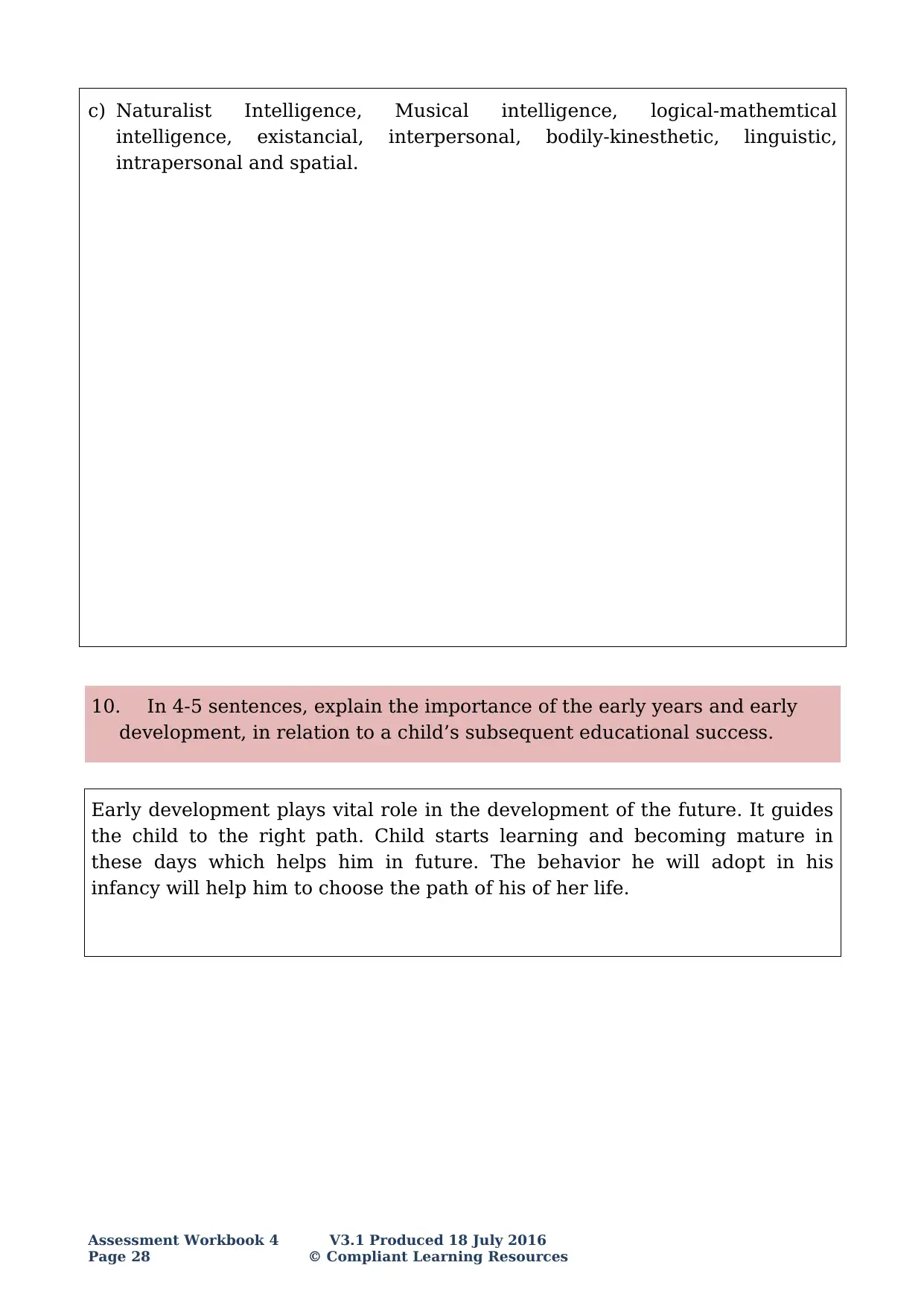
c) Naturalist Intelligence, Musical intelligence, logical-mathemtical
intelligence, existancial, interpersonal, bodily-kinesthetic, linguistic,
intrapersonal and spatial.
10. In 4-5 sentences, explain the importance of the early years and early
development, in relation to a child’s subsequent educational success.
Early development plays vital role in the development of the future. It guides
the child to the right path. Child starts learning and becoming mature in
these days which helps him in future. The behavior he will adopt in his
infancy will help him to choose the path of his of her life.
Assessment Workbook 4 V3.1 Produced 18 July 2016
Page 28 © Compliant Learning Resources
intelligence, existancial, interpersonal, bodily-kinesthetic, linguistic,
intrapersonal and spatial.
10. In 4-5 sentences, explain the importance of the early years and early
development, in relation to a child’s subsequent educational success.
Early development plays vital role in the development of the future. It guides
the child to the right path. Child starts learning and becoming mature in
these days which helps him in future. The behavior he will adopt in his
infancy will help him to choose the path of his of her life.
Assessment Workbook 4 V3.1 Produced 18 July 2016
Page 28 © Compliant Learning Resources
Secure Best Marks with AI Grader
Need help grading? Try our AI Grader for instant feedback on your assignments.

11. Fill out the table below in relation to aspects of poor early childhood
development and the potential long term impacts it can have on a child.
Aspects of poor early
childhood development
Long term harmful impacts
Poor Diet
Lack of Play Lack of physical development
Limited Stimulation of brain development
Lack of Materials and
resources Lack of proper nutrition and growth
Inconsistent or non-existent emotional support or comfort
Trauma Permanent negative impact on the memory
Assessment Workbook 4 V3.1 Produced 18 July 2016
© Compliant Learning Resources Page 29
development and the potential long term impacts it can have on a child.
Aspects of poor early
childhood development
Long term harmful impacts
Poor Diet
Lack of Play Lack of physical development
Limited Stimulation of brain development
Lack of Materials and
resources Lack of proper nutrition and growth
Inconsistent or non-existent emotional support or comfort
Trauma Permanent negative impact on the memory
Assessment Workbook 4 V3.1 Produced 18 July 2016
© Compliant Learning Resources Page 29
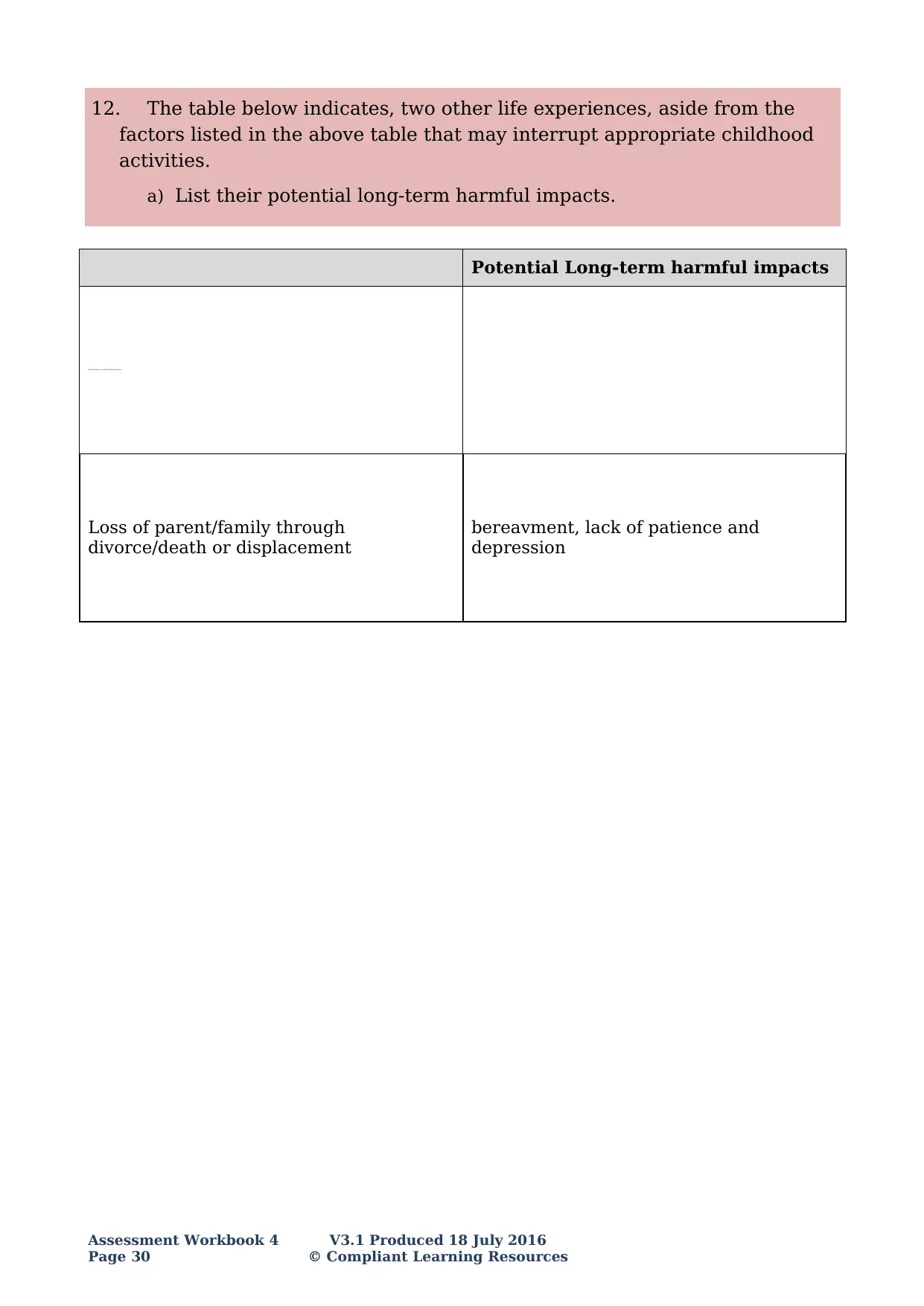
12. The table below indicates, two other life experiences, aside from the
factors listed in the above table that may interrupt appropriate childhood
activities.
a) List their potential long-term harmful impacts.
Potential Long-term harmful impacts
Serious illness or condition/hospitalisation
Loss of parent/family through
divorce/death or displacement
bereavment, lack of patience and
depression
Assessment Workbook 4 V3.1 Produced 18 July 2016
Page 30 © Compliant Learning Resources
factors listed in the above table that may interrupt appropriate childhood
activities.
a) List their potential long-term harmful impacts.
Potential Long-term harmful impacts
Serious illness or condition/hospitalisation
Loss of parent/family through
divorce/death or displacement
bereavment, lack of patience and
depression
Assessment Workbook 4 V3.1 Produced 18 July 2016
Page 30 © Compliant Learning Resources
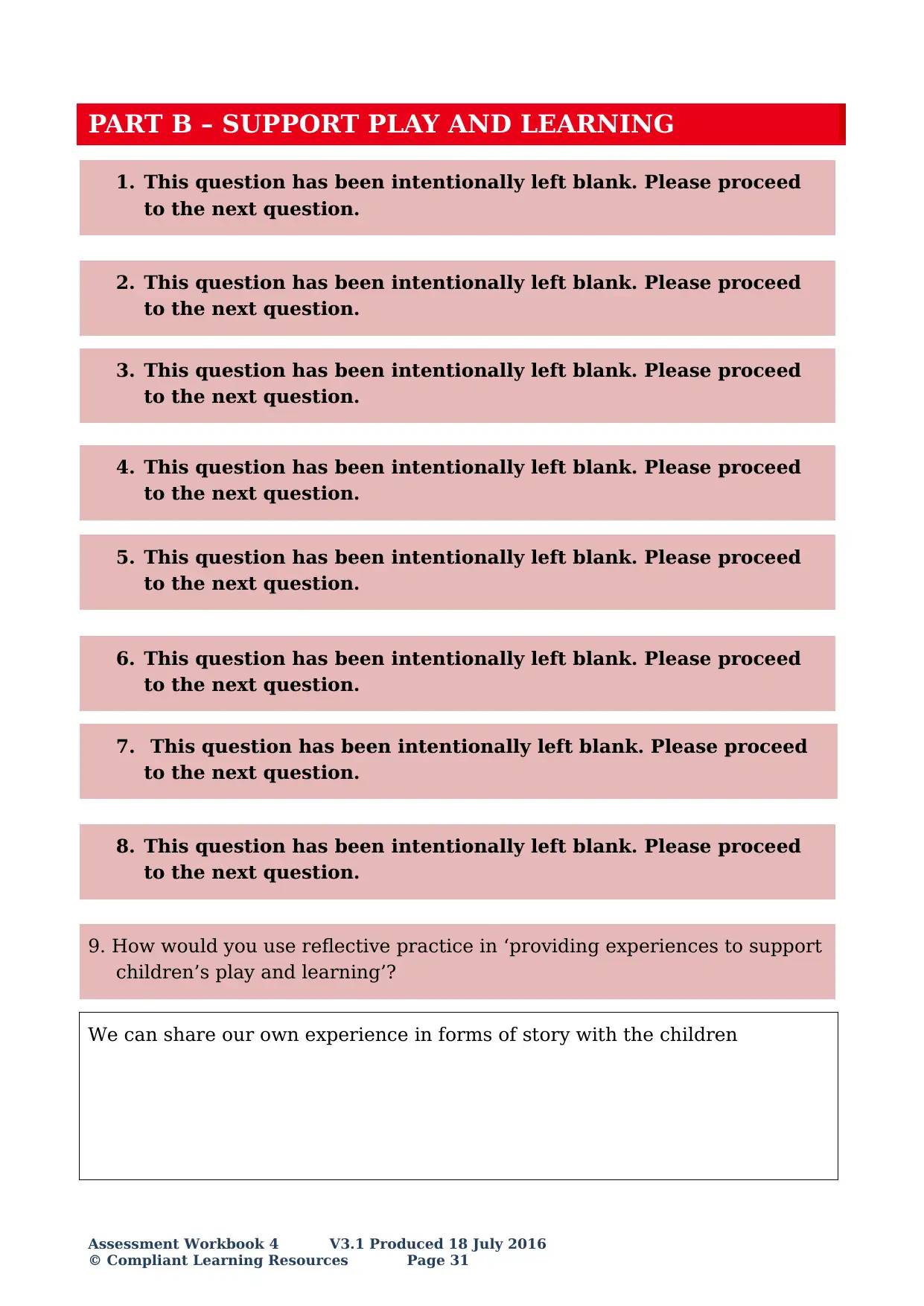
PART B – SUPPORT PLAY AND LEARNING
1. This question has been intentionally left blank. Please proceed
to the next question.
2. This question has been intentionally left blank. Please proceed
to the next question.
3. This question has been intentionally left blank. Please proceed
to the next question.
4. This question has been intentionally left blank. Please proceed
to the next question.
5. This question has been intentionally left blank. Please proceed
to the next question.
6. This question has been intentionally left blank. Please proceed
to the next question.
7. This question has been intentionally left blank. Please proceed
to the next question.
8. This question has been intentionally left blank. Please proceed
to the next question.
9. How would you use reflective practice in ‘providing experiences to support
children’s play and learning’?
We can share our own experience in forms of story with the children
Assessment Workbook 4 V3.1 Produced 18 July 2016
© Compliant Learning Resources Page 31
1. This question has been intentionally left blank. Please proceed
to the next question.
2. This question has been intentionally left blank. Please proceed
to the next question.
3. This question has been intentionally left blank. Please proceed
to the next question.
4. This question has been intentionally left blank. Please proceed
to the next question.
5. This question has been intentionally left blank. Please proceed
to the next question.
6. This question has been intentionally left blank. Please proceed
to the next question.
7. This question has been intentionally left blank. Please proceed
to the next question.
8. This question has been intentionally left blank. Please proceed
to the next question.
9. How would you use reflective practice in ‘providing experiences to support
children’s play and learning’?
We can share our own experience in forms of story with the children
Assessment Workbook 4 V3.1 Produced 18 July 2016
© Compliant Learning Resources Page 31
Paraphrase This Document
Need a fresh take? Get an instant paraphrase of this document with our AI Paraphraser
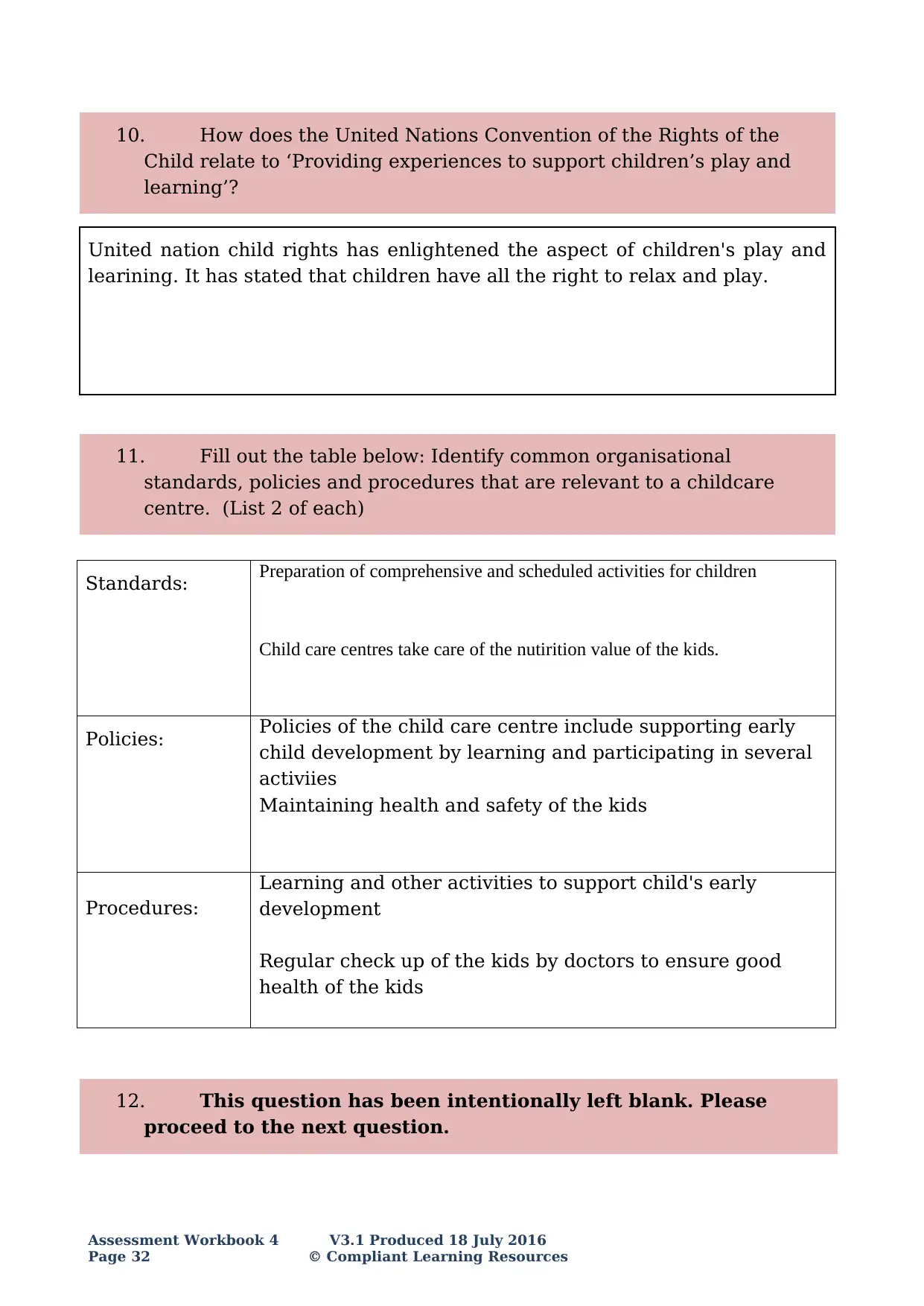
10. How does the United Nations Convention of the Rights of the
Child relate to ‘Providing experiences to support children’s play and
learning’?
United nation child rights has enlightened the aspect of children's play and
learining. It has stated that children have all the right to relax and play.
11. Fill out the table below: Identify common organisational
standards, policies and procedures that are relevant to a childcare
centre. (List 2 of each)
Standards: Preparation of comprehensive and scheduled activities for children
Child care centres take care of the nutirition value of the kids.
Policies: Policies of the child care centre include supporting early
child development by learning and participating in several
activiies
Maintaining health and safety of the kids
Procedures:
Learning and other activities to support child's early
development
Regular check up of the kids by doctors to ensure good
health of the kids
12. This question has been intentionally left blank. Please
proceed to the next question.
Assessment Workbook 4 V3.1 Produced 18 July 2016
Page 32 © Compliant Learning Resources
Child relate to ‘Providing experiences to support children’s play and
learning’?
United nation child rights has enlightened the aspect of children's play and
learining. It has stated that children have all the right to relax and play.
11. Fill out the table below: Identify common organisational
standards, policies and procedures that are relevant to a childcare
centre. (List 2 of each)
Standards: Preparation of comprehensive and scheduled activities for children
Child care centres take care of the nutirition value of the kids.
Policies: Policies of the child care centre include supporting early
child development by learning and participating in several
activiies
Maintaining health and safety of the kids
Procedures:
Learning and other activities to support child's early
development
Regular check up of the kids by doctors to ensure good
health of the kids
12. This question has been intentionally left blank. Please
proceed to the next question.
Assessment Workbook 4 V3.1 Produced 18 July 2016
Page 32 © Compliant Learning Resources

PART C – USE INFORMATION ABOUT CHILDREN
1. Fill out the table below in relation to the United Nations Convention of
the Rights of the Child and Code of Ethics and explain the purpose of
each.
Guidance: Access the United Nations Convention Website and the Early
Childhood Australia Code of Ethics website.
Purpose
United Nations
Convention of the
Rights of the Child
The purpose of the convention is to motivate adults
and government to work togehter to support the
growth of the children.
Early Childhood
Australia Code of
ethics
it has provided a vivid idea to the child care givers
about their expected behavior
2. Which section of the Educators Guide to the EYLF refers to using
theories of child development, in order to analyse information and plan
accordingly? Note the page numbers of this section.
3. Which section of the Educators Guide to the MTOP refers to using
theories of child development, in order to analyse information and plan
accordingly? Note the page numbers of this section.
Assessment Workbook 4 V3.1 Produced 18 July 2016
© Compliant Learning Resources Page 33
1. Fill out the table below in relation to the United Nations Convention of
the Rights of the Child and Code of Ethics and explain the purpose of
each.
Guidance: Access the United Nations Convention Website and the Early
Childhood Australia Code of Ethics website.
Purpose
United Nations
Convention of the
Rights of the Child
The purpose of the convention is to motivate adults
and government to work togehter to support the
growth of the children.
Early Childhood
Australia Code of
ethics
it has provided a vivid idea to the child care givers
about their expected behavior
2. Which section of the Educators Guide to the EYLF refers to using
theories of child development, in order to analyse information and plan
accordingly? Note the page numbers of this section.
3. Which section of the Educators Guide to the MTOP refers to using
theories of child development, in order to analyse information and plan
accordingly? Note the page numbers of this section.
Assessment Workbook 4 V3.1 Produced 18 July 2016
© Compliant Learning Resources Page 33
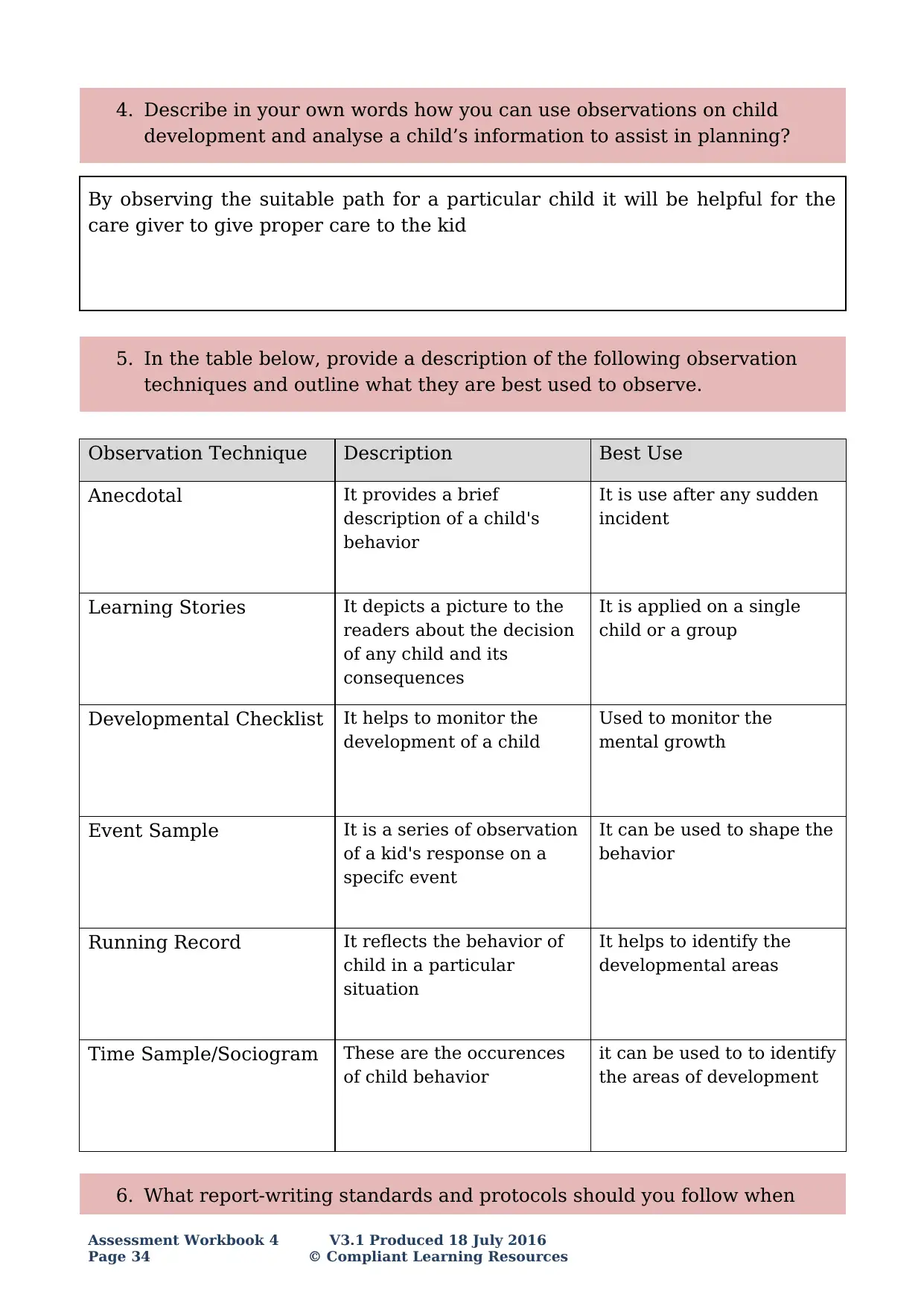
4. Describe in your own words how you can use observations on child
development and analyse a child’s information to assist in planning?
By observing the suitable path for a particular child it will be helpful for the
care giver to give proper care to the kid
5. In the table below, provide a description of the following observation
techniques and outline what they are best used to observe.
Observation Technique Description Best Use
Anecdotal It provides a brief
description of a child's
behavior
It is use after any sudden
incident
Learning Stories It depicts a picture to the
readers about the decision
of any child and its
consequences
It is applied on a single
child or a group
Developmental Checklist It helps to monitor the
development of a child
Used to monitor the
mental growth
Event Sample It is a series of observation
of a kid's response on a
specifc event
It can be used to shape the
behavior
Running Record It reflects the behavior of
child in a particular
situation
It helps to identify the
developmental areas
Time Sample/Sociogram These are the occurences
of child behavior
it can be used to to identify
the areas of development
6. What report-writing standards and protocols should you follow when
Assessment Workbook 4 V3.1 Produced 18 July 2016
Page 34 © Compliant Learning Resources
development and analyse a child’s information to assist in planning?
By observing the suitable path for a particular child it will be helpful for the
care giver to give proper care to the kid
5. In the table below, provide a description of the following observation
techniques and outline what they are best used to observe.
Observation Technique Description Best Use
Anecdotal It provides a brief
description of a child's
behavior
It is use after any sudden
incident
Learning Stories It depicts a picture to the
readers about the decision
of any child and its
consequences
It is applied on a single
child or a group
Developmental Checklist It helps to monitor the
development of a child
Used to monitor the
mental growth
Event Sample It is a series of observation
of a kid's response on a
specifc event
It can be used to shape the
behavior
Running Record It reflects the behavior of
child in a particular
situation
It helps to identify the
developmental areas
Time Sample/Sociogram These are the occurences
of child behavior
it can be used to to identify
the areas of development
6. What report-writing standards and protocols should you follow when
Assessment Workbook 4 V3.1 Produced 18 July 2016
Page 34 © Compliant Learning Resources
Secure Best Marks with AI Grader
Need help grading? Try our AI Grader for instant feedback on your assignments.

writing observation reports?
Ancedotal records, running records and learning stories
7. There are certain organisational standards, policies and procedures that
are relevant to the gathering of information about a child to inform
practice.
a) Name the relevant standard, frameworks, convention and code
that applies. (There are five in total).
a) Relationship with kids
b) Name the relevant policies.
b) Respectful relation are made and maintained with each child
c) Name the relevant procedures.
c) collaborative partnership with family
Assessment Workbook 4 V3.1 Produced 18 July 2016
© Compliant Learning Resources Page 35
Ancedotal records, running records and learning stories
7. There are certain organisational standards, policies and procedures that
are relevant to the gathering of information about a child to inform
practice.
a) Name the relevant standard, frameworks, convention and code
that applies. (There are five in total).
a) Relationship with kids
b) Name the relevant policies.
b) Respectful relation are made and maintained with each child
c) Name the relevant procedures.
c) collaborative partnership with family
Assessment Workbook 4 V3.1 Produced 18 July 2016
© Compliant Learning Resources Page 35
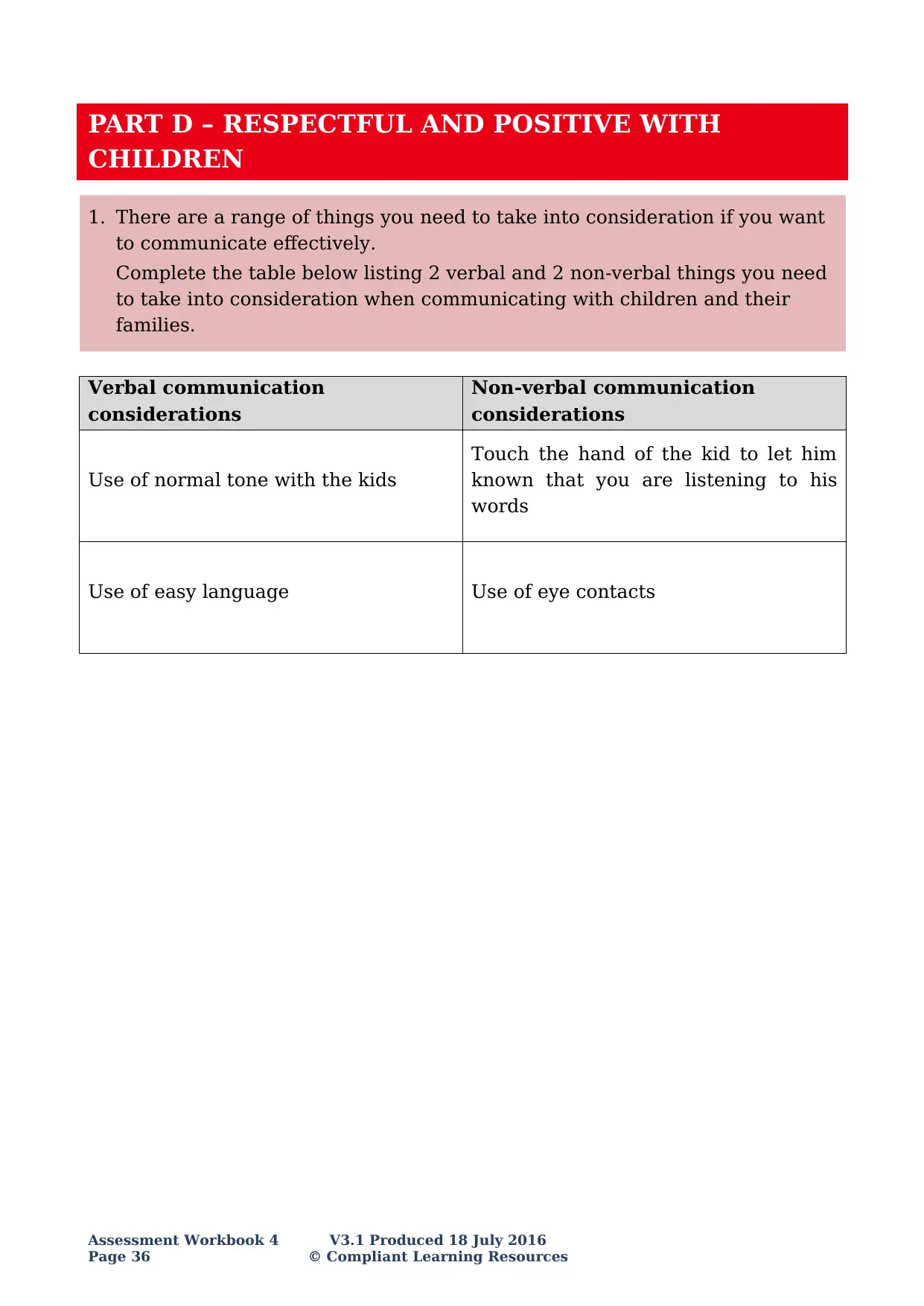
PART D – RESPECTFUL AND POSITIVE WITH
CHILDREN
1. There are a range of things you need to take into consideration if you want
to communicate effectively.
Complete the table below listing 2 verbal and 2 non-verbal things you need
to take into consideration when communicating with children and their
families.
Verbal communication
considerations
Non-verbal communication
considerations
Use of normal tone with the kids
Touch the hand of the kid to let him
known that you are listening to his
words
Use of easy language Use of eye contacts
Assessment Workbook 4 V3.1 Produced 18 July 2016
Page 36 © Compliant Learning Resources
CHILDREN
1. There are a range of things you need to take into consideration if you want
to communicate effectively.
Complete the table below listing 2 verbal and 2 non-verbal things you need
to take into consideration when communicating with children and their
families.
Verbal communication
considerations
Non-verbal communication
considerations
Use of normal tone with the kids
Touch the hand of the kid to let him
known that you are listening to his
words
Use of easy language Use of eye contacts
Assessment Workbook 4 V3.1 Produced 18 July 2016
Page 36 © Compliant Learning Resources
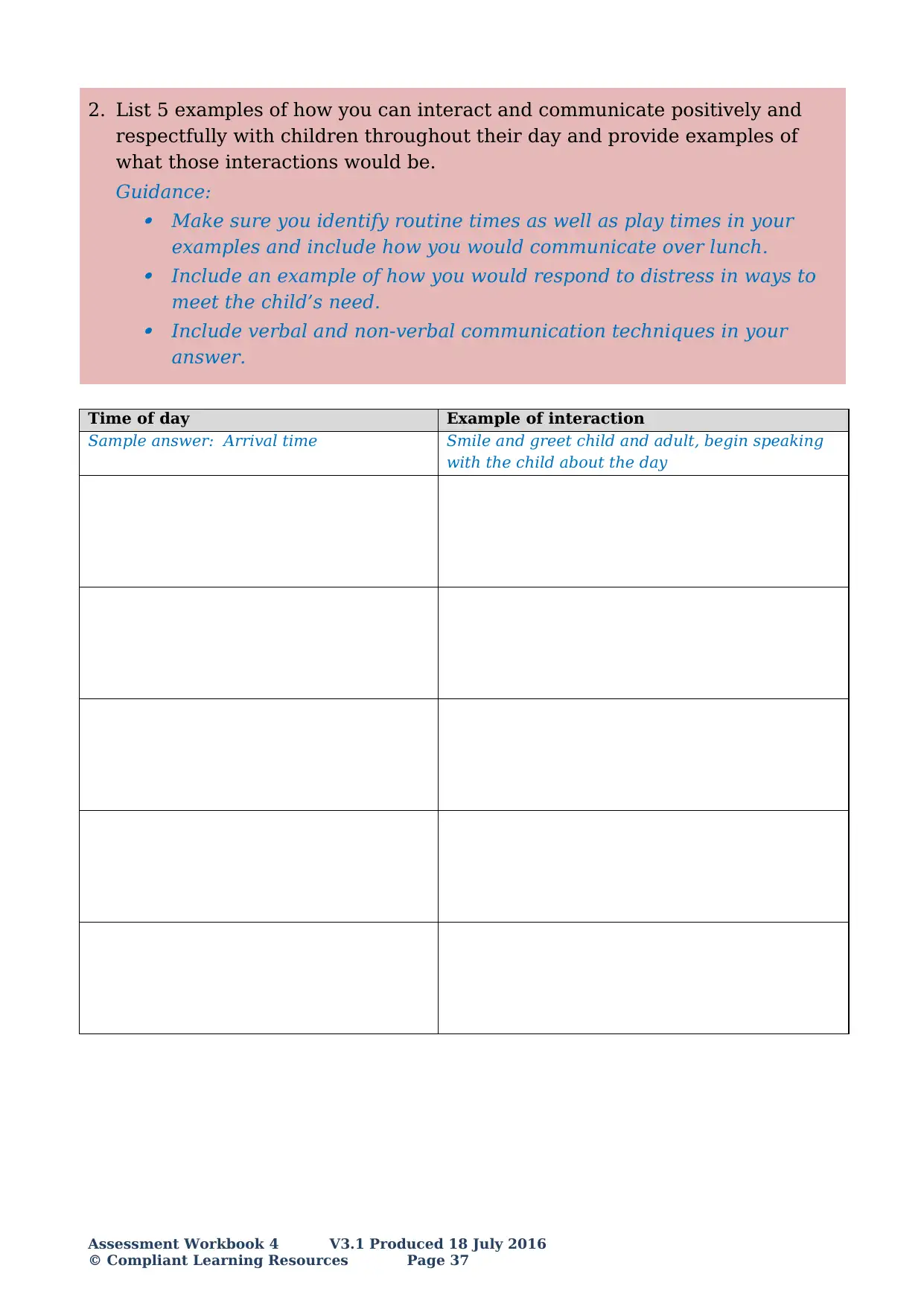
2. List 5 examples of how you can interact and communicate positively and
respectfully with children throughout their day and provide examples of
what those interactions would be.
Guidance:
Make sure you identify routine times as well as play times in your
examples and include how you would communicate over lunch.
Include an example of how you would respond to distress in ways to
meet the child’s need.
Include verbal and non-verbal communication techniques in your
answer.
Time of day Example of interaction
Sample answer: Arrival time Smile and greet child and adult, begin speaking
with the child about the day
Assessment Workbook 4 V3.1 Produced 18 July 2016
© Compliant Learning Resources Page 37
respectfully with children throughout their day and provide examples of
what those interactions would be.
Guidance:
Make sure you identify routine times as well as play times in your
examples and include how you would communicate over lunch.
Include an example of how you would respond to distress in ways to
meet the child’s need.
Include verbal and non-verbal communication techniques in your
answer.
Time of day Example of interaction
Sample answer: Arrival time Smile and greet child and adult, begin speaking
with the child about the day
Assessment Workbook 4 V3.1 Produced 18 July 2016
© Compliant Learning Resources Page 37
Paraphrase This Document
Need a fresh take? Get an instant paraphrase of this document with our AI Paraphraser
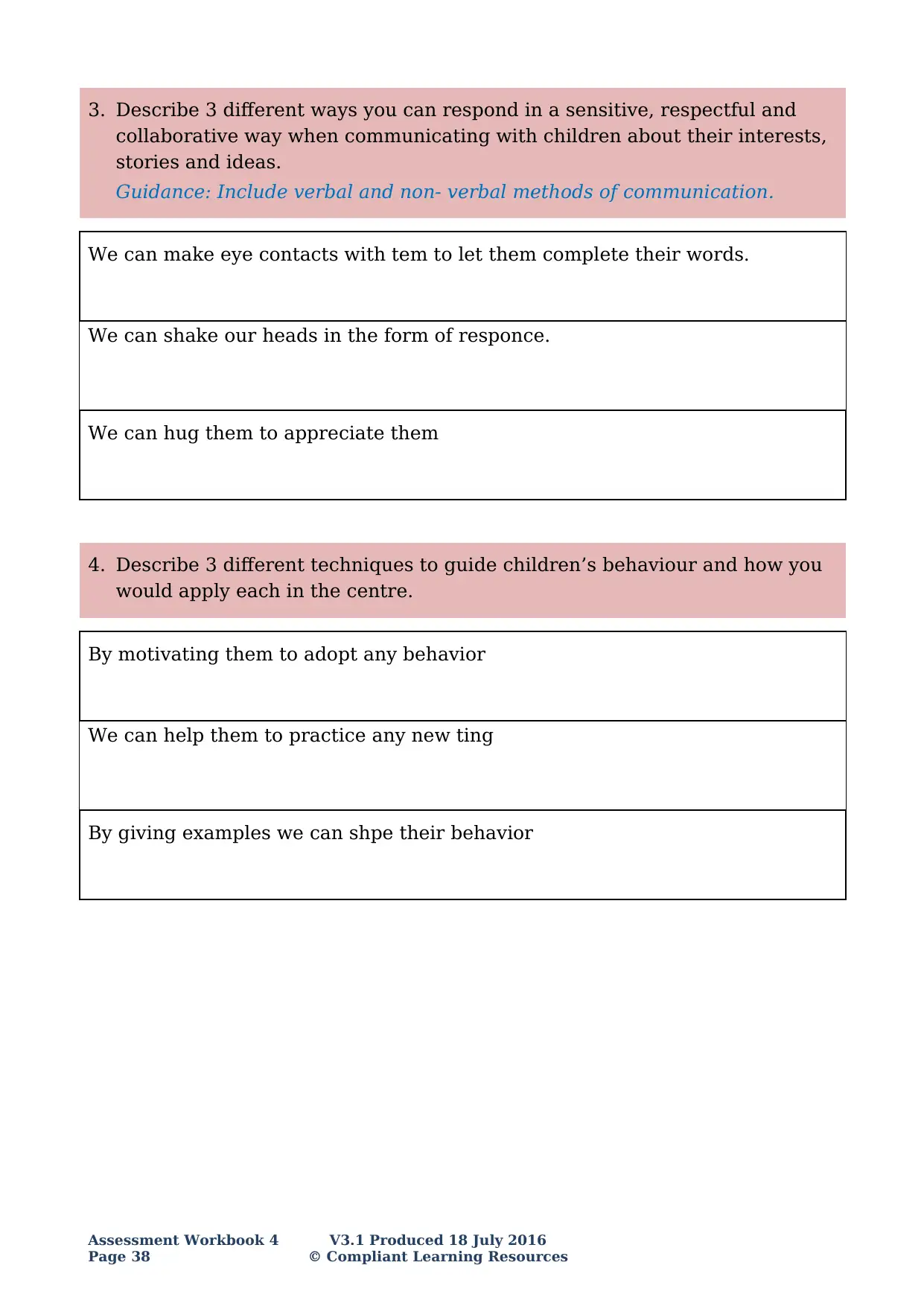
3. Describe 3 different ways you can respond in a sensitive, respectful and
collaborative way when communicating with children about their interests,
stories and ideas.
Guidance: Include verbal and non- verbal methods of communication.
We can make eye contacts with tem to let them complete their words.
We can shake our heads in the form of responce.
We can hug them to appreciate them
4. Describe 3 different techniques to guide children’s behaviour and how you
would apply each in the centre.
By motivating them to adopt any behavior
We can help them to practice any new ting
By giving examples we can shpe their behavior
Assessment Workbook 4 V3.1 Produced 18 July 2016
Page 38 © Compliant Learning Resources
collaborative way when communicating with children about their interests,
stories and ideas.
Guidance: Include verbal and non- verbal methods of communication.
We can make eye contacts with tem to let them complete their words.
We can shake our heads in the form of responce.
We can hug them to appreciate them
4. Describe 3 different techniques to guide children’s behaviour and how you
would apply each in the centre.
By motivating them to adopt any behavior
We can help them to practice any new ting
By giving examples we can shpe their behavior
Assessment Workbook 4 V3.1 Produced 18 July 2016
Page 38 © Compliant Learning Resources
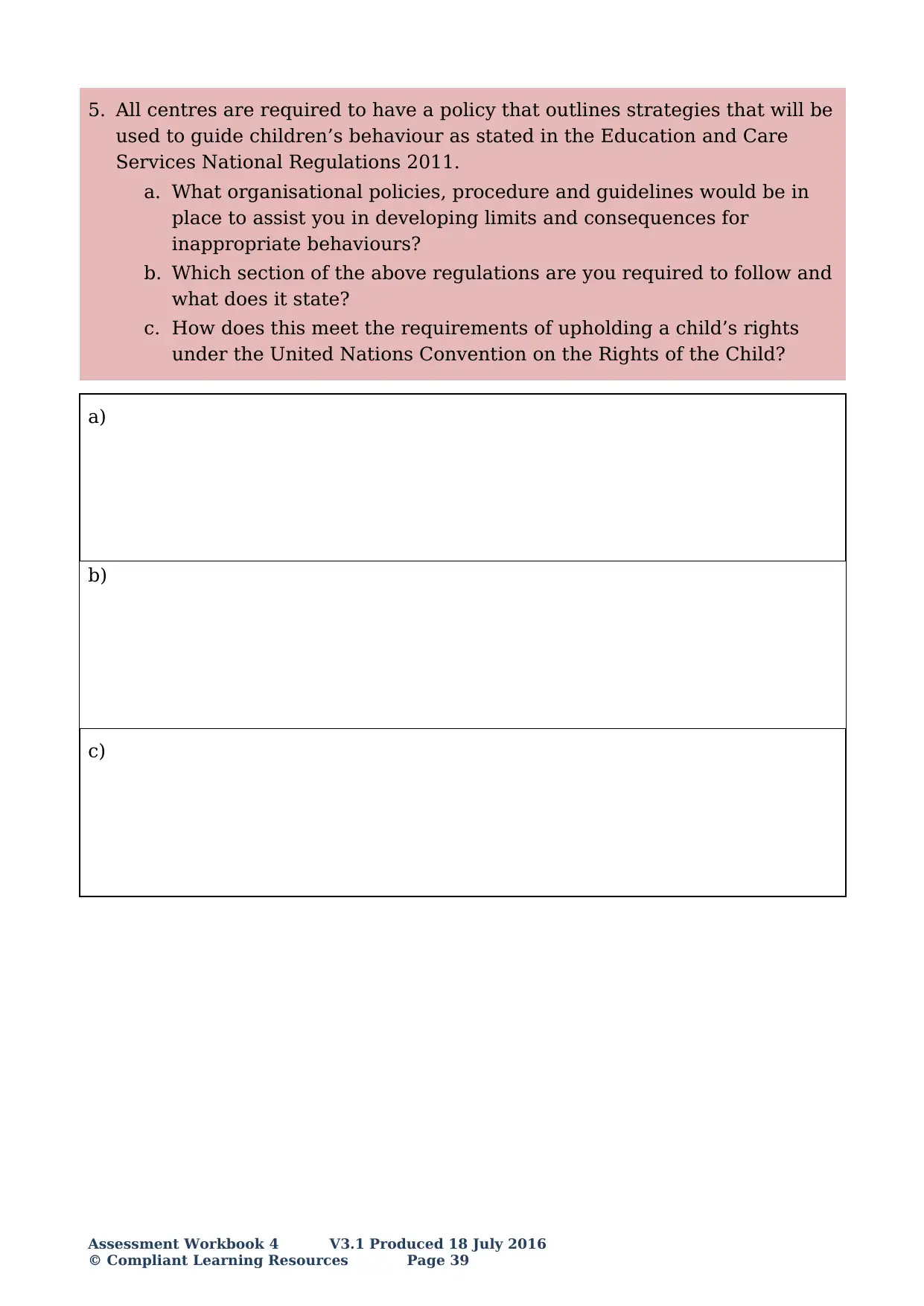
5. All centres are required to have a policy that outlines strategies that will be
used to guide children’s behaviour as stated in the Education and Care
Services National Regulations 2011.
a. What organisational policies, procedure and guidelines would be in
place to assist you in developing limits and consequences for
inappropriate behaviours?
b. Which section of the above regulations are you required to follow and
what does it state?
c. How does this meet the requirements of upholding a child’s rights
under the United Nations Convention on the Rights of the Child?
a)
b)
c)
Assessment Workbook 4 V3.1 Produced 18 July 2016
© Compliant Learning Resources Page 39
used to guide children’s behaviour as stated in the Education and Care
Services National Regulations 2011.
a. What organisational policies, procedure and guidelines would be in
place to assist you in developing limits and consequences for
inappropriate behaviours?
b. Which section of the above regulations are you required to follow and
what does it state?
c. How does this meet the requirements of upholding a child’s rights
under the United Nations Convention on the Rights of the Child?
a)
b)
c)
Assessment Workbook 4 V3.1 Produced 18 July 2016
© Compliant Learning Resources Page 39
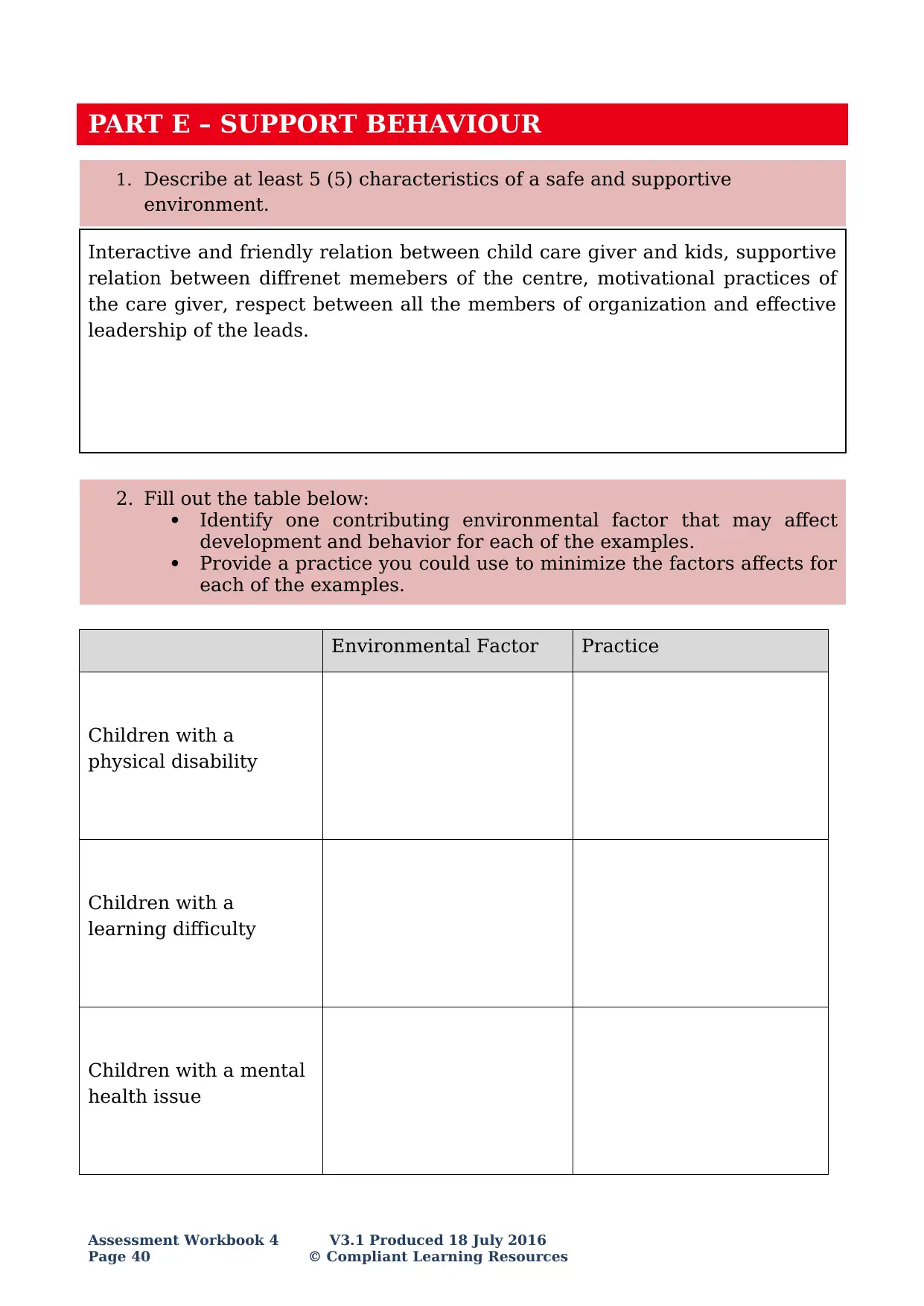
PART E – SUPPORT BEHAVIOUR
1. Describe at least 5 (5) characteristics of a safe and supportive
environment.
Interactive and friendly relation between child care giver and kids, supportive
relation between diffrenet memebers of the centre, motivational practices of
the care giver, respect between all the members of organization and effective
leadership of the leads.
2. Fill out the table below:
Identify one contributing environmental factor that may affect
development and behavior for each of the examples.
Provide a practice you could use to minimize the factors affects for
each of the examples.
Environmental Factor Practice
Children with a
physical disability
Children with a
learning difficulty
Children with a mental
health issue
Assessment Workbook 4 V3.1 Produced 18 July 2016
Page 40 © Compliant Learning Resources
1. Describe at least 5 (5) characteristics of a safe and supportive
environment.
Interactive and friendly relation between child care giver and kids, supportive
relation between diffrenet memebers of the centre, motivational practices of
the care giver, respect between all the members of organization and effective
leadership of the leads.
2. Fill out the table below:
Identify one contributing environmental factor that may affect
development and behavior for each of the examples.
Provide a practice you could use to minimize the factors affects for
each of the examples.
Environmental Factor Practice
Children with a
physical disability
Children with a
learning difficulty
Children with a mental
health issue
Assessment Workbook 4 V3.1 Produced 18 July 2016
Page 40 © Compliant Learning Resources
Secure Best Marks with AI Grader
Need help grading? Try our AI Grader for instant feedback on your assignments.

Assessment Workbook 4 V3.1 Produced 18 July 2016
© Compliant Learning Resources Page 41
© Compliant Learning Resources Page 41
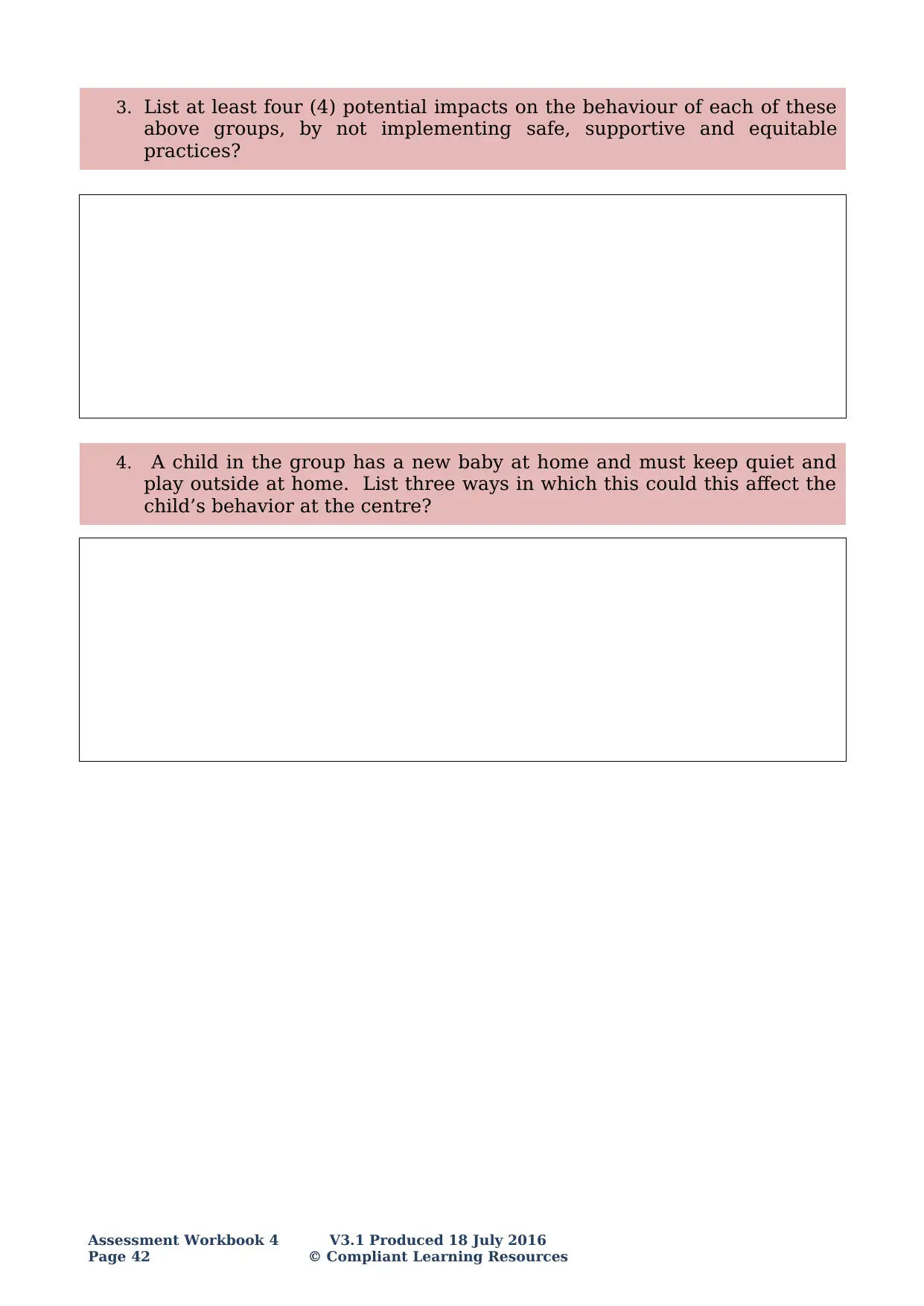
3. List at least four (4) potential impacts on the behaviour of each of these
above groups, by not implementing safe, supportive and equitable
practices?
4. A child in the group has a new baby at home and must keep quiet and
play outside at home. List three ways in which this could this affect the
child’s behavior at the centre?
Assessment Workbook 4 V3.1 Produced 18 July 2016
Page 42 © Compliant Learning Resources
above groups, by not implementing safe, supportive and equitable
practices?
4. A child in the group has a new baby at home and must keep quiet and
play outside at home. List three ways in which this could this affect the
child’s behavior at the centre?
Assessment Workbook 4 V3.1 Produced 18 July 2016
Page 42 © Compliant Learning Resources
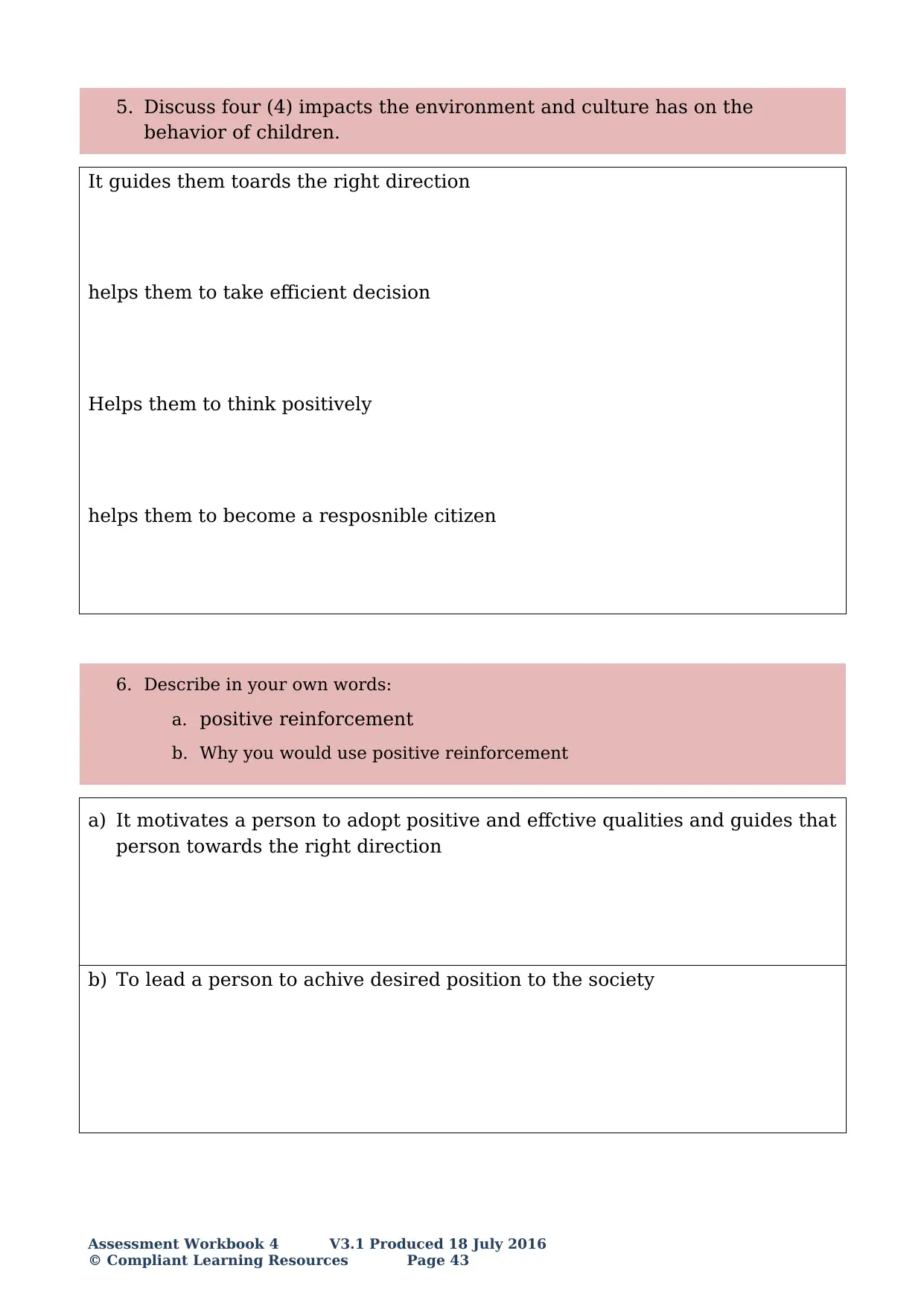
5. Discuss four (4) impacts the environment and culture has on the
behavior of children.
It guides them toards the right direction
helps them to take efficient decision
Helps them to think positively
helps them to become a resposnible citizen
6. Describe in your own words:
a. positive reinforcement
b. Why you would use positive reinforcement
a) It motivates a person to adopt positive and effctive qualities and guides that
person towards the right direction
b) To lead a person to achive desired position to the society
Assessment Workbook 4 V3.1 Produced 18 July 2016
© Compliant Learning Resources Page 43
behavior of children.
It guides them toards the right direction
helps them to take efficient decision
Helps them to think positively
helps them to become a resposnible citizen
6. Describe in your own words:
a. positive reinforcement
b. Why you would use positive reinforcement
a) It motivates a person to adopt positive and effctive qualities and guides that
person towards the right direction
b) To lead a person to achive desired position to the society
Assessment Workbook 4 V3.1 Produced 18 July 2016
© Compliant Learning Resources Page 43
Paraphrase This Document
Need a fresh take? Get an instant paraphrase of this document with our AI Paraphraser

7. Describe three (3) positive support strategies involving communication that
you could use to redirect behaviors of concern.
8. Discuss how you would diffuse the following hypothetical situation:
‘Two children are yelling at each other, one of the children is
holding a book about to throw it at the other.’
9. Describe in your own words how culture and the environment can impact on
the behaviour of children.
10.What is disruptive behaviour?
Assessment Workbook 4 V3.1 Produced 18 July 2016
Page 44 © Compliant Learning Resources
you could use to redirect behaviors of concern.
8. Discuss how you would diffuse the following hypothetical situation:
‘Two children are yelling at each other, one of the children is
holding a book about to throw it at the other.’
9. Describe in your own words how culture and the environment can impact on
the behaviour of children.
10.What is disruptive behaviour?
Assessment Workbook 4 V3.1 Produced 18 July 2016
Page 44 © Compliant Learning Resources
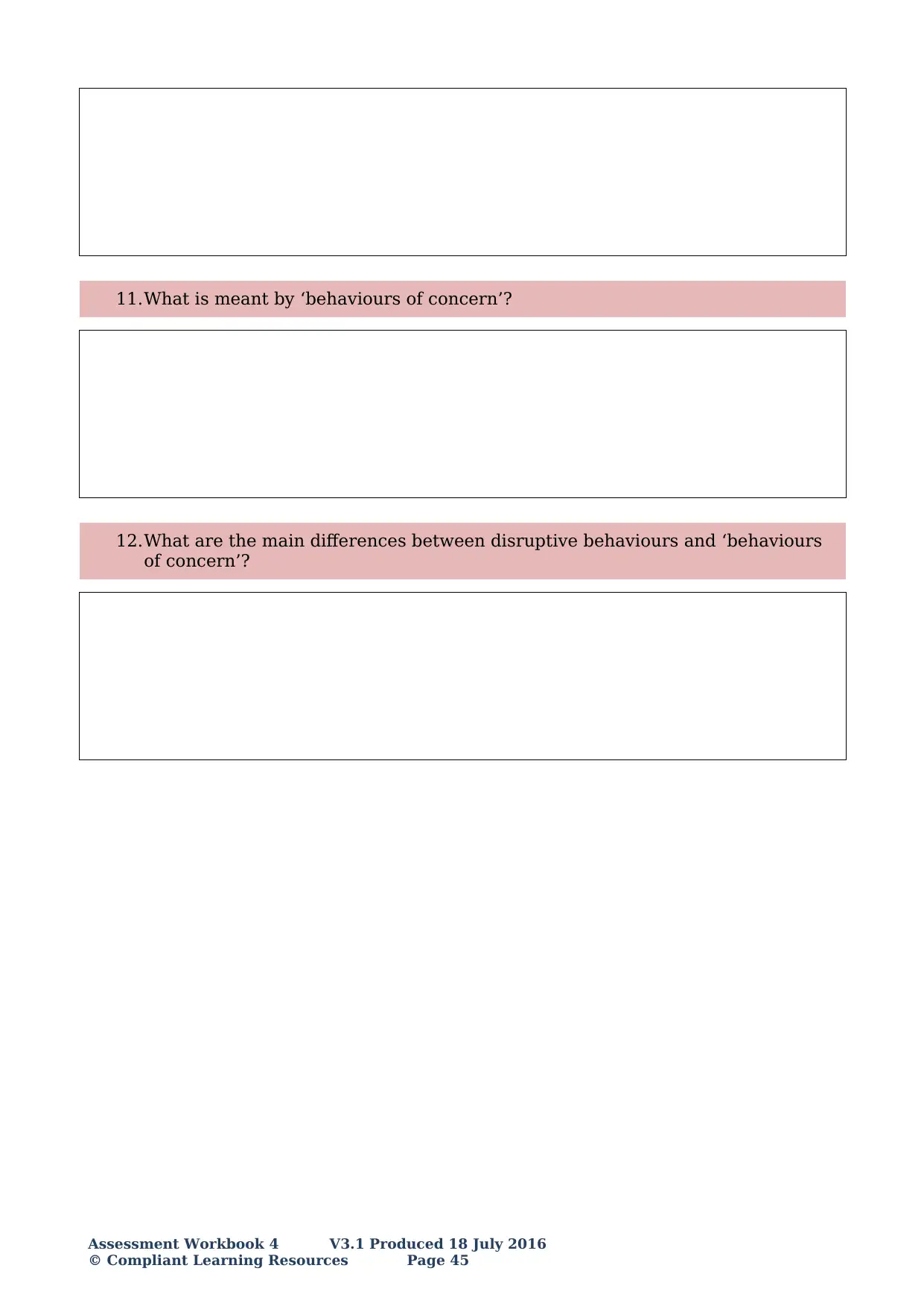
11.What is meant by ‘behaviours of concern’?
12.What are the main differences between disruptive behaviours and ‘behaviours
of concern’?
Assessment Workbook 4 V3.1 Produced 18 July 2016
© Compliant Learning Resources Page 45
12.What are the main differences between disruptive behaviours and ‘behaviours
of concern’?
Assessment Workbook 4 V3.1 Produced 18 July 2016
© Compliant Learning Resources Page 45
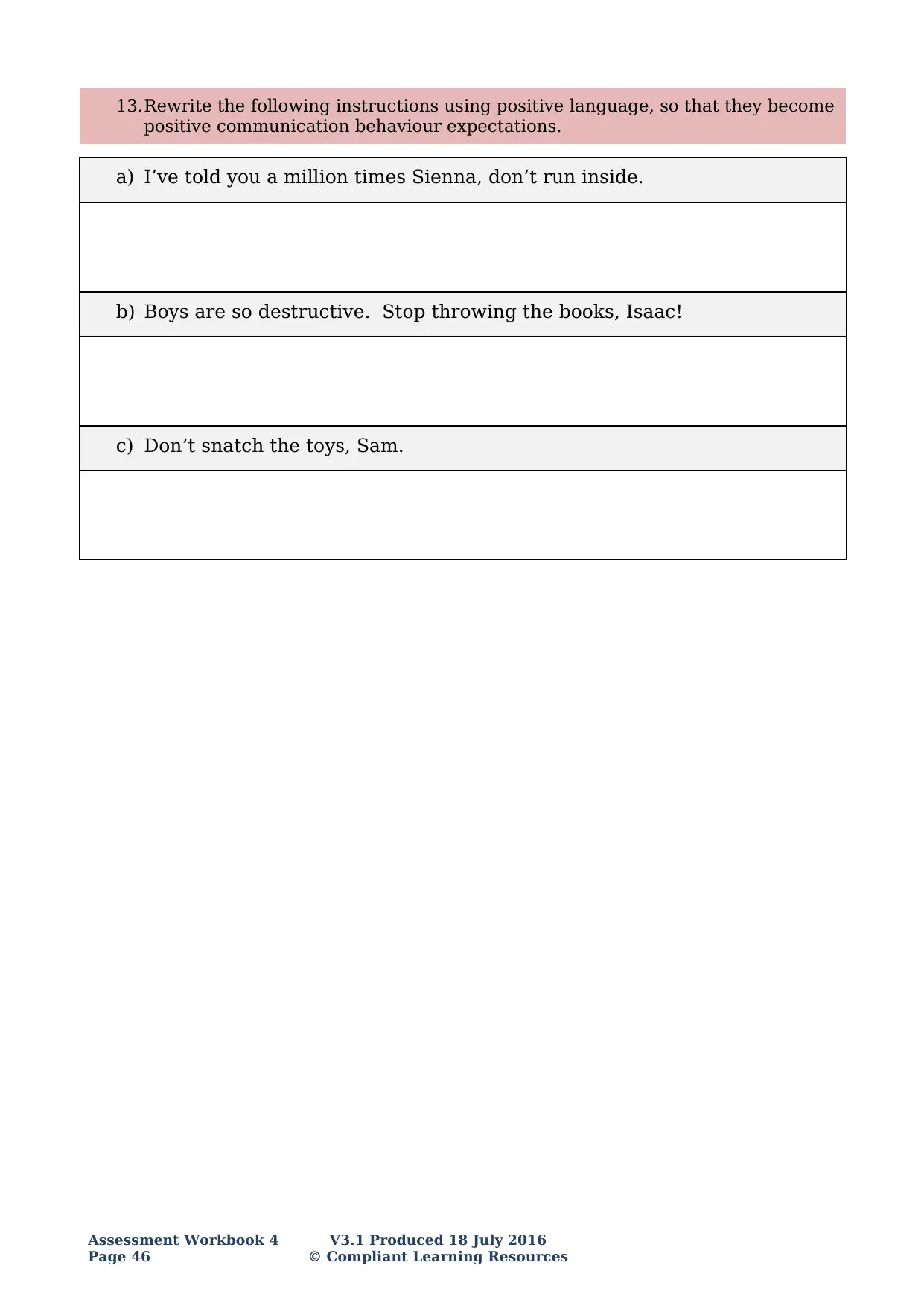
13.Rewrite the following instructions using positive language, so that they become
positive communication behaviour expectations.
a) I’ve told you a million times Sienna, don’t run inside.
b) Boys are so destructive. Stop throwing the books, Isaac!
c) Don’t snatch the toys, Sam.
Assessment Workbook 4 V3.1 Produced 18 July 2016
Page 46 © Compliant Learning Resources
positive communication behaviour expectations.
a) I’ve told you a million times Sienna, don’t run inside.
b) Boys are so destructive. Stop throwing the books, Isaac!
c) Don’t snatch the toys, Sam.
Assessment Workbook 4 V3.1 Produced 18 July 2016
Page 46 © Compliant Learning Resources
Secure Best Marks with AI Grader
Need help grading? Try our AI Grader for instant feedback on your assignments.
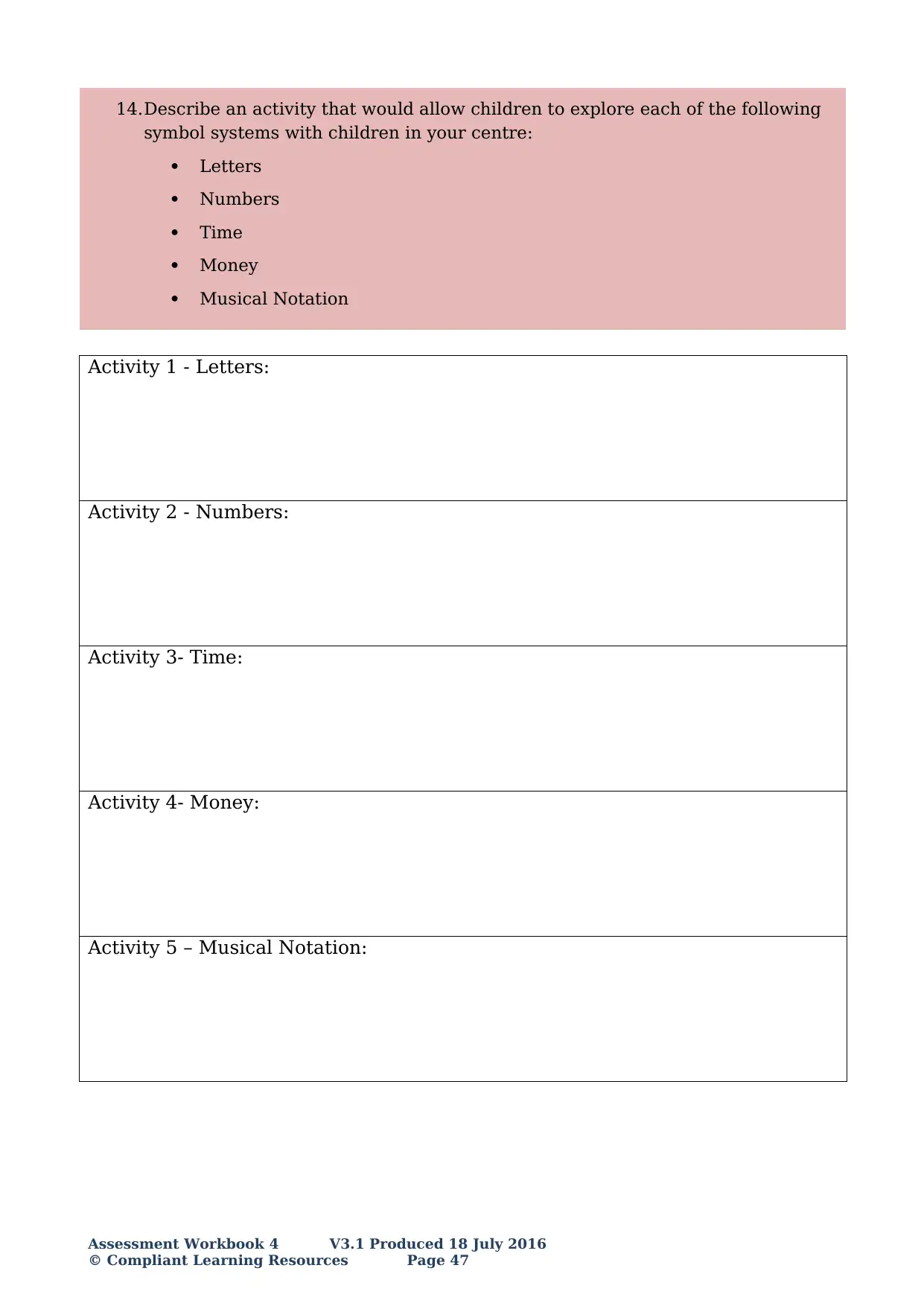
14.Describe an activity that would allow children to explore each of the following
symbol systems with children in your centre:
Letters
Numbers
Time
Money
Musical Notation
Activity 1 - Letters:
Activity 2 - Numbers:
Activity 3- Time:
Activity 4- Money:
Activity 5 – Musical Notation:
Assessment Workbook 4 V3.1 Produced 18 July 2016
© Compliant Learning Resources Page 47
symbol systems with children in your centre:
Letters
Numbers
Time
Money
Musical Notation
Activity 1 - Letters:
Activity 2 - Numbers:
Activity 3- Time:
Activity 4- Money:
Activity 5 – Musical Notation:
Assessment Workbook 4 V3.1 Produced 18 July 2016
© Compliant Learning Resources Page 47
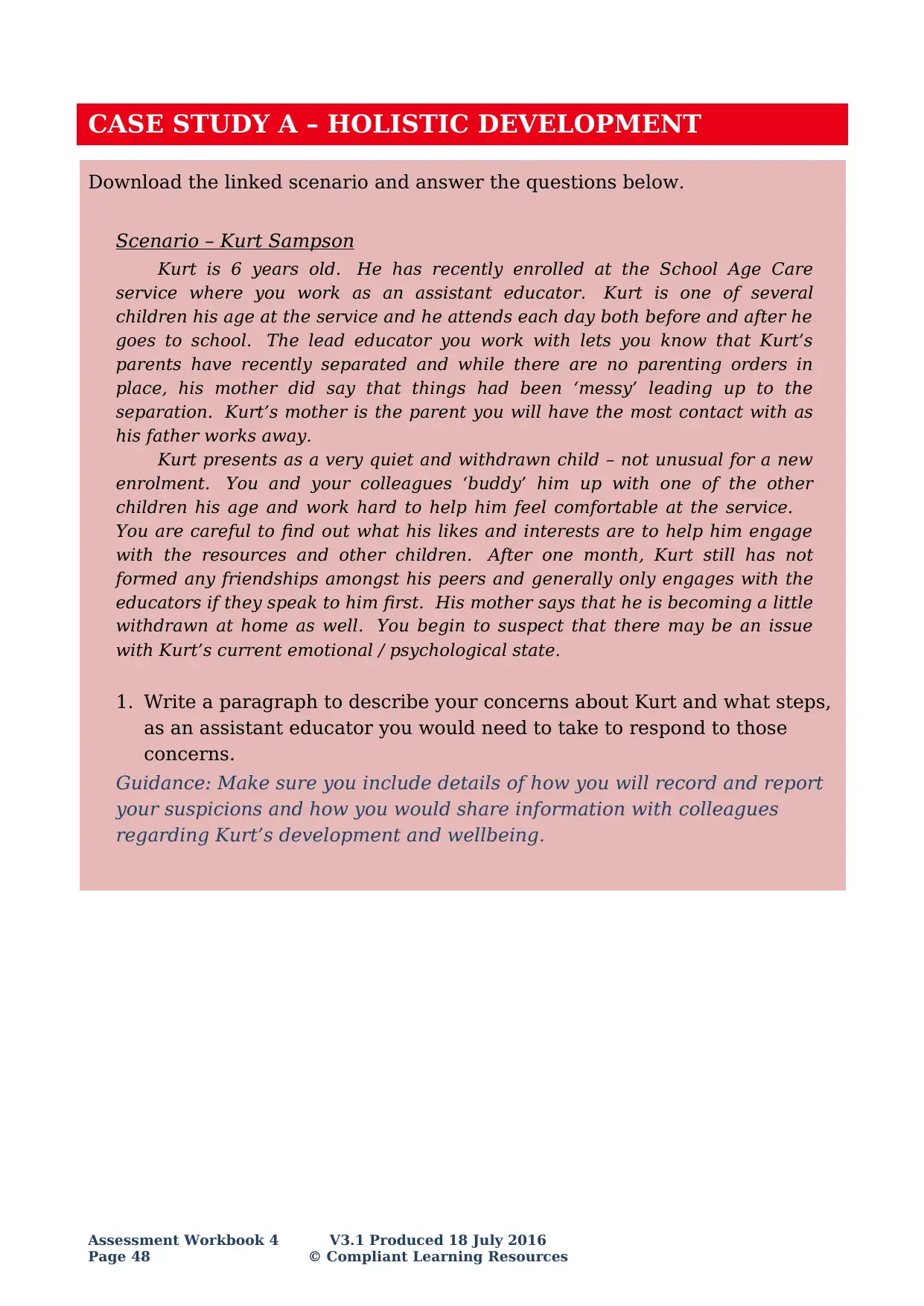
CASE STUDY A – HOLISTIC DEVELOPMENT
Download the linked scenario and answer the questions below.
Scenario – Kurt Sampson
Kurt is 6 years old. He has recently enrolled at the School Age Care
service where you work as an assistant educator. Kurt is one of several
children his age at the service and he attends each day both before and after he
goes to school. The lead educator you work with lets you know that Kurt’s
parents have recently separated and while there are no parenting orders in
place, his mother did say that things had been ‘messy’ leading up to the
separation. Kurt’s mother is the parent you will have the most contact with as
his father works away.
Kurt presents as a very quiet and withdrawn child – not unusual for a new
enrolment. You and your colleagues ‘buddy’ him up with one of the other
children his age and work hard to help him feel comfortable at the service.
You are careful to find out what his likes and interests are to help him engage
with the resources and other children. After one month, Kurt still has not
formed any friendships amongst his peers and generally only engages with the
educators if they speak to him first. His mother says that he is becoming a little
withdrawn at home as well. You begin to suspect that there may be an issue
with Kurt’s current emotional / psychological state.
1. Write a paragraph to describe your concerns about Kurt and what steps,
as an assistant educator you would need to take to respond to those
concerns.
Guidance: Make sure you include details of how you will record and report
your suspicions and how you would share information with colleagues
regarding Kurt’s development and wellbeing.
Assessment Workbook 4 V3.1 Produced 18 July 2016
Page 48 © Compliant Learning Resources
Download the linked scenario and answer the questions below.
Scenario – Kurt Sampson
Kurt is 6 years old. He has recently enrolled at the School Age Care
service where you work as an assistant educator. Kurt is one of several
children his age at the service and he attends each day both before and after he
goes to school. The lead educator you work with lets you know that Kurt’s
parents have recently separated and while there are no parenting orders in
place, his mother did say that things had been ‘messy’ leading up to the
separation. Kurt’s mother is the parent you will have the most contact with as
his father works away.
Kurt presents as a very quiet and withdrawn child – not unusual for a new
enrolment. You and your colleagues ‘buddy’ him up with one of the other
children his age and work hard to help him feel comfortable at the service.
You are careful to find out what his likes and interests are to help him engage
with the resources and other children. After one month, Kurt still has not
formed any friendships amongst his peers and generally only engages with the
educators if they speak to him first. His mother says that he is becoming a little
withdrawn at home as well. You begin to suspect that there may be an issue
with Kurt’s current emotional / psychological state.
1. Write a paragraph to describe your concerns about Kurt and what steps,
as an assistant educator you would need to take to respond to those
concerns.
Guidance: Make sure you include details of how you will record and report
your suspicions and how you would share information with colleagues
regarding Kurt’s development and wellbeing.
Assessment Workbook 4 V3.1 Produced 18 July 2016
Page 48 © Compliant Learning Resources
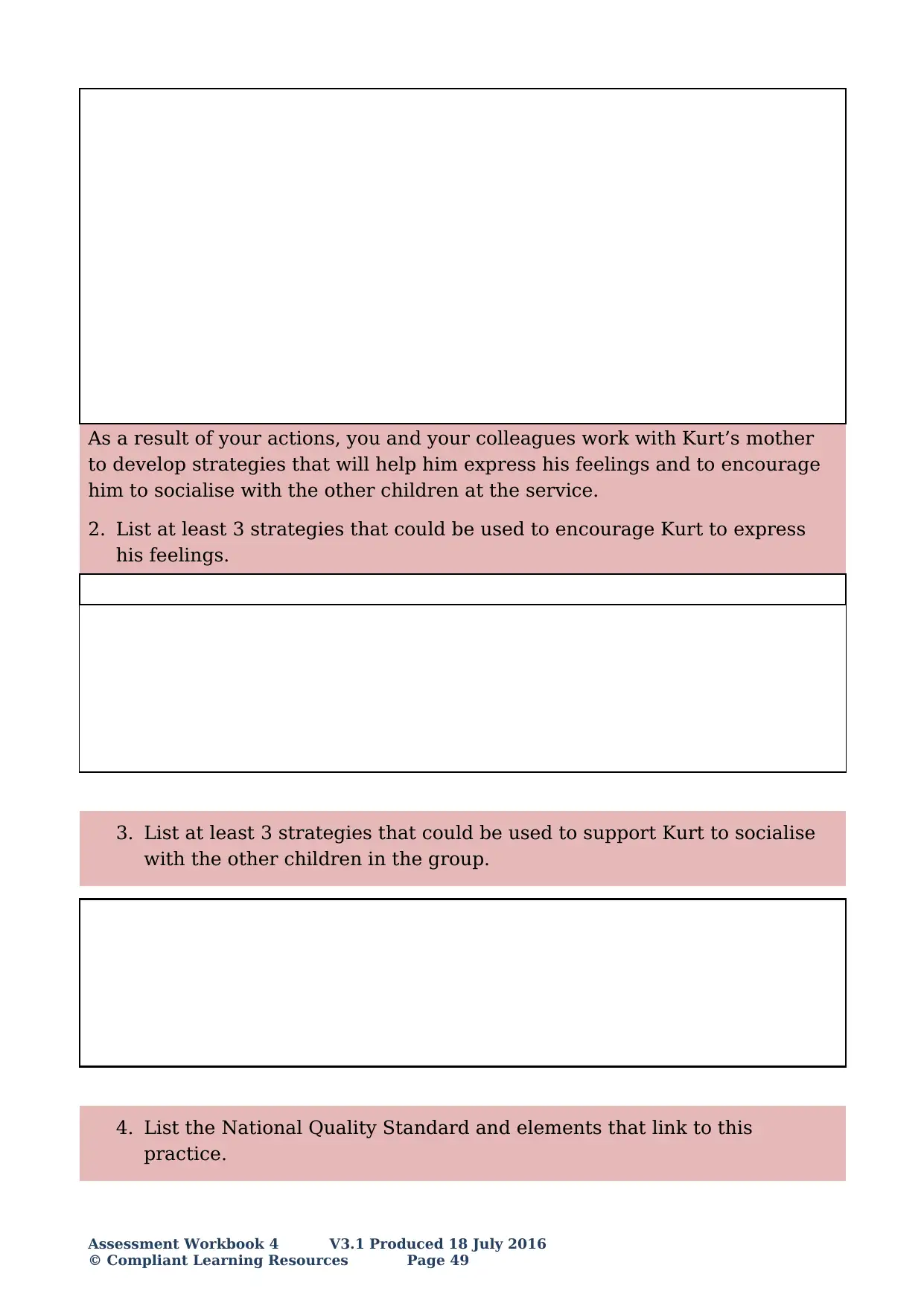
As a result of your actions, you and your colleagues work with Kurt’s mother
to develop strategies that will help him express his feelings and to encourage
him to socialise with the other children at the service.
2. List at least 3 strategies that could be used to encourage Kurt to express
his feelings.
3. List at least 3 strategies that could be used to support Kurt to socialise
with the other children in the group.
4. List the National Quality Standard and elements that link to this
practice.
Assessment Workbook 4 V3.1 Produced 18 July 2016
© Compliant Learning Resources Page 49
to develop strategies that will help him express his feelings and to encourage
him to socialise with the other children at the service.
2. List at least 3 strategies that could be used to encourage Kurt to express
his feelings.
3. List at least 3 strategies that could be used to support Kurt to socialise
with the other children in the group.
4. List the National Quality Standard and elements that link to this
practice.
Assessment Workbook 4 V3.1 Produced 18 July 2016
© Compliant Learning Resources Page 49
Paraphrase This Document
Need a fresh take? Get an instant paraphrase of this document with our AI Paraphraser
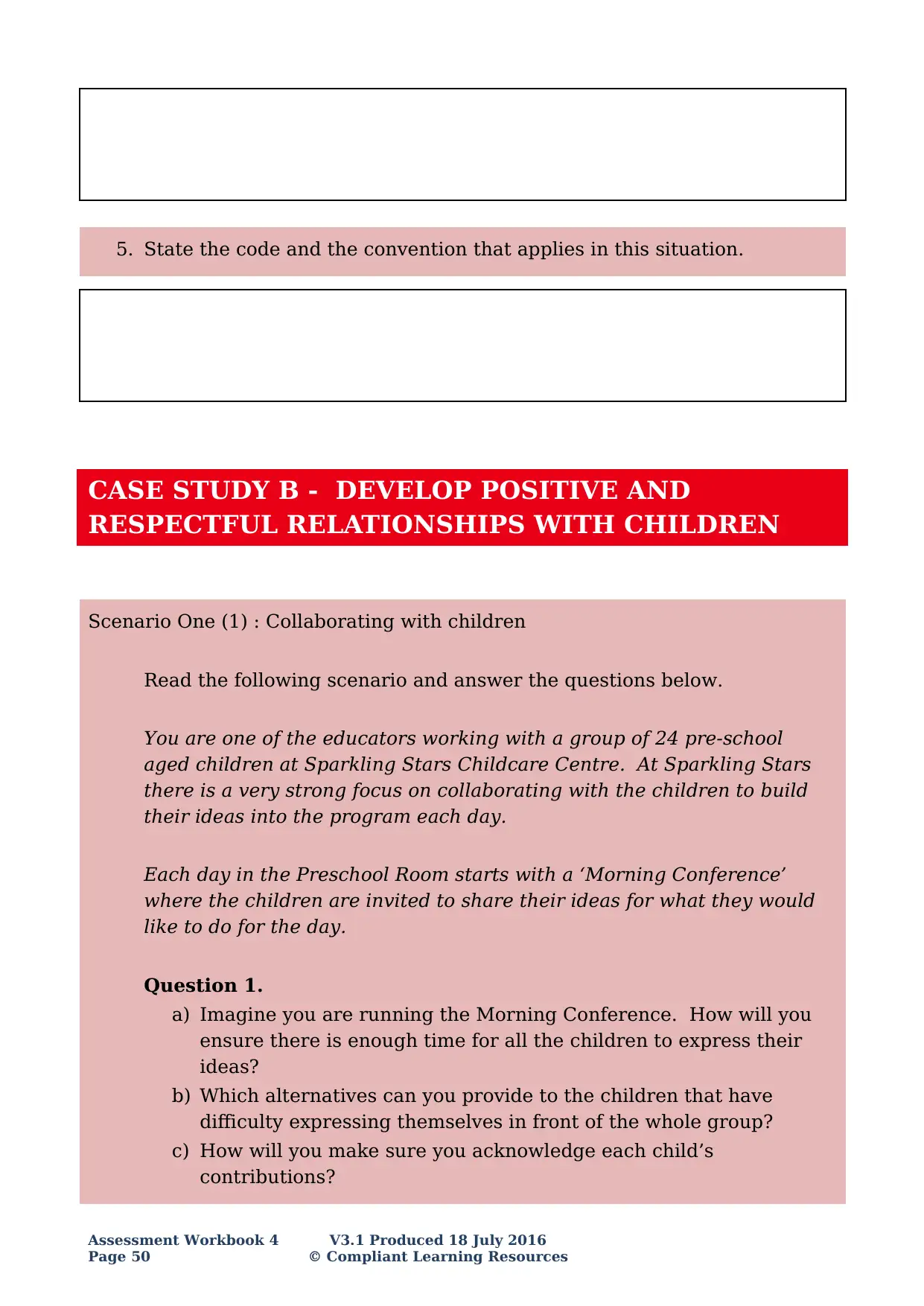
5. State the code and the convention that applies in this situation.
CASE STUDY B - DEVELOP POSITIVE AND
RESPECTFUL RELATIONSHIPS WITH CHILDREN
Scenario One (1) : Collaborating with children
Read the following scenario and answer the questions below.
You are one of the educators working with a group of 24 pre-school
aged children at Sparkling Stars Childcare Centre. At Sparkling Stars
there is a very strong focus on collaborating with the children to build
their ideas into the program each day.
Each day in the Preschool Room starts with a ‘Morning Conference’
where the children are invited to share their ideas for what they would
like to do for the day.
Question 1.
a) Imagine you are running the Morning Conference. How will you
ensure there is enough time for all the children to express their
ideas?
b) Which alternatives can you provide to the children that have
difficulty expressing themselves in front of the whole group?
c) How will you make sure you acknowledge each child’s
contributions?
Assessment Workbook 4 V3.1 Produced 18 July 2016
Page 50 © Compliant Learning Resources
CASE STUDY B - DEVELOP POSITIVE AND
RESPECTFUL RELATIONSHIPS WITH CHILDREN
Scenario One (1) : Collaborating with children
Read the following scenario and answer the questions below.
You are one of the educators working with a group of 24 pre-school
aged children at Sparkling Stars Childcare Centre. At Sparkling Stars
there is a very strong focus on collaborating with the children to build
their ideas into the program each day.
Each day in the Preschool Room starts with a ‘Morning Conference’
where the children are invited to share their ideas for what they would
like to do for the day.
Question 1.
a) Imagine you are running the Morning Conference. How will you
ensure there is enough time for all the children to express their
ideas?
b) Which alternatives can you provide to the children that have
difficulty expressing themselves in front of the whole group?
c) How will you make sure you acknowledge each child’s
contributions?
Assessment Workbook 4 V3.1 Produced 18 July 2016
Page 50 © Compliant Learning Resources
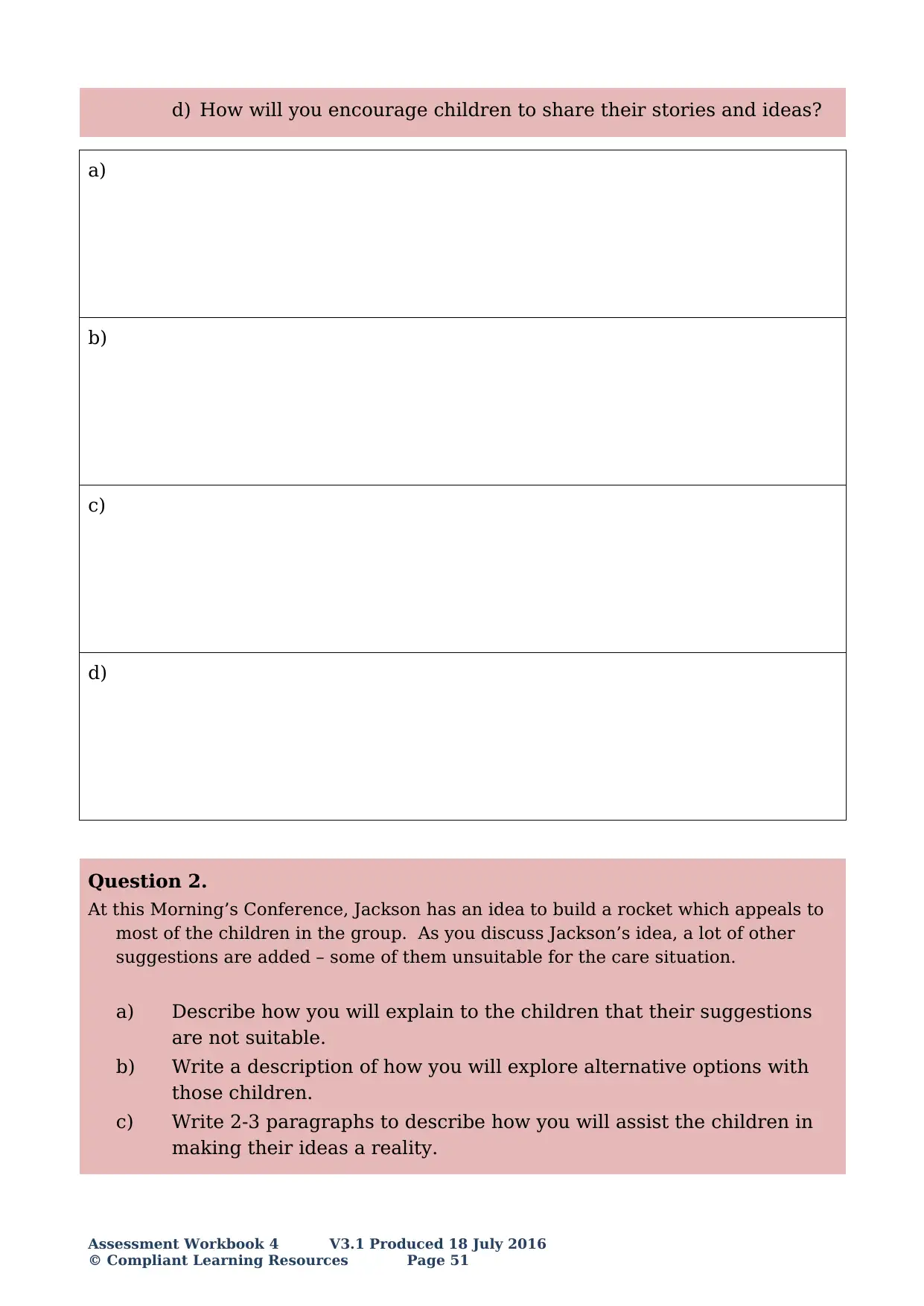
d) How will you encourage children to share their stories and ideas?
a)
b)
c)
d)
Question 2.
At this Morning’s Conference, Jackson has an idea to build a rocket which appeals to
most of the children in the group. As you discuss Jackson’s idea, a lot of other
suggestions are added – some of them unsuitable for the care situation.
a) Describe how you will explain to the children that their suggestions
are not suitable.
b) Write a description of how you will explore alternative options with
those children.
c) Write 2-3 paragraphs to describe how you will assist the children in
making their ideas a reality.
Assessment Workbook 4 V3.1 Produced 18 July 2016
© Compliant Learning Resources Page 51
a)
b)
c)
d)
Question 2.
At this Morning’s Conference, Jackson has an idea to build a rocket which appeals to
most of the children in the group. As you discuss Jackson’s idea, a lot of other
suggestions are added – some of them unsuitable for the care situation.
a) Describe how you will explain to the children that their suggestions
are not suitable.
b) Write a description of how you will explore alternative options with
those children.
c) Write 2-3 paragraphs to describe how you will assist the children in
making their ideas a reality.
Assessment Workbook 4 V3.1 Produced 18 July 2016
© Compliant Learning Resources Page 51
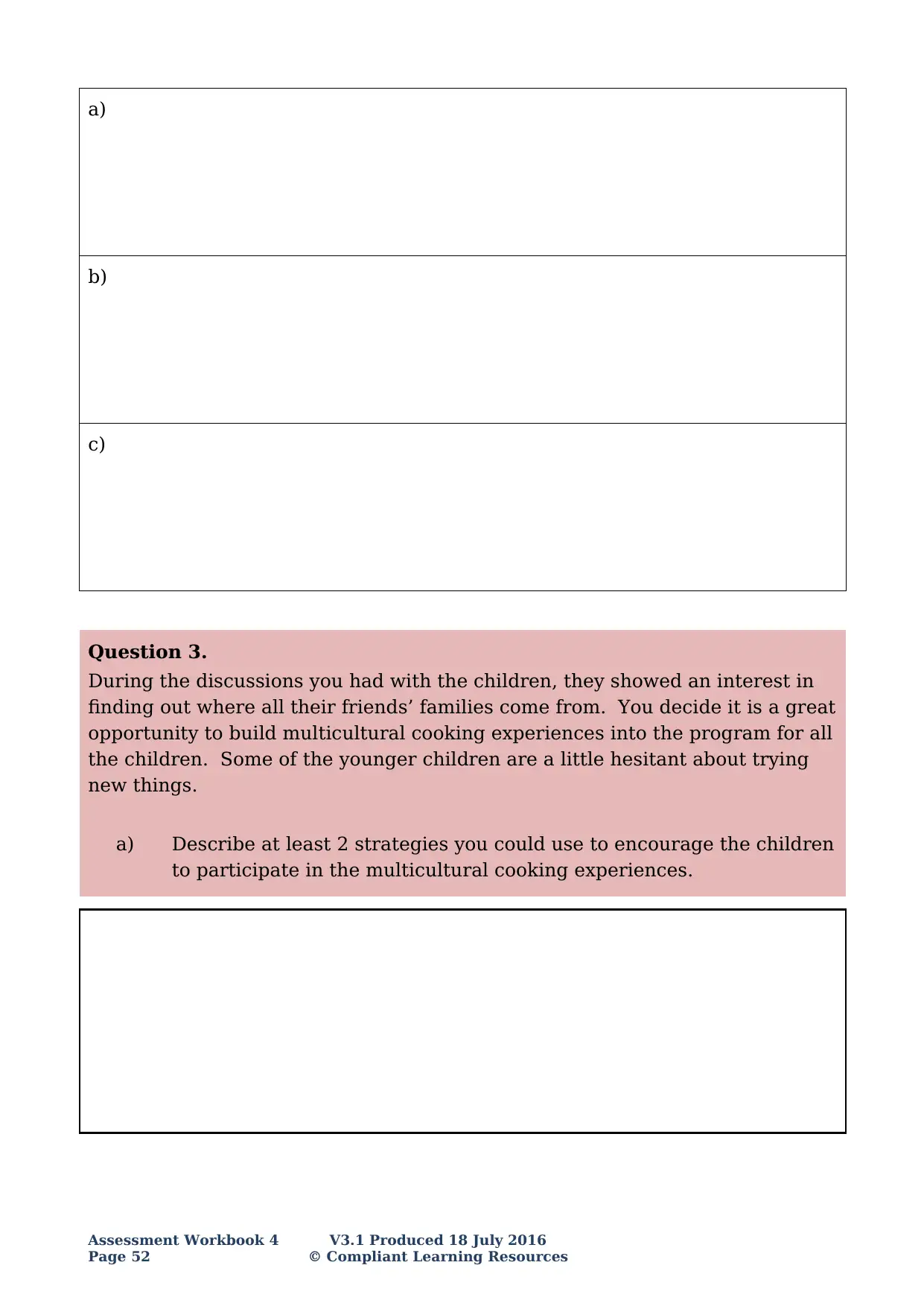
a)
b)
c)
Question 3.
During the discussions you had with the children, they showed an interest in
finding out where all their friends’ families come from. You decide it is a great
opportunity to build multicultural cooking experiences into the program for all
the children. Some of the younger children are a little hesitant about trying
new things.
a) Describe at least 2 strategies you could use to encourage the children
to participate in the multicultural cooking experiences.
Assessment Workbook 4 V3.1 Produced 18 July 2016
Page 52 © Compliant Learning Resources
b)
c)
Question 3.
During the discussions you had with the children, they showed an interest in
finding out where all their friends’ families come from. You decide it is a great
opportunity to build multicultural cooking experiences into the program for all
the children. Some of the younger children are a little hesitant about trying
new things.
a) Describe at least 2 strategies you could use to encourage the children
to participate in the multicultural cooking experiences.
Assessment Workbook 4 V3.1 Produced 18 July 2016
Page 52 © Compliant Learning Resources
Secure Best Marks with AI Grader
Need help grading? Try our AI Grader for instant feedback on your assignments.
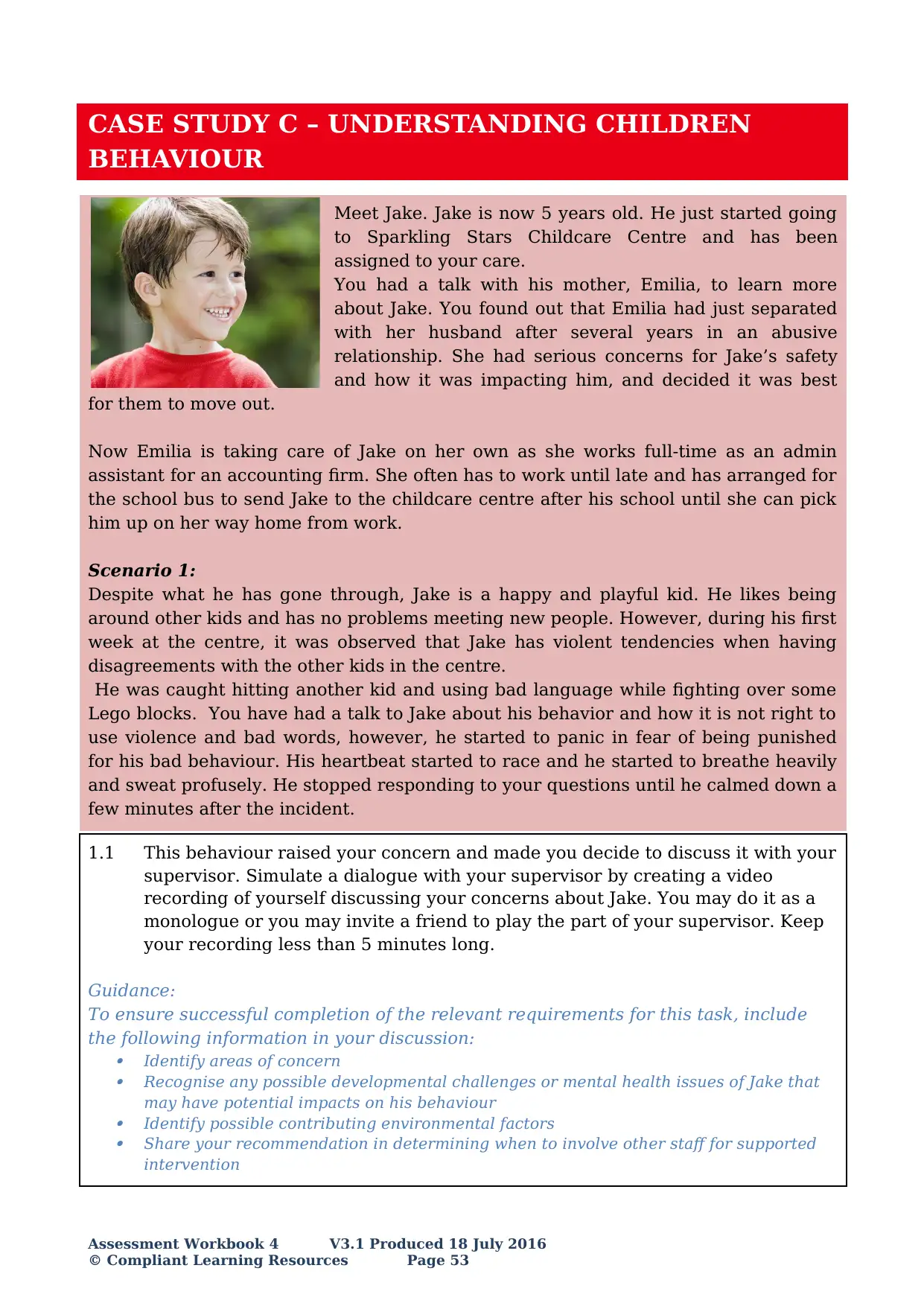
CASE STUDY C – UNDERSTANDING CHILDREN
BEHAVIOUR
Meet Jake. Jake is now 5 years old. He just started going
to Sparkling Stars Childcare Centre and has been
assigned to your care.
You had a talk with his mother, Emilia, to learn more
about Jake. You found out that Emilia had just separated
with her husband after several years in an abusive
relationship. She had serious concerns for Jake’s safety
and how it was impacting him, and decided it was best
for them to move out.
Now Emilia is taking care of Jake on her own as she works full-time as an admin
assistant for an accounting firm. She often has to work until late and has arranged for
the school bus to send Jake to the childcare centre after his school until she can pick
him up on her way home from work.
Scenario 1:
Despite what he has gone through, Jake is a happy and playful kid. He likes being
around other kids and has no problems meeting new people. However, during his first
week at the centre, it was observed that Jake has violent tendencies when having
disagreements with the other kids in the centre.
He was caught hitting another kid and using bad language while fighting over some
Lego blocks. You have had a talk to Jake about his behavior and how it is not right to
use violence and bad words, however, he started to panic in fear of being punished
for his bad behaviour. His heartbeat started to race and he started to breathe heavily
and sweat profusely. He stopped responding to your questions until he calmed down a
few minutes after the incident.
1.1 This behaviour raised your concern and made you decide to discuss it with your
supervisor. Simulate a dialogue with your supervisor by creating a video
recording of yourself discussing your concerns about Jake. You may do it as a
monologue or you may invite a friend to play the part of your supervisor. Keep
your recording less than 5 minutes long.
Guidance:
To ensure successful completion of the relevant requirements for this task, include
the following information in your discussion:
Identify areas of concern
Recognise any possible developmental challenges or mental health issues of Jake that
may have potential impacts on his behaviour
Identify possible contributing environmental factors
Share your recommendation in determining when to involve other staff for supported
intervention
Assessment Workbook 4 V3.1 Produced 18 July 2016
© Compliant Learning Resources Page 53
BEHAVIOUR
Meet Jake. Jake is now 5 years old. He just started going
to Sparkling Stars Childcare Centre and has been
assigned to your care.
You had a talk with his mother, Emilia, to learn more
about Jake. You found out that Emilia had just separated
with her husband after several years in an abusive
relationship. She had serious concerns for Jake’s safety
and how it was impacting him, and decided it was best
for them to move out.
Now Emilia is taking care of Jake on her own as she works full-time as an admin
assistant for an accounting firm. She often has to work until late and has arranged for
the school bus to send Jake to the childcare centre after his school until she can pick
him up on her way home from work.
Scenario 1:
Despite what he has gone through, Jake is a happy and playful kid. He likes being
around other kids and has no problems meeting new people. However, during his first
week at the centre, it was observed that Jake has violent tendencies when having
disagreements with the other kids in the centre.
He was caught hitting another kid and using bad language while fighting over some
Lego blocks. You have had a talk to Jake about his behavior and how it is not right to
use violence and bad words, however, he started to panic in fear of being punished
for his bad behaviour. His heartbeat started to race and he started to breathe heavily
and sweat profusely. He stopped responding to your questions until he calmed down a
few minutes after the incident.
1.1 This behaviour raised your concern and made you decide to discuss it with your
supervisor. Simulate a dialogue with your supervisor by creating a video
recording of yourself discussing your concerns about Jake. You may do it as a
monologue or you may invite a friend to play the part of your supervisor. Keep
your recording less than 5 minutes long.
Guidance:
To ensure successful completion of the relevant requirements for this task, include
the following information in your discussion:
Identify areas of concern
Recognise any possible developmental challenges or mental health issues of Jake that
may have potential impacts on his behaviour
Identify possible contributing environmental factors
Share your recommendation in determining when to involve other staff for supported
intervention
Assessment Workbook 4 V3.1 Produced 18 July 2016
© Compliant Learning Resources Page 53

Assessment Workbook 4 V3.1 Produced 18 July 2016
Page 54 © Compliant Learning Resources
Page 54 © Compliant Learning Resources
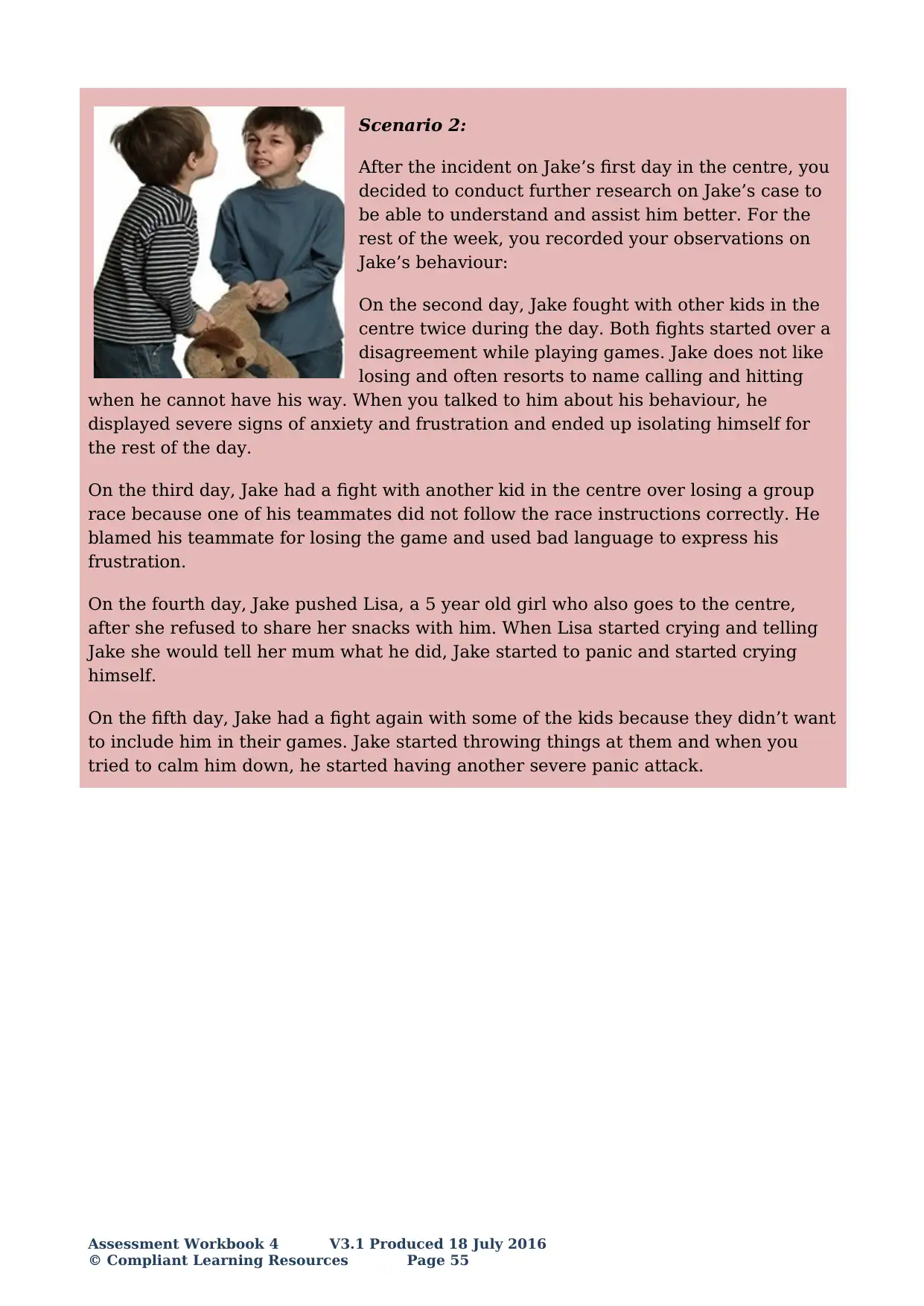
Scenario 2:
After the incident on Jake’s first day in the centre, you
decided to conduct further research on Jake’s case to
be able to understand and assist him better. For the
rest of the week, you recorded your observations on
Jake’s behaviour:
On the second day, Jake fought with other kids in the
centre twice during the day. Both fights started over a
disagreement while playing games. Jake does not like
losing and often resorts to name calling and hitting
when he cannot have his way. When you talked to him about his behaviour, he
displayed severe signs of anxiety and frustration and ended up isolating himself for
the rest of the day.
On the third day, Jake had a fight with another kid in the centre over losing a group
race because one of his teammates did not follow the race instructions correctly. He
blamed his teammate for losing the game and used bad language to express his
frustration.
On the fourth day, Jake pushed Lisa, a 5 year old girl who also goes to the centre,
after she refused to share her snacks with him. When Lisa started crying and telling
Jake she would tell her mum what he did, Jake started to panic and started crying
himself.
On the fifth day, Jake had a fight again with some of the kids because they didn’t want
to include him in their games. Jake started throwing things at them and when you
tried to calm him down, he started having another severe panic attack.
Assessment Workbook 4 V3.1 Produced 18 July 2016
© Compliant Learning Resources Page 55
After the incident on Jake’s first day in the centre, you
decided to conduct further research on Jake’s case to
be able to understand and assist him better. For the
rest of the week, you recorded your observations on
Jake’s behaviour:
On the second day, Jake fought with other kids in the
centre twice during the day. Both fights started over a
disagreement while playing games. Jake does not like
losing and often resorts to name calling and hitting
when he cannot have his way. When you talked to him about his behaviour, he
displayed severe signs of anxiety and frustration and ended up isolating himself for
the rest of the day.
On the third day, Jake had a fight with another kid in the centre over losing a group
race because one of his teammates did not follow the race instructions correctly. He
blamed his teammate for losing the game and used bad language to express his
frustration.
On the fourth day, Jake pushed Lisa, a 5 year old girl who also goes to the centre,
after she refused to share her snacks with him. When Lisa started crying and telling
Jake she would tell her mum what he did, Jake started to panic and started crying
himself.
On the fifth day, Jake had a fight again with some of the kids because they didn’t want
to include him in their games. Jake started throwing things at them and when you
tried to calm him down, he started having another severe panic attack.
Assessment Workbook 4 V3.1 Produced 18 July 2016
© Compliant Learning Resources Page 55
Paraphrase This Document
Need a fresh take? Get an instant paraphrase of this document with our AI Paraphraser
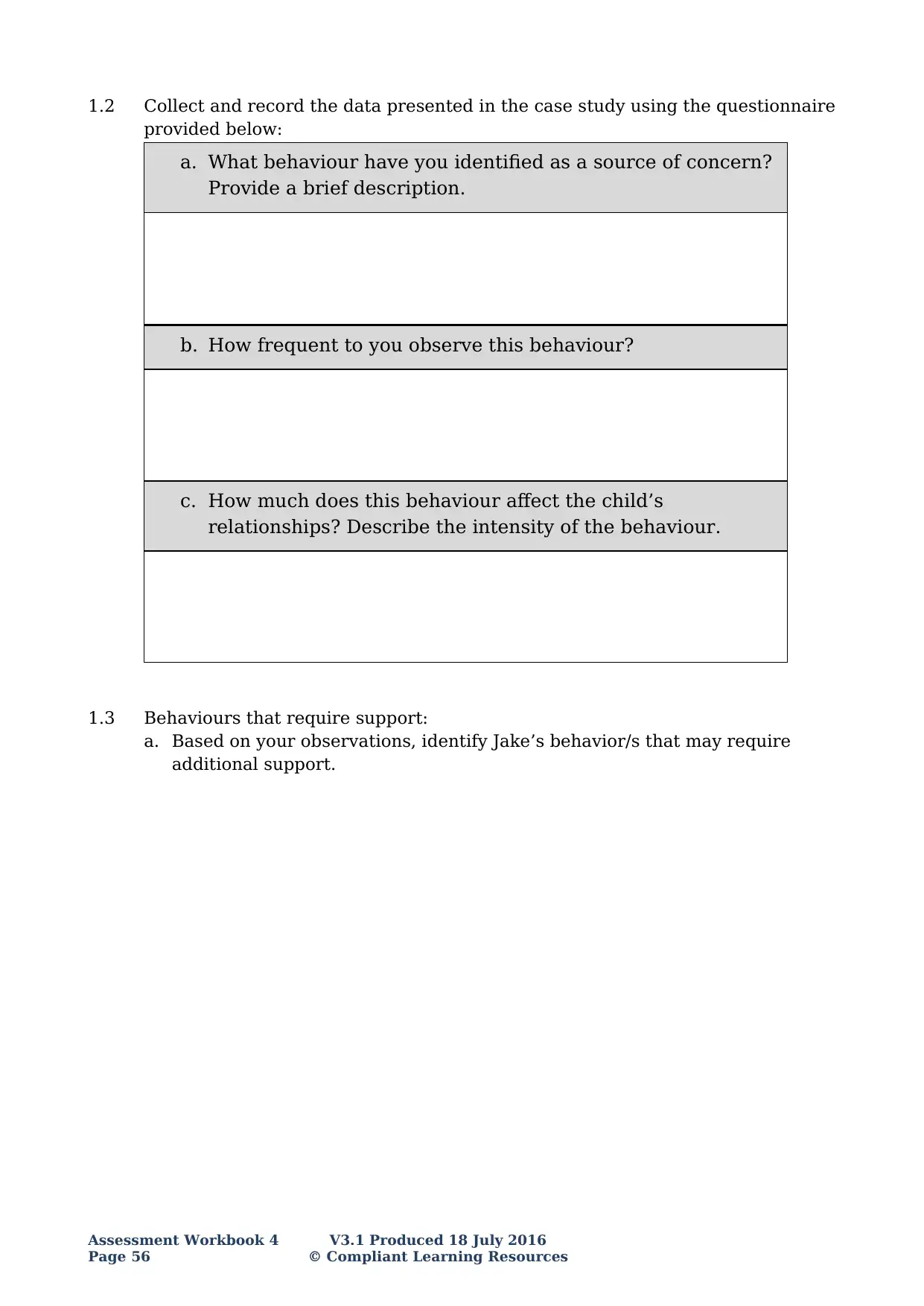
1.2 Collect and record the data presented in the case study using the questionnaire
provided below:
a. What behaviour have you identified as a source of concern?
Provide a brief description.
b. How frequent to you observe this behaviour?
c. How much does this behaviour affect the child’s
relationships? Describe the intensity of the behaviour.
1.3 Behaviours that require support:
a. Based on your observations, identify Jake’s behavior/s that may require
additional support.
Assessment Workbook 4 V3.1 Produced 18 July 2016
Page 56 © Compliant Learning Resources
provided below:
a. What behaviour have you identified as a source of concern?
Provide a brief description.
b. How frequent to you observe this behaviour?
c. How much does this behaviour affect the child’s
relationships? Describe the intensity of the behaviour.
1.3 Behaviours that require support:
a. Based on your observations, identify Jake’s behavior/s that may require
additional support.
Assessment Workbook 4 V3.1 Produced 18 July 2016
Page 56 © Compliant Learning Resources
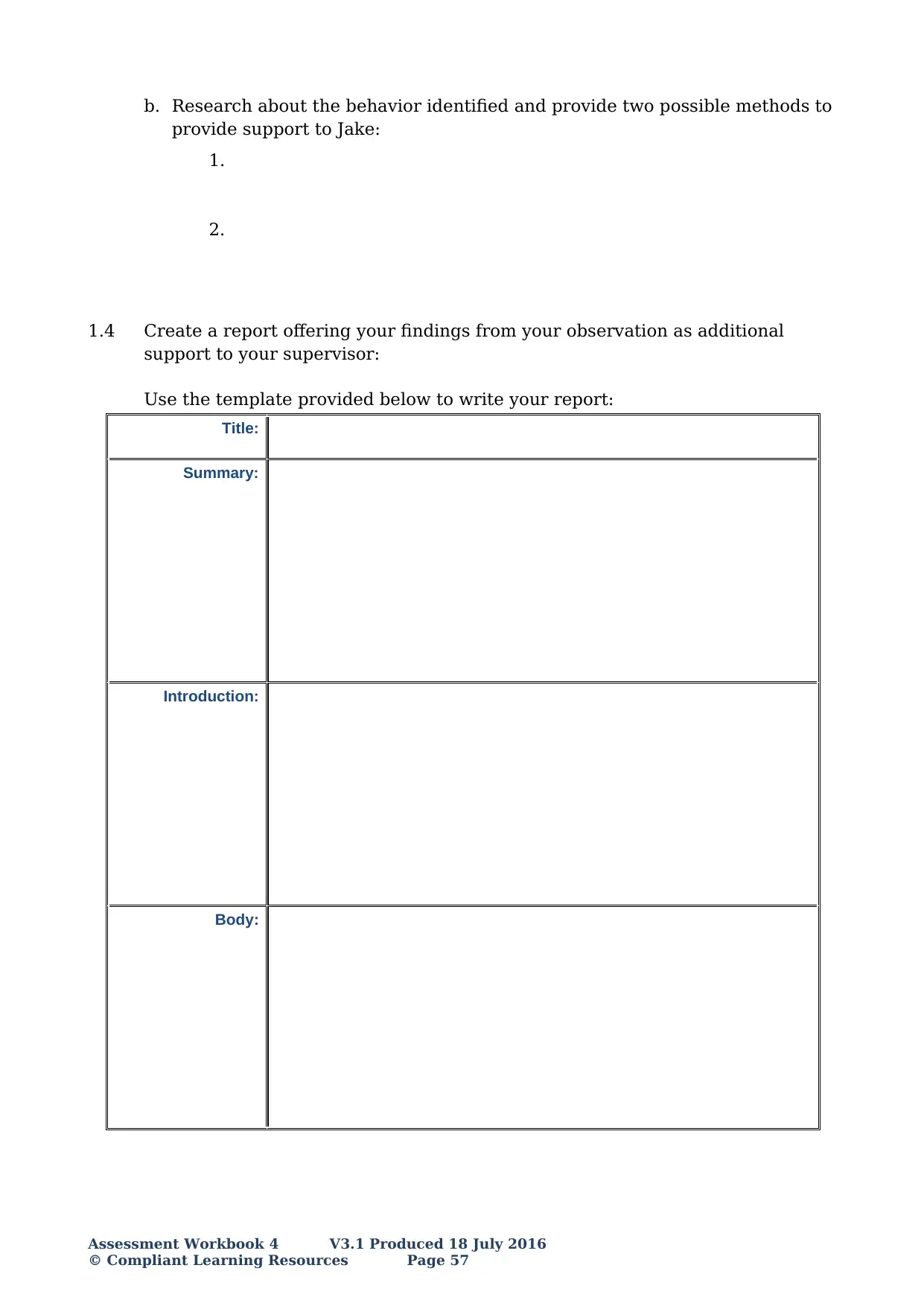
b. Research about the behavior identified and provide two possible methods to
provide support to Jake:
1.
2.
1.4 Create a report offering your findings from your observation as additional
support to your supervisor:
Use the template provided below to write your report:
Title:
Summary:
Introduction:
Body:
Assessment Workbook 4 V3.1 Produced 18 July 2016
© Compliant Learning Resources Page 57
provide support to Jake:
1.
2.
1.4 Create a report offering your findings from your observation as additional
support to your supervisor:
Use the template provided below to write your report:
Title:
Summary:
Introduction:
Body:
Assessment Workbook 4 V3.1 Produced 18 July 2016
© Compliant Learning Resources Page 57
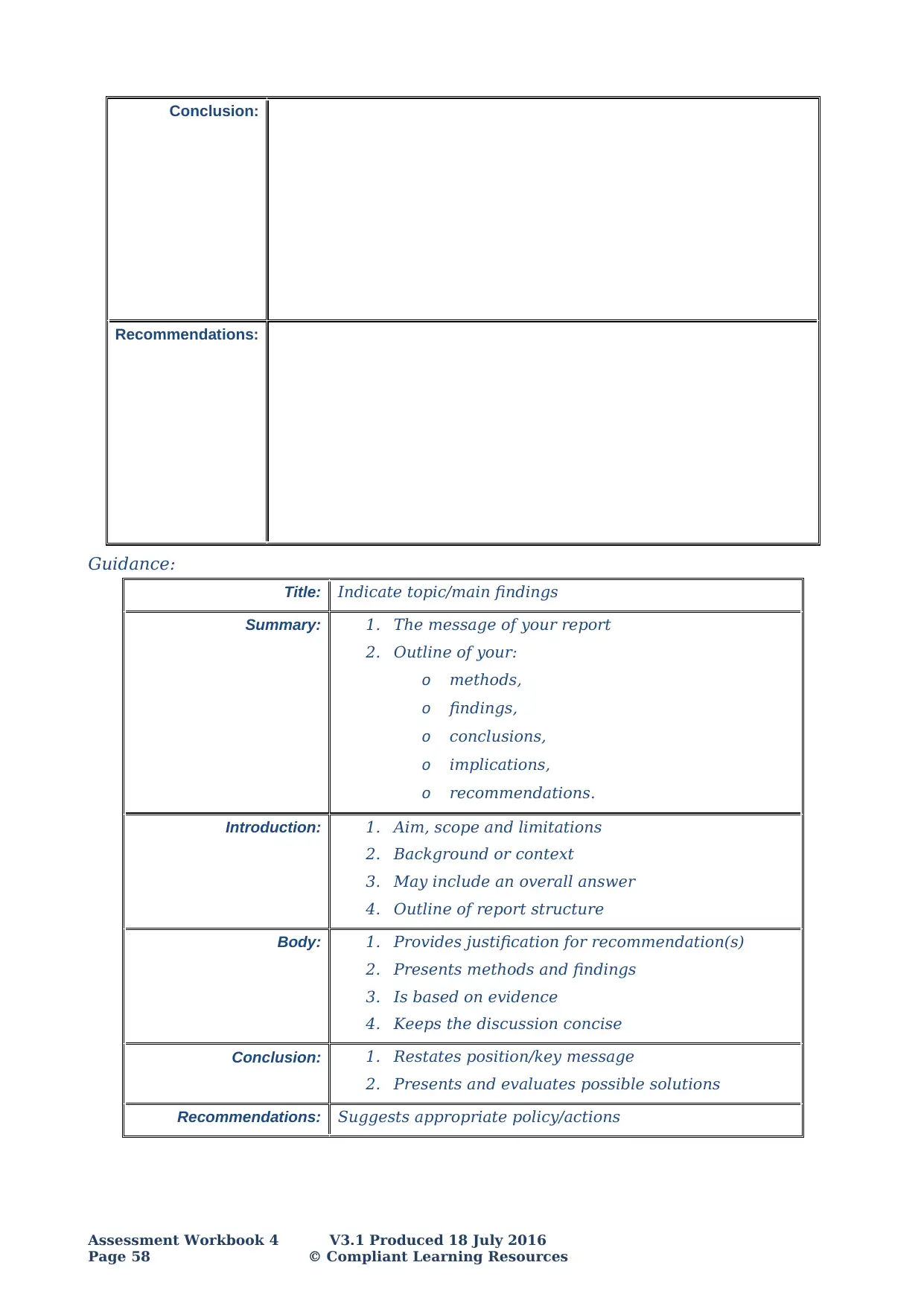
Conclusion:
Recommendations:
Guidance:
Title: Indicate topic/main findings
Summary: 1. The message of your report
2. Outline of your:
o methods,
o findings,
o conclusions,
o implications,
o recommendations.
Introduction: 1. Aim, scope and limitations
2. Background or context
3. May include an overall answer
4. Outline of report structure
Body: 1. Provides justification for recommendation(s)
2. Presents methods and findings
3. Is based on evidence
4. Keeps the discussion concise
Conclusion: 1. Restates position/key message
2. Presents and evaluates possible solutions
Recommendations: Suggests appropriate policy/actions
Assessment Workbook 4 V3.1 Produced 18 July 2016
Page 58 © Compliant Learning Resources
Recommendations:
Guidance:
Title: Indicate topic/main findings
Summary: 1. The message of your report
2. Outline of your:
o methods,
o findings,
o conclusions,
o implications,
o recommendations.
Introduction: 1. Aim, scope and limitations
2. Background or context
3. May include an overall answer
4. Outline of report structure
Body: 1. Provides justification for recommendation(s)
2. Presents methods and findings
3. Is based on evidence
4. Keeps the discussion concise
Conclusion: 1. Restates position/key message
2. Presents and evaluates possible solutions
Recommendations: Suggests appropriate policy/actions
Assessment Workbook 4 V3.1 Produced 18 July 2016
Page 58 © Compliant Learning Resources
Secure Best Marks with AI Grader
Need help grading? Try our AI Grader for instant feedback on your assignments.
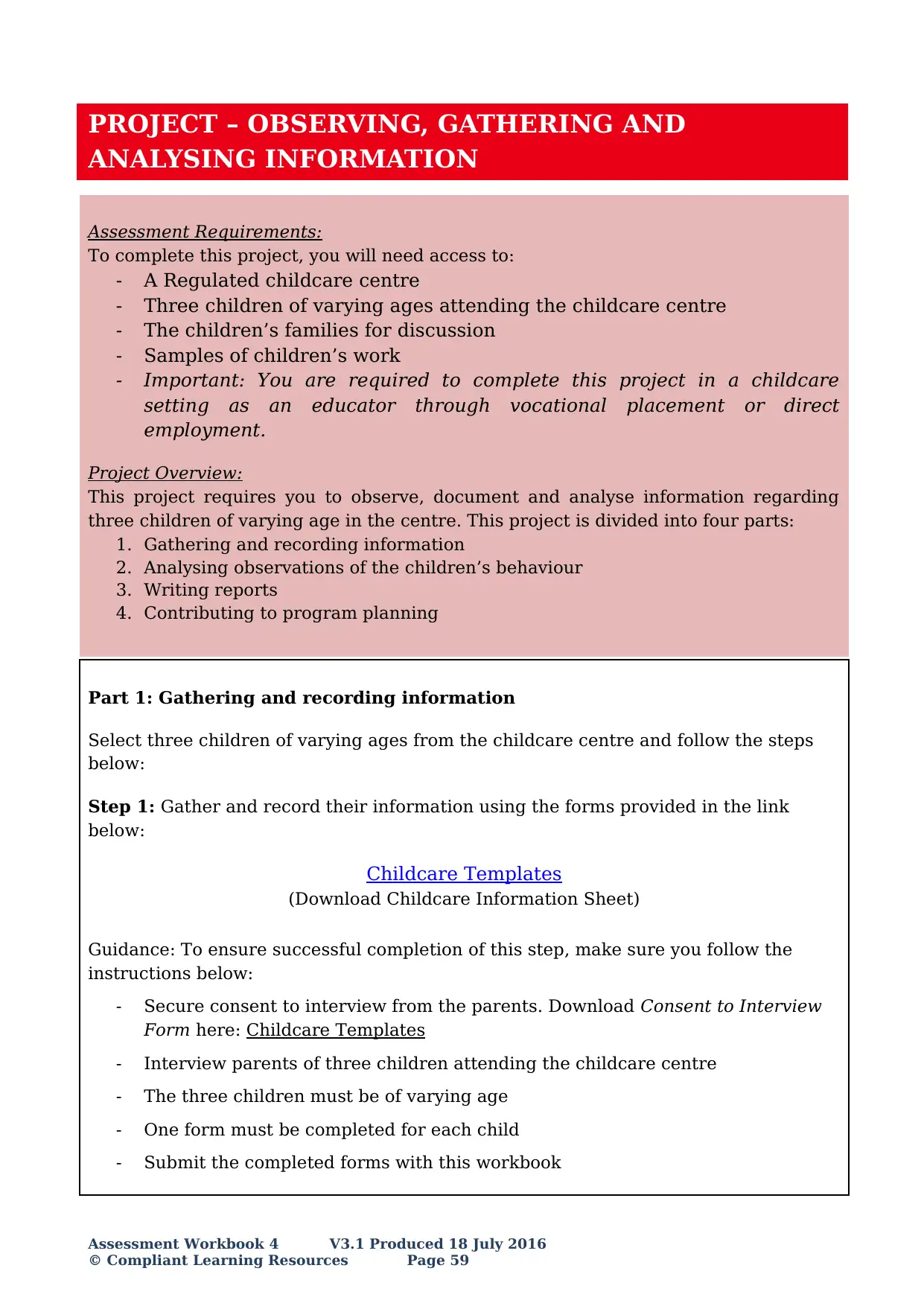
PROJECT – OBSERVING, GATHERING AND
ANALYSING INFORMATION
Assessment Requirements:
To complete this project, you will need access to:
- A Regulated childcare centre
- Three children of varying ages attending the childcare centre
- The children’s families for discussion
- Samples of children’s work
- Important: You are required to complete this project in a childcare
setting as an educator through vocational placement or direct
employment.
Project Overview:
This project requires you to observe, document and analyse information regarding
three children of varying age in the centre. This project is divided into four parts:
1. Gathering and recording information
2. Analysing observations of the children’s behaviour
3. Writing reports
4. Contributing to program planning
Part 1: Gathering and recording information
Select three children of varying ages from the childcare centre and follow the steps
below:
Step 1: Gather and record their information using the forms provided in the link
below:
Childcare Templates
(Download Childcare Information Sheet)
Guidance: To ensure successful completion of this step, make sure you follow the
instructions below:
- Secure consent to interview from the parents. Download Consent to Interview
Form here: Childcare Templates
- Interview parents of three children attending the childcare centre
- The three children must be of varying age
- One form must be completed for each child
- Submit the completed forms with this workbook
Assessment Workbook 4 V3.1 Produced 18 July 2016
© Compliant Learning Resources Page 59
ANALYSING INFORMATION
Assessment Requirements:
To complete this project, you will need access to:
- A Regulated childcare centre
- Three children of varying ages attending the childcare centre
- The children’s families for discussion
- Samples of children’s work
- Important: You are required to complete this project in a childcare
setting as an educator through vocational placement or direct
employment.
Project Overview:
This project requires you to observe, document and analyse information regarding
three children of varying age in the centre. This project is divided into four parts:
1. Gathering and recording information
2. Analysing observations of the children’s behaviour
3. Writing reports
4. Contributing to program planning
Part 1: Gathering and recording information
Select three children of varying ages from the childcare centre and follow the steps
below:
Step 1: Gather and record their information using the forms provided in the link
below:
Childcare Templates
(Download Childcare Information Sheet)
Guidance: To ensure successful completion of this step, make sure you follow the
instructions below:
- Secure consent to interview from the parents. Download Consent to Interview
Form here: Childcare Templates
- Interview parents of three children attending the childcare centre
- The three children must be of varying age
- One form must be completed for each child
- Submit the completed forms with this workbook
Assessment Workbook 4 V3.1 Produced 18 July 2016
© Compliant Learning Resources Page 59

Assessment Workbook 4 V3.1 Produced 18 July 2016
Page 60 © Compliant Learning Resources
Page 60 © Compliant Learning Resources
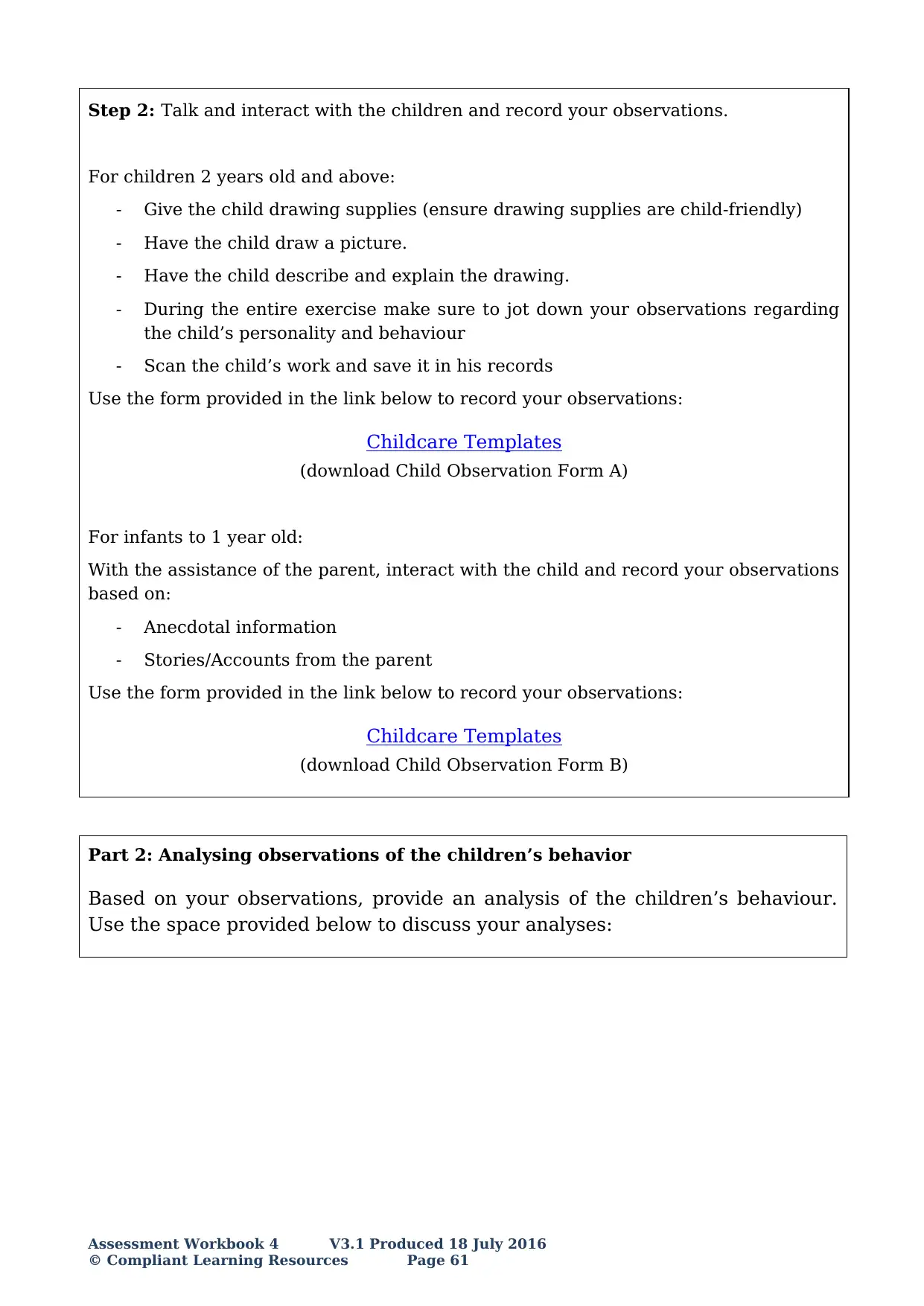
Step 2: Talk and interact with the children and record your observations.
For children 2 years old and above:
- Give the child drawing supplies (ensure drawing supplies are child-friendly)
- Have the child draw a picture.
- Have the child describe and explain the drawing.
- During the entire exercise make sure to jot down your observations regarding
the child’s personality and behaviour
- Scan the child’s work and save it in his records
Use the form provided in the link below to record your observations:
Childcare Templates
(download Child Observation Form A)
For infants to 1 year old:
With the assistance of the parent, interact with the child and record your observations
based on:
- Anecdotal information
- Stories/Accounts from the parent
Use the form provided in the link below to record your observations:
Childcare Templates
(download Child Observation Form B)
Part 2: Analysing observations of the children’s behavior
Based on your observations, provide an analysis of the children’s behaviour.
Use the space provided below to discuss your analyses:
Assessment Workbook 4 V3.1 Produced 18 July 2016
© Compliant Learning Resources Page 61
For children 2 years old and above:
- Give the child drawing supplies (ensure drawing supplies are child-friendly)
- Have the child draw a picture.
- Have the child describe and explain the drawing.
- During the entire exercise make sure to jot down your observations regarding
the child’s personality and behaviour
- Scan the child’s work and save it in his records
Use the form provided in the link below to record your observations:
Childcare Templates
(download Child Observation Form A)
For infants to 1 year old:
With the assistance of the parent, interact with the child and record your observations
based on:
- Anecdotal information
- Stories/Accounts from the parent
Use the form provided in the link below to record your observations:
Childcare Templates
(download Child Observation Form B)
Part 2: Analysing observations of the children’s behavior
Based on your observations, provide an analysis of the children’s behaviour.
Use the space provided below to discuss your analyses:
Assessment Workbook 4 V3.1 Produced 18 July 2016
© Compliant Learning Resources Page 61
Paraphrase This Document
Need a fresh take? Get an instant paraphrase of this document with our AI Paraphraser

Child 1
Name of Child: Age:
Did you identify any behaviour that will require special support for the child?
Yes | No
If yes, please explain:
Describe the frequency, intensity and duration of the behaviour of the child that requires support:
Describe an aspect of the child’s development as reflected by your observation:
Describe an aspect of the child’s knowledge, ideas, abilities and interests as reflected by your own observation:
Assessment Workbook 4 V3.1 Produced 18 July 2016
Page 62 © Compliant Learning Resources
Name of Child: Age:
Did you identify any behaviour that will require special support for the child?
Yes | No
If yes, please explain:
Describe the frequency, intensity and duration of the behaviour of the child that requires support:
Describe an aspect of the child’s development as reflected by your observation:
Describe an aspect of the child’s knowledge, ideas, abilities and interests as reflected by your own observation:
Assessment Workbook 4 V3.1 Produced 18 July 2016
Page 62 © Compliant Learning Resources

Child 2
Name of Child: Age:
Did you identify any behaviour that will require special support for the child?
Yes | No
If yes, please explain:
Describe the frequency, intensity and duration of the behaviour of the child that requires support:
Describe an aspect of the child’s development as reflected by your observation:
Describe an aspect of the child’s knowledge, ideas, abilities and interests as reflected by your own observation:
Assessment Workbook 4 V3.1 Produced 18 July 2016
© Compliant Learning Resources Page 63
Name of Child: Age:
Did you identify any behaviour that will require special support for the child?
Yes | No
If yes, please explain:
Describe the frequency, intensity and duration of the behaviour of the child that requires support:
Describe an aspect of the child’s development as reflected by your observation:
Describe an aspect of the child’s knowledge, ideas, abilities and interests as reflected by your own observation:
Assessment Workbook 4 V3.1 Produced 18 July 2016
© Compliant Learning Resources Page 63
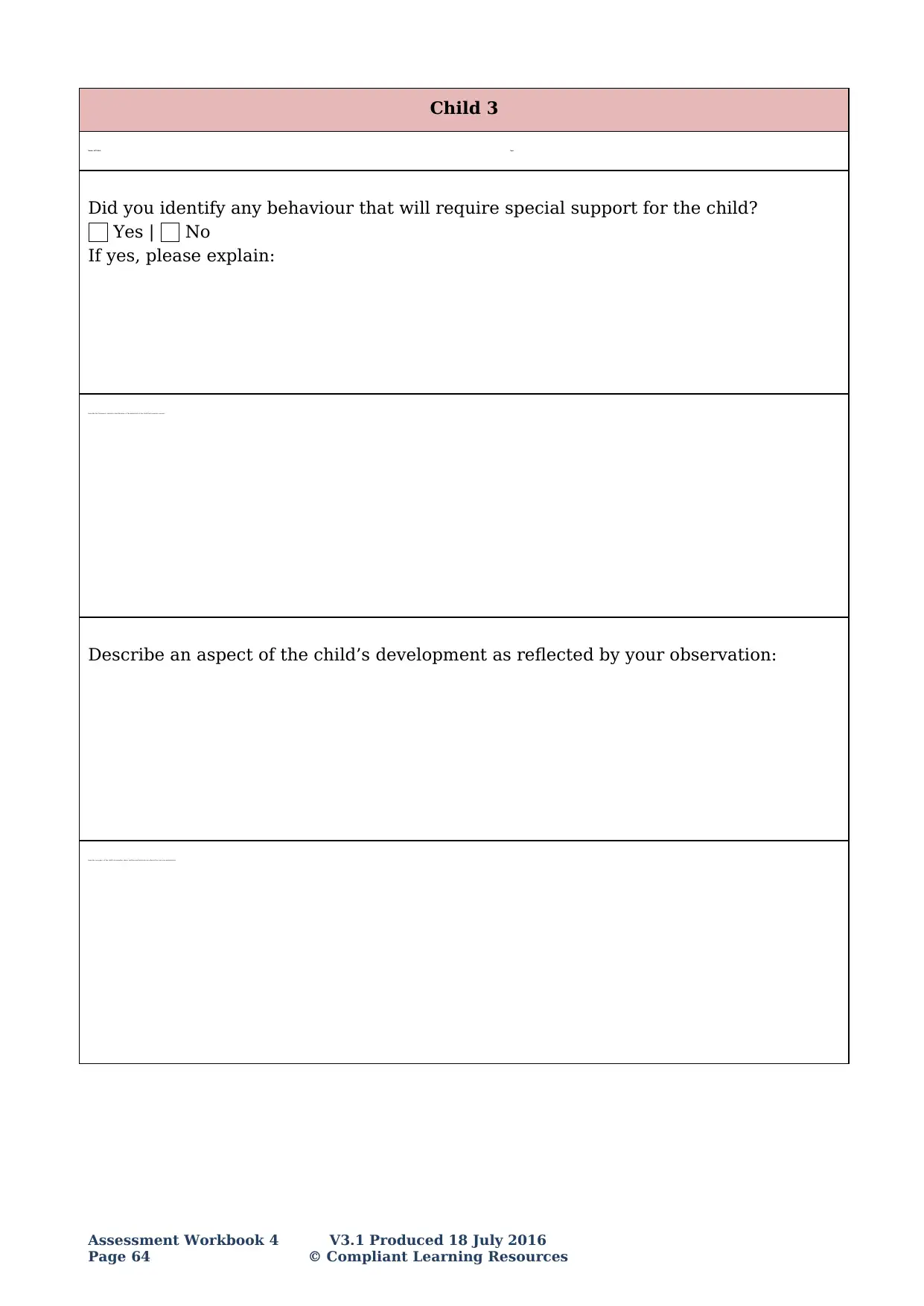
Child 3
Name of Child: Age:
Did you identify any behaviour that will require special support for the child?
Yes | No
If yes, please explain:
Describe the frequency, intensity and duration of the behaviour of the child that requires support:
Describe an aspect of the child’s development as reflected by your observation:
Describe an aspect of the child’s knowledge, ideas, abilities and interests as reflected by your own observation:
Assessment Workbook 4 V3.1 Produced 18 July 2016
Page 64 © Compliant Learning Resources
Name of Child: Age:
Did you identify any behaviour that will require special support for the child?
Yes | No
If yes, please explain:
Describe the frequency, intensity and duration of the behaviour of the child that requires support:
Describe an aspect of the child’s development as reflected by your observation:
Describe an aspect of the child’s knowledge, ideas, abilities and interests as reflected by your own observation:
Assessment Workbook 4 V3.1 Produced 18 July 2016
Page 64 © Compliant Learning Resources
1 out of 64
Related Documents
Your All-in-One AI-Powered Toolkit for Academic Success.
+13062052269
info@desklib.com
Available 24*7 on WhatsApp / Email
![[object Object]](/_next/static/media/star-bottom.7253800d.svg)
Unlock your academic potential
© 2024 | Zucol Services PVT LTD | All rights reserved.





